
|
|
Artist Index
Handbook of the Minneapolis Institute of Arts
With 143 Illustrations Joseph Breck and Henry Wehle 1917 Contents
Illustrations
THE MINNEAPOLIS SOCIETY OF FINE ARTS
[pg vi]
OFFICERS AND MEMBER OF THE BOARD OF TRUSTEES
TRUSTEESTERM EXPIRES 1918
TERM EXPIRES 1919
TERM EXPIRES 1920
TERM EXPIRES 1921
TERM EXPIRES 1922
EX-OFFICIO MEMBERS
PREFACEWhen the Institute was first opened, little more than two and one half years ago, the permanent collection occupied but a small part of the exhibition space. Since then the collection has increased in size and importance to an extent that warrants us, we feel, in publishing this illustrated handbook, which, although intended primarily for the use and convenience of visitors, at the same time may not be without interest as a record of accomplishment within so brief a period. This rapid development of our collection has been made possible, first of all, by the great liberality of numerous friends, but it has been facilitated by firm adherence to a well defined policy in respect to acquisitions. This policy is based on two cardinal beliefs. The first is that an art museum is of the greatest value to a community when its collections embrace both the major and minor arts of all countries and all times. The second is that the standard must be high. It would be idle to pretend that every object in our collection is a masterpiece of the highest order, but it is better to have an ideal, which may not be wholly realized, than to have none. Through the munificent bequest of William Hood Dunwoody, the Institute has had for its purchases the income of one million dollars. Several important paintings have come to the Institute through the bequest of Mrs. W. H. Dunwoody (Child with Cherries, Landscape with Cattle, Fording the River). In memory of their mother the late Mrs. Thomas Lowry, Mrs. Gustav Schwyzer, Mrs. Percy Hagerman and Horace Lowry have made a welcome gift of paintings and other works of art (Tapestry, Hunting Scenes, Large Embroidered Hanging, The Conversion, The Scouts). Among the numerous gifts must be instanced the Ladd Collection of Prints, the gift of an anonymous donor (see the Print Department chapter); the Charles Jairus Martin Memorial Collection of Tapestries, the gift of Mrs. C. J. Martin (Hunting Party with Falcons, Two Scenes from the Story of Esther, Joseph, Ruler over Egypt, Virgil Appearing to Dante); the Martin B. Koon Memorial Collection of Contemporary American Paintings, the gift of Mrs. C. C. Bovey and Mrs. C. D. Velie (Luxembourg Gardens at Twilight, The White Bridge, River in Winter, Garden in June, The Open Sea, The Yellow Flower, Night's Overture); the Bradstreet Memorial Collection of Japanese Art, the gift of Mrs. Elizabeth B. Carleton and Mrs. Margaret Kimball (The Bradstreet Room, Color Print by Yeizan, Carved Panel); and the Cast Collection, the gift of Russell M. Bennett (see the Cast Collection chapter). The Oriental collection has been enriched by a gift of Chinese porcelain from Mrs. E. C. Gale (Chinese Porcelain), and by a collection of Japanese paintings and other material from Charles L. Freer (Tiger). Valuable paintings and other works of art have been given by James J. Hill (Landscape, The Storming of Tel El Kebir, Napoleon's Retreat from Russia, The Roe Covert), Mrs. Frederick B. Wells (The Bath, Woodland Scene, River Scene, Mother and Children), James Ford Bell (Madonna with Saints), T. B. Walker, and others to whose generosity the Society of Fine Arts is greatly indebted. In the preparation of this handbook, I have been aided by Mr. Harry B. Wehle, Assistant to the Institute Staff, who is responsible for the notes on XIX Century and modern art. My part of the work, except for general supervision, has been confined to the earlier periods.
September 12, 1917.
JOSEPH BRECK, Director
THE MINNEAPOLIS INSTITUTE OF ARTS[pg viii]The Institute is maintained by the Minneapolis Society of Fine Arts, incorporated in 1883 for the purpose of promoting a knowledge and love of art in the community. The purpose of the Society found its first expression in a school of art, established in 1886 and for many years carried on in rooms in the building of the Public Library. Since November, 1916, the School has occupied its own building, the Julia Morrison Memorial Building, situated in the same Park as the Institute. From its inception, however, the members of the Society of Fine Arts had purposed establishing, in addition to the art school, a museum of art. In 1911 this hope suddenly began to take the shape of reality. In January of that year, Clinton Morrison offered as a gift to the Society the ten acre tract of land at Twenty-fourth Street between Stevens and Third Avenues, valued at $250,000, as a site for museum and school buildings, provided $500,000 should be secured for the erection of the museum. Immediately upon the announcement of Mr. Morrison's generous offer, William Hood Dunwoody, then President of the Society, promised $100,000 for the building fund. At a dinner held on January 10, 1911, approximately $250,000 additional was pledged by other public-spirited citizens, and by the end of the month the entire sum for building had been obtained. Plans for a building which could be constructed in successive units, to occupy eventually the entire tract, were prepared by McKim, Mead & White of New York. In August, 1912, the construction work was begun on the main unit, and late in 1914 the building was completed. The Institute was opened to the public on January 7, 1915. The present museum is about 325 feet long and 100 feet deep, and comprises approximately one-seventh of the entire plan. The total cost was $537,000. The construction is of brick, concrete, and steel, with a facade of white granite. The classical design of the building is considered exceptionally beautiful in its proportions and in the refinement of its details. There are two main exhibition floors. The First Floor contains sixteen exhibition halls and galleries, as well as the entrance hall, information office, check room, library and print-study. The Second Floor comprises thirteen galleries, ten of which are devoted to permanent exhibitions, one to exhibitions of prints, and two to transient exhibitions. On the Ground Floor are located the administration offices, the Trustees' room, toilets, women's rest room, lunch room, class room, shipping room and store rooms. For the purchase of works of art, the Society has the income from $1,000,000, the munificent bequest of William Hood Dunwoody, who died February 8, 1914. This fund can be used only for the purchase of works of art. For the maintenance of the Institute, the Society is dependent upon membership dues and upon a city tax levy of one-eighth of a mill. GENERAL INFORMATIONLOCATION. The Institute is located on East 24th Street between Stevens and Third Avenues. It can be reached easily from either the Nicollet Avenue or the Fourth Avenue car line. HOURS OF OPENING. The Institute is open to the public daily from 10:00 A.M. to 5:00 P.M. except on Sunday and Monday, when the hours are 1:00 P.M. to 5:00 P.M. ADMISSION. Admission is free on Wednesday, Saturday and Sunday; other days, a charge of twenty-five cents is made, except to members of the Minneapolis Society of Fine Arts, to school children accompanied by teachers, and to art students, teachers in the public schools, and special students holding annual admission cards, which will be issued upon application. INFORMATION DESK. Admission tickets, a public telephone, post cards and publications of the Institute may be found at the Information Desk (at the left on entering the building). Application should be made here to see any officer of the Institute. The use of a wheel-chair in the galleries may be obtained here without charge; when an attendant is provided, the charge is $1.00 per hour. EXPERT GUIDANCE. Visitors wishing docent service, or guidance through the galleries, should make application at the Information Desk. COPYING AND PHOTOGRAPHING. Application for permission to copy or photograph must be made to the Director. LUNCH ROOM. The lunch room is located on the Ground Floor at the west end of the corridor. Luncheon is served from 12:30 to 2:00; tea from 3:30 to 4:45. Closed during the summer. REST ROOM. The rest room for women is located near the lunch room. BULLETIN. The Institute publishes an illustrated bulletin monthly, October to June. It is free to members; subscription rate to non-members, $.75; single copies, $.10. ART SCHOOL. For information concerning the Art School apply to the Director, Minneapolis School of Art, 200 East 25th Street. MEMBERSHIP. The Minneapolis Society of Fine Arts offers, through its various classes of membership, the opportunity of sharing in the support of the Institute and School of Art and of enjoying the privileges afforded by the Society. Membership tickets are issued upon application to the Secretary at the Institute accompanied by membership fee. All classes of membership, except associate and club membership, entitle members to: (1) free admission, at all times when the Institute is open to the public, for themselves and members of their families and out-of-town guests; (2) invitations to all receptions given at the Institute by the Trustees; (3) free admission to all lectures and entertainments given under the auspices of the Society; (4) free guide service; (5) a subscription to the monthly Bulletin published by the Society. CLASSES OF MEMBERSHIP
PLAN OF THE FIRST FLOOR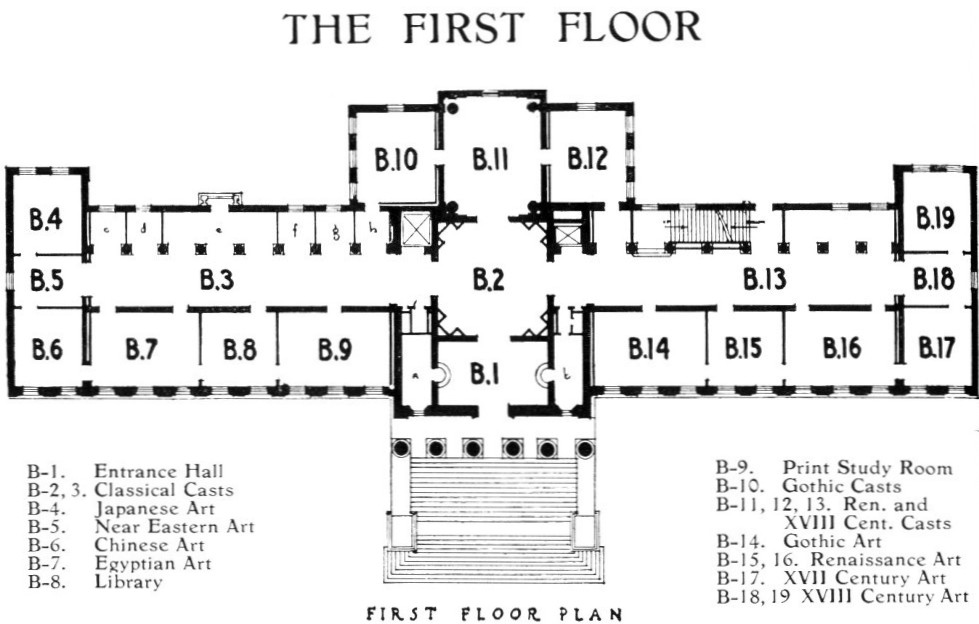
FIRST FLOOR PLAN.
Works of art earlier than the XIX century, the cast collection, and the Print Department are located on the First Floor. The visitor who wishes to make a general tour of the collections is advised to proceed from the entrance through the octagonal hall to the corridor at the left. At the end of this corridor is the entrance to the Oriental collections. The Egyptian collection in the adjacent gallery may then be visited. Returning to the corridor, the visitor will come to the Library and Print Study Room. (The Print Department will eventually be given space on the Ground Floor, and the galleries now occupied devoted to Greek and Roman art.) Casts of classical sculpture are exhibited in the corridor. The cast collection is continued in Gallery B-10 (Gothic art) and in Galleries B-11, 12, and the west corridor (Renaissance and later periods). Opposite the stairs to the Second Floor is the entrance to a series of rooms in which original examples of European art are exhibited according to period. The first gallery is devoted to Gothic art; the next two to Renaissance art; these are followed by the gallery of XVII and the two galleries of XVIII century art. The stairs opposite Gallery B-15 lead to the Ground Floor, where are the lunch room, women's rest room, toilets, class room, administration offices, and work rooms. PLAN OF THE SECOND FLOOR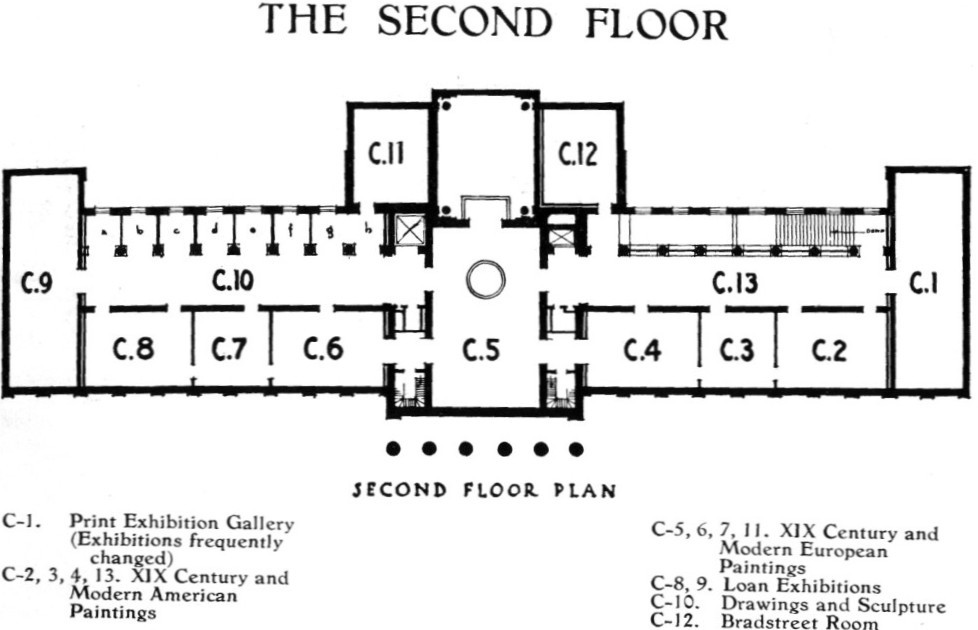
SECOND FLOOR PLAN.
Nineteenth century and modern works of art are exhibited on the Second Floor. On this floor are also the Print Exhibition Gallery and the Bradstreet Collection. The visitor is advised to enter the series of galleries through the Print Exhibition Gallery, C-1. From this room the visitor may proceed to the galleries in which paintings of the American and European schools are exhibited. Having completed the circuit along the north front of the building, the visitor may return by way of the corridors and galleries to the south (modern drawings and sculpture, the Bradstreet Room). Galleries C-8 and 9 are used for transient exhibitions, generally changed each month. [pg xii]THE FIRST FLOOR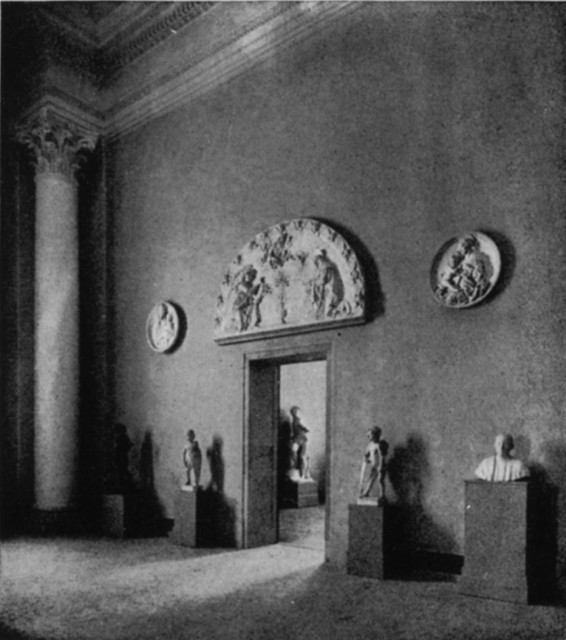
View of the South Hall. Renaissance Casts.
THE CAST COLLECTION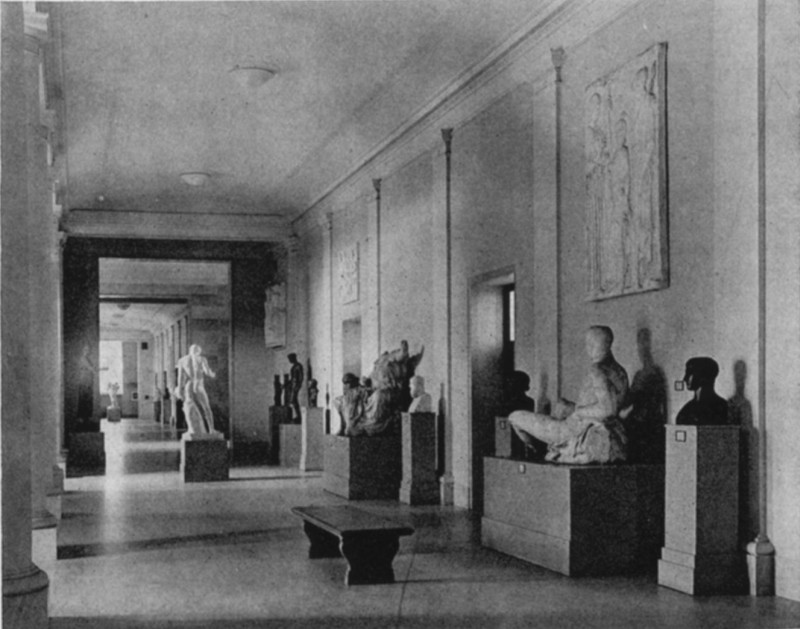
The East Corridor: Greek and Roman Casts
The cast collection is installed in Galleries B-2, 10, 11, 12 and the J corridors on the First Floor. To view the collection in chronological sequence, the visitor should proceed from the octagonal Gallery B-2 (V century Greek sculpture) down the north side of corridor B-3 (V century Greek sculpture). Returning, the visitor will find in the alcoves on the south side of the corridor casts of Greek sculpture of the IV century and Hellenistic periods, and casts of Roman sculpture. The collection is continued in Gallery B-10 (Gothic sculpture), which should be entered from the corridor. Casts of Renaissance sculpture are exhibited in Gallery B-1 (Early Renaissance, XV century) and Gallery B-12 (Late Renaissance, XVI century). Other casts of sculptures of the Renaissance and later periods are exhibited in the west corridor. The educational value of a cast collection is beyond question. Through these mechanical reproductions, it is possible to obtain a fairly adequate idea of the great masterpieces of sculpture, that are inaccessible to many, except in this form. In the plaster cast one may study proportions, composition, style and even technical procedure; but it must be remembered that the qualities of color and texture, which contribute so much to the effect of the original, are almost, if not entirely, lost in the plaster [pg 2] cast. This defect may be overcome in part by treating the plaster in various ways so that it conveys some suggestion of the original material. This has been done with our casts, adding materially to the attractiveness of the collection. In connection with the casts of Greek and Roman sculpture in our collection, the following notes on classical art may be of interest. As to the characteristics of Gothic and Renaissance art, the reader is referred to the notes on pages 31-32 and 47-48. A remarkable civilization (Minoan, Cretan, Aegean, or Prehellenic, as it is variously called), extending over a thousand years, preceded the classical period of Greek art. This earlier civilization was brought to an end by the so-called Dorian invasion at the close of the second millennium, and several hundred years had to elapse before conditions once again were right for the flourishing of art. Greece of the classical period begins to emerge towards the end of the VII century B. C. The Archaic Period (about 625-480 B. C.) was one of experimentation, preparatory to the age of perfection, when, technical difficulties having been overcome and aesthetic aims defined, Greek art attained an eminence never surpassed. Victorious at Salamis and Plataea, the Greek world arose triumphant from its struggles with Asia. The birth of national consciousness ushered in a new period of art, the Golden Age of Greece (480-400 B. C.). The conventions of the archaic style gave place to a free style, adequate to the sculptor's every need. Grace, simplicity, and truth in the representation of the living form characterize the sculpture of this period; draperies are rendered with marvelous skill. Liberal patronage was extended to the arts, particularly by the state. Under these favorable conditions, which reached their climax in the Age of Pericles (461-431 B. C.), Hellenic ideals of proportion, sanity and self-command found perfect embodiment in sculpture. From about the middle of the V century, Athens was the unquestioned leader in the field of art, her nearest rival, the ancient school of Argos. Among the great sculptors of the V century, three stand out in particular prominence: Myron, who excelled in the representation of bodily forms and action; Polyclitus, the sculptor of athletes and the exponent of academic perfection; and above all Phidias, the great genius of the age, who combined technical skill with the expression of lofty, spiritual ideals. In the next period, that of the IV century (400-323 B. C.) individualism began to dominate Greek thought and action, replacing the earlier civic and religious influences. Art became more individual and more emotional. Portraiture grew in favor. The austere style of Phidias gave place to the dreamy sentiment of Praxiteles, to the fiery passion of Scopas. The gods descended from high Olympus and walked the earth in human guise. The three great sculptors of this age were Praxiteles, Scopas and Lysippus. [pg 3]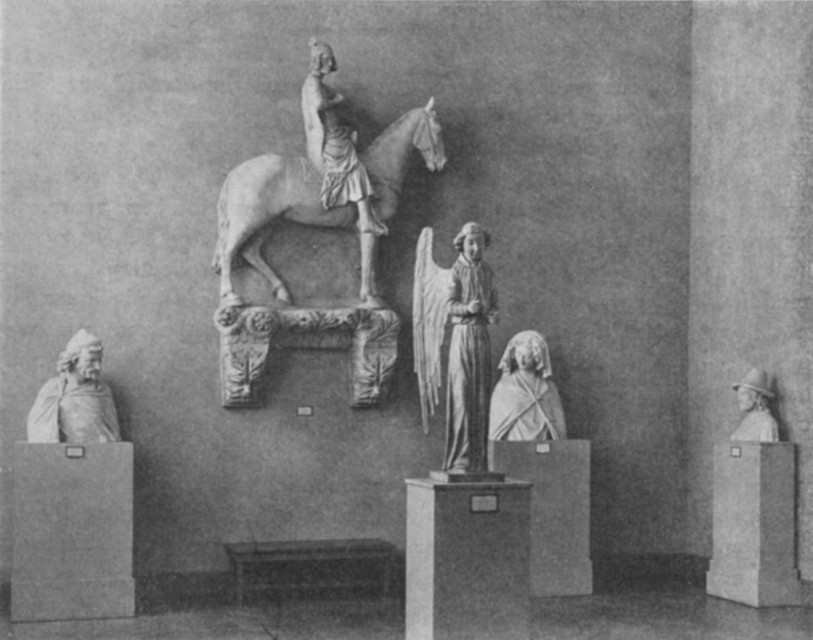
Gallery B-10: Gothic Casts
Sculpture of the Hellenistic Period (323-146 B. C.) shows a further development of tendencies already manifested in the preceding century. Individualism led to a vigorous development of portraiture and genre sculpture. Art ran the whole gamut of passion, from the bestial to the ideal, and this amplification of the emotional theme was accompanied by a wider range of subject material than had yet occurred. With these changes came a lowering of ideals. Spiritual emptiness, sensationalism, and lack of self-restraint are only too often characteristic of Hellenistic art. The chief centres of art in this period were not in Greece, but at Pergamon, Rhodes and Alexandria. The development of Roman sculpture was influenced, on the one hand, by native Italian realistic tendencies, and on the other, by the example of Greek sculpture. Not only were there in Rome numerous Greek sculptures to serve as models, but also many transplanted Greek artists, who had left their native land to seek employment in Italy. To the copies of famous masterpieces executed by these eclectic artists, it may be remarked, we owe our knowledge of many celebrated works of Greek sculpture, which otherwise would have been lost to us. In studying Roman art we note first one tendency, then the other, predominating, but neither is ever lost to sight. It is this dualism that gives to Roman art its distinctive character. [pg 4]THE PRINT DEPARTMENT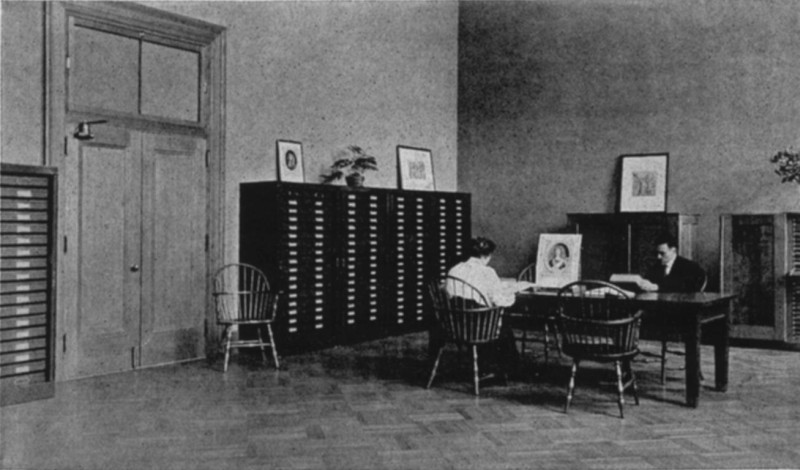
The Print Study Room
The Print Department occupies two rooms on the Main Floor (Print Study Room and Library) and a large exhibition gallery on the Second Floor. The collection, comprising over 5,000 prints, was the munificent gift to the Society in 1916 of an anonymous donor. The collection, formerly owned by William M. Ladd of Portland, Oregon, represents the work of years in collecting, and illustrates in a comprehensive way the history of the graphic arts. The strength of the collection lies in its splendid representation of the work of XIX century and modern etchers. In this respect it may be said to be second only to the famous Avery Collection in New York. The collection offers an exceptional opportunity for the study and enjoyment of a branch of art that is intimately related to drawing and painting and yet has distinctive qualities of its own. Selections of prints, frequently changed, are exhibited in the large gallery devoted to this purpose on the Second Floor. Prints not on exhibition are kept in the Print Study Room on the First Floor, to the left of the entrance. Visitors are welcome. The curator is glad to show any prints not on exhibition and to assist the student in every way possible. Adjoining the Study Room is the Library, where in addition to general reference books deposited by the Minneapolis Athenaeum, there is a valuable reference library on the subject of prints, which formed part of the former Ladd Collection. Students will also find useful a collection which is now being made of photographs and other reproductions of works of art. It is difficult, of course, to give any adequate idea in so brief a space of the scope of the collection, but the following comments may be of interest. Among the prints by the early masters, of the XV and XVI centuries, there are examples of the work of Martin Schongauer; a large group of 106 engravings and wood-cuts by the great German master, Albrecht Durer; some characteristic prints by the so-called “Little Masters,” Beham, Pencz, and Aldegrever; and a small group of engravings by the XV century Italian master, Andrea Mantegna. By Rembrandt, the outstanding figure in the graphic arts of the XVII century, we are fortunate in possessing 127 etchings, all of them good and many in brilliant impressions. Other engravers and etchers of the XVII century are well represented. Among the Dutch masters may be instanced Paul Potter, Ruysdael, A. van de Velde; among the French, Callot, Claude Lorrain, and the portrait engravers, Nanteuil, Morin and Masson. The XVII century group is an interesting one. We may note 34 etchings by Piranesi and an important collection of English mezzotints by McArdell, S. D. Reynolds, Earlom, Valentine Green, and others. As to modern etchers and engravers, the collection presents an [pg 5] embarrassment of riches. The masters of this period are finely represented. There are 34 etchings by Meryon; 103 etchings and lithographs by Whistler, including beautiful impressions of the Venetian and Amsterdam sets; 242 prints by Sir Francis Seymour Haden, a collection particularly interesting for the number of trial proofs and different states which it includes. There is a notable group of 242 etchings by Jacque, including a large number of rare early dry-points; an important collection of Millet's etchings and woodcuts; 124 prints by Buhot; 119 prints by Legros; 53 prints by Lepere; 156 prints by van Muyden; a characteristic group of lithographs by Fantin Latour; 90 prints by Storm van's Gravesande, including all his important plates; 32 examples of the work of M. A. J. Bauer. Turner's famous Liber Studiorum is represented by a nearly complete set, including 24 first states. The collection is rich in the work of contemporary British artists. There are, in addition to the large group of Hadens, 138 prints by Sir Frank Short; 72 prints by the Scotch etcher, D. Y. Cameron; and fine examples of the work of Muirhead Bone, Brangwyn, Strang, and other contemporary artists. Modern German work is represented by an interesting collection of etchings, woodcuts, lithography and color-printing. To conclude this brief summary of the European artists represented in the collection, we may mention the group of 20 etchings by the Swedish painter and etcher, Anders Zorn. Coming to the work of American etchers, we find a large group of prints by Joseph Pennell, including his Panama Canal lithographs; the complete work of D. Shaw MacLaughlan, down to about 1912; the almost complete work of Charles Platt; 55 prints by Stephen Parrish; and a representative group of dry-points by Mary Cassatt. [pg 6]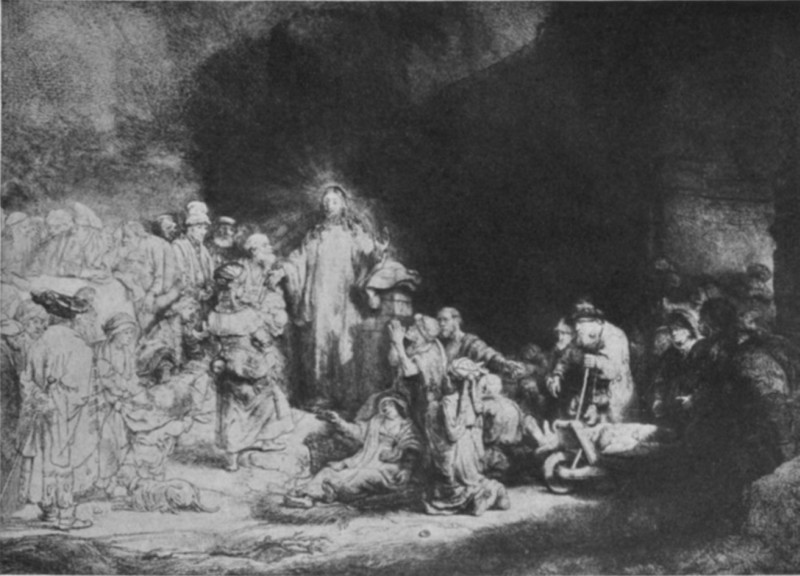
Christ Healing the Sick, Etching, Rembrandt, 1607-1669
This is a fine impression of the second state of Rembrandt's masterpiece known as The Hundred Guilder Print, so-called because it is supposed to have brought that price—a high one for the period—in Rembrandt's own time. Rembrandt is not only the greatest artist of the Dutch school, but also the greatest master of etching the world has ever known. The art of mezzotint engraving attained its highest development in England during the XVIII century. The English portrait painters were quick to recognize that the mezzotint process with its delicacy of tone and beautiful, velvety quality was admirably suited to the reproduction of their works. Reynolds is said to have employed, under his supervision, one hundred mezzotint engravers in the reproduction of his portraits. English mezzotints are well represented in our collection. 
Portrait of Sir Joshua Reynolds by Himself
Mezzotint by Valentine Green, 1739-1813 
The Breaking up of the Agamemnon. Sir Francis Seymour Haden, 1818-1910
The subject of this large etching is the breaking up of one of England's famous old ships of war, called the Agamemnon. Haden was not only a surgeon eminent in his profession, but also one of the greatest of English etchers. The revival of interest in etching during the XIX century in England was largely due to his efforts. Characteristic works of Whistler and Meryon are illustrated below. 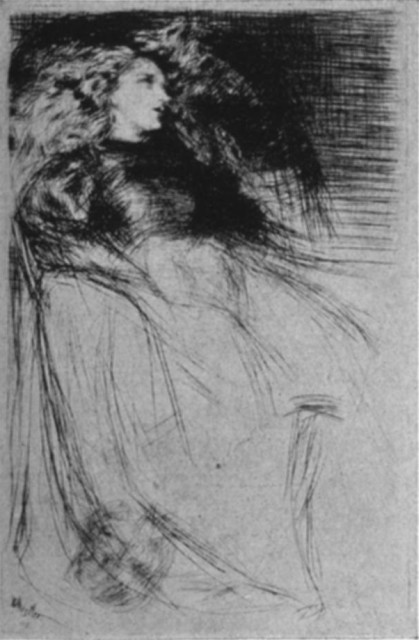
Weary, Dry-point, by James McNeil Whistler, 1834-1903
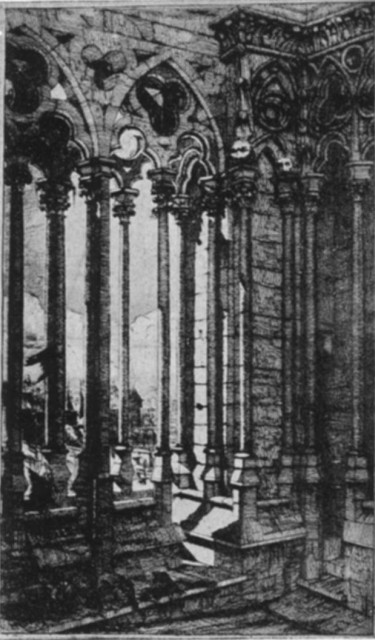
La Gallerie Notre-Dame, Etching by Meryon, 1821-1868

The Diggers, Etching (Third State), by F. Millet, 1814-1875
Our print collection is notably rich in the work of Millet. The etchings are all fine impressions, in some cases exceptional in quality. The collection also includes Millet's lithograph, The Sower, and his rare heliogravure, Maternal Precaution. Of the six wood-engravings drawn by Millet and cut by his brothers, three are represented in the collection. Millet was a thoughtful artist, to whom the spirit of things was at least as important as their visual aspect. His deep and sincere sympathy with the life of the peasant, to whose class he himself belonged, determined to a large extent his choice of subject. But Millet never descended to anecdotal trivialities; he avoided the pale sentimentality of such a painter as Jules Breton. His thought, like his technique, was virile, positive, honest. Millet was far above any trickery, either of thought or of execution. The very intensity of his intellectual interests led Millet to evolve a personal style that is distinguished by its simplicity and directness. As an artist, Millet is more allied to Durer than to Rubens. Color plays but a small part in his pictures. Significant, expressive line is the first essential of his art, and with this simple means he secures a surprising effect of plastic form. When color is added to outline, he is primarily interested in establishing accurately the values of the different planes. Both in his use of line and of mass, it is Millet's invariable practice to simplify, omitting everything that is not essential to his purpose. NEAR EASTERN ART
Plate, with Floral Design Asia Minor, XVI Century
The art of the Nearer Orient is the product of many races. The phrase covers in general the art of India, Persia, Syria, Mohammedan Egypt, Turkey, and even, in certain aspects, the art of Spain, Portugal and southern Italy. Although the development of this art was by no means uniform or along the same lines, the products are all related in style, which is unmistakable and distinct from other types of design. The most typical manifestation of this style would appear to have originated in Egypt about the time of the Mohammedan conquest in 638 A. D., and almost simultaneously in Syria and northern Persia. Since the Koran forbade the representation of any living creature, Mohammedan artists developed the so-called arabesque style, based on geometric and floral motives. This limitation, however, was not observed by the Persians, who introduced human and animal life into their designs with beautiful results. [pg 10]
Two Fragments of Bowls, Persian, Rhages, XIII Century. Left: Polychrome Decoration, Right: Lustred Decoration
The earliest lustred ware of Persia is that found in the ruins of the ancient city of Rhages. This prosperous city was destroyed in 1221 during the Mongol invasion. It may be assumed that most of the fragments found in the tumuli at Rhages date from the early years of the XIII century. Non-lustred pottery with polychrome decoration was also produced at Rhages during this period. The mosque doors, from Ispahan, illustrated on the opposite page, are particularly fine examples of Persian wood carving. The arabesque designs are especially beautiful. The inscriptions in the upper and lower small panels have been translated as follows: Panel, Upper Right: Oh God, do not indifferently drive me from your door. Panel, Upper Left: For if you do, there will be no other door open to me. Panel, Lower Right: Oh, my heart, do not be far off from the door of those who are sincere and faithful. Panel, Lower Left: Anyone who is far from the door is near to God. 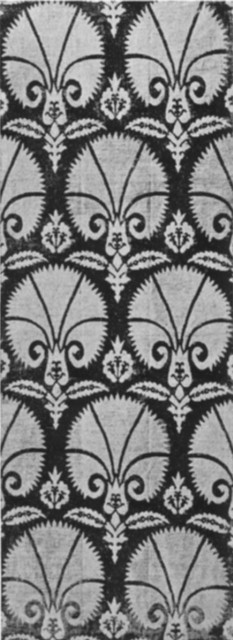
Velvet Brocade Turkish, XVI Century
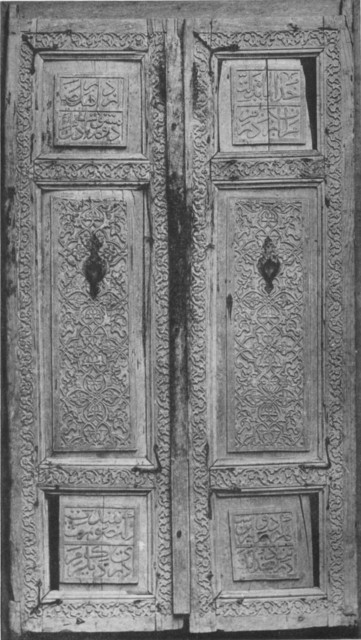
Mosque Doors, Carved Wood, Persian, about 1500
JAPANESE ART
Autumn, Six-fold Screen, by Yeitoku, 1543-1590
In the middle of the VI century of the Christian era, Buddhism was introduced into Japan by way of Korea. Through the vehicle of this new religion, Chinese art began to exert a fructifying influence upon the native art of Japan, which up to this time had achieved nothing worthy of mention. Chinese influence continued in succeeding ages a potent factor in the development of Japanese art. In the art of the Suiko (552-644), Hakuho (645-709), Tempyo (710-793), Jogan (794-899), and Fujiwara (900-1190) periods, the inspiration was largely Chinese, but more and more the native genius manifested itself in modifications of the spirit and technique. This evolution toward a distinctive national art and culture made considerable advances in the Fujiwara period, which ended in social revolution and the establishment of a military vice-royalty at Kamakura. The Kamakura period (1190-1337) is the feudal era of Japan. The spirit of individualism and hero-worship which distinguishes this age brought about a great development in portraiture, even the gods assuming a more individualized character. Battle scenes and the achievements of famous warriors and heroes were popular subjects. To overawe the populace, religious artists for the first time pictured the horrors of hell. Forceful delineation and the vigorous expression of action are characteristic of Kamakura art. Zenism, a metaphysical doctrine introduced from China to Japan in the Kamakura period, had a very great influence in the succeeding Ashikaga period (1337-1582) in shaping the course of art. The Zen sect of Buddhism, discarding ritual, sought salvation through self-concentration and meditation. Subjective idealism and the search of the inner spirit of things, fostered by Zenism, led the Ashikaga artists to practice a rigorous economy of means, eliminating color in general and all details not essential to the expression of the artist's idea. The search for the hidden beauty [pg 13] in all things was not confined to the major arts but led to the beautification of the humblest household utensils. In the ornamentation of sword guards the metal workers showed extraordinary ability. The Ashikaga era ended in turmoil. In 1582 Toyotomi Hideyoshi, a man of the humblest origin, brought order out of chaos, and became virtual ruler over a unified Japan. 
Winter, Six-fold Screen, by Yeitoku, 1543-1590
Under the patronage of Hideyoshi and his ennobled generals, the sober refinement of Ashikaga art gave way to gorgeous decoration, resplendent with gold and brilliant colors, that shows the influence of the mature Ming style of China. The leading artist of this period in Japan was Yeitoku (1543-1590), who with his numerous pupils painted sumptuous decorations for the palaces of the wealthy nobles. By Yeitoku are the two large screens illustrated above. This artist created perhaps the greatest purely decorative style of painting that the world has ever known. After the death of Hideyoshi in 1602, Iyeyasu founded the Tokugawa Shogunate (1603-1867). During the long “Tokugawa peace” various schools of art developed. Koetsu (d. 1637) and his great followers, Sotatsu (middle XVIII century) and Korin (d. 1716), established the so-called Korin school, seeking to combine the rich coloring of pre-Ashikaga days with the bold treatment of the Zen school. Kano Tanyu and his followers attempted to return to the purity of the Ashikaga masters, but met with only partial success. Patronage was largely in the hands of a prosperous middle class who demanded something more easily understood than the aristocratic art of the earlier periods. To meet this demand a more democratic school arose, and many gifted artists through their paintings of popular festivals and other familiar scenes prepared the way for the Ukiyo-e, or school of common life. Under the inspiration of this popular school, the art of printing in colors from wood blocks was brought to a high state of perfection. Little original work of any importance has been produced in Japan since the Restoration in 1868. 
Tiger, Attributed to Sesshu, 1420-1506. After a Design by Yen-Hiu, 1082-1135. Gift of Charles L. Freer

Covered Box, Cloisonne Enamel. Japanese, XIX Century. Decorated in the Old Korean Style.
CHINESE ART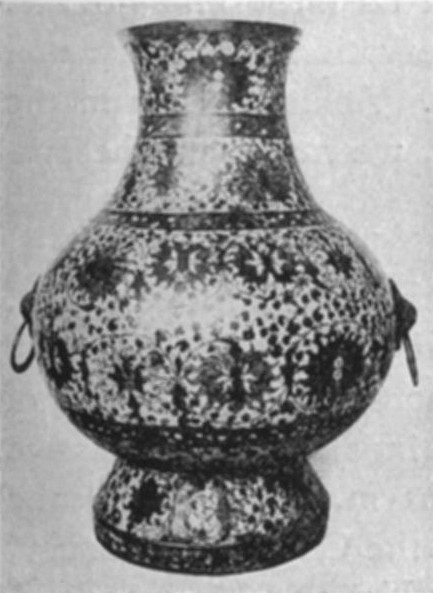
Cloisonne Vase Chinese, Ming Dynasty
The study of ancient Chinese art is attended by discouraging uncertainties. Only a few bronzes, jades, and possibly a small quantity of pottery, have survived to testify to the early development of art in China. To add to the difficulty, the exact dating of this material is at best only tentative. But whether the most ancient of these bronzes and jades are to be attributed to the Shang Dynasty (1766-1122 B. C.) or, with more probability, to the succeeding Chou Dynasty (1122-255), the technical skill which they display postulates so long a period of preparation that the origins of Chinese art must be referred to a past too remote for our present discernment. With the Han Dynasty (B. C. 206-221 A. D.), we find ourselves on surer ground, since many works of art of various kinds and materials, and unquestionably of this era, have come down to us. Not only bronzes and jades but also pottery and sculpture bear witness to the flourishing art of this period. During the Han Dynasty, probably in the first century of our era, Buddhism reached China from India. It does not appear, however, to have exerted much influence upon the arts until about the V century. The Han Dynasty was followed by a succession of shorter reigns known as the Three Kingdoms and the Six Dynasties. Early in the VII century, the great house of T'ang (618-907) came to power, and for three hundred years held sway over a vast empire. It was the period of China's greatest external power; the period of her greatest poetry; and of her grandest and most vigorous, if not, perhaps, her most perfect art. The surviving works of art of this era are far from numerous, but they are sufficient to warrant the belief that China, except in the field of ceramic art, rarely if ever surpassed the achievements of this golden age. Chinese Buddhist sculpture attained its noblest development in the T'ang period. As to T'ang painting—unfortunately, surviving examples are of the utmost rarity—it is characterized by austere beauty and spiritual elevation. Admirable also are the productions of the metal worker, the weaver, and the potter. A short period of half a century succeeded the fall of the T'ang Dynasty. We come then to another of the great periods of Chinese civilization, that of the Sung Dynasty (960-1280). From now on, surviving monuments permit us greater certainty in studying the continuous development of Chinese art. Under the Sung emperors we find a complex civilization marked by luxury of living, refinement and elegance of [pg 16] taste. These characteristics are reflected in the arts. Although religeous painting was largely practiced, Sung artists show a predilection for landscape and for subjects allied to landscape, such as birds and flowers. Exceptional qualities of poetic imagination, observation of nature and technical proficiency characterize these paintings. Achievements in the field of minor arts are conspicuous; in particular, we may note the productions of potters. The Sung Dynasty was succeeded by that of the Mongol invaders who founded the Yuan Dynasty (1280-1368). With the art of this period, the decline begins. The Mongols were followed by a native dynasty, the Ming (1368-1644), under whom the art of porcelain making began to progress rapidly toward perfection. Ming paintings show an excessive refinement, an elegance that is not without its charm, but they lack the nobility and spirituality of the earlier periods. In the Ch'ing, or Manchu, Dynasty (1644-1912), under the Emperors K'ang Hsi and his grandson, Ch'ien Lung, the art of porcelain manufacture and decoration reached its apogee. Today, after forty centuries of liberal harvest, the art soil of China would seem to be sterile and abandoned. THE CHINESE DYNASTIES
[pg 17]
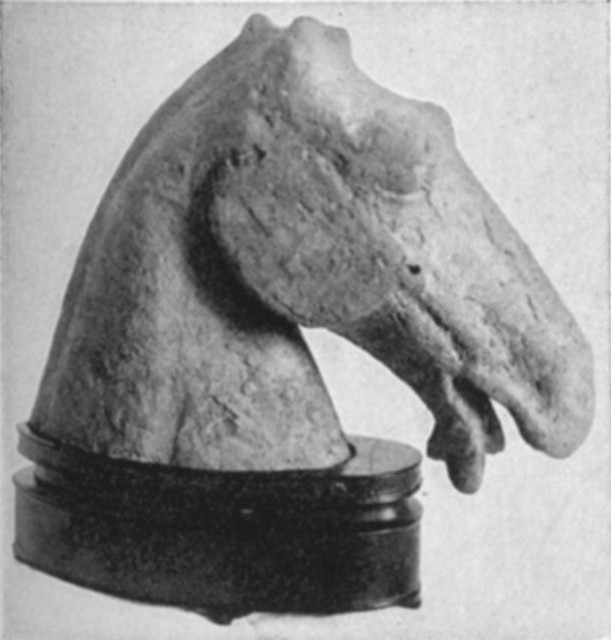
Horse's Head. Han Period
The early Chinese believed in the resurrection of the physical man, and only after many centuries did the idea of mere spiritual survival vaguely supplant the earlier superstition. To minister to the needs of the dead the Chinese of the Han period (206 B. C.-221 A. D.) stocked their tombs with jars containing wine and pickled meats, with articles of jade, with clothes, mirrors and weapons. To these were added costly treasures, furniture, chariots, live animals; even immolation of relatives and retainers was practiced in early times. As the conception of spiritual survival gradually replaced that of bodily life after death, simulacra of the objects used in life came to be substituted in burial for real objects. To this class belongs the horse's head, illustrated on this page, intended to take the place of a living sacrifice. The material is a soft grey earthenware, covered with a layer of buff clay, perhaps an original slip or perhaps an adhering soil incrustation. The modeling of the head, which has been made from a mould, combines a close study of nature with monumental elimination of the non-essential. Designs of the period engraved on stone show a similar enthusiasm for the horse and a similar method of treatment, the interest being in the decorative and linear aspect more than in the realistic and plastic. 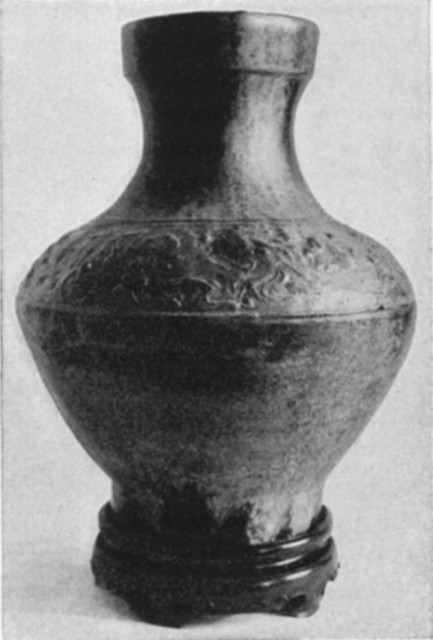
Mortuary Vase. Han Period
The vase is a typical piece of mortuary pottery of the Han period. It is made of hard reddish clay covered with a thick translucent green glaze, in parts become iridescent. The form is derived from an earlier bronze type; the simulated rings which originally formed the handles of the earlier type of vessel should be noted. The vase is decorated with a band of hunting scenes and animals, real and fabulous, modeled in low relief. [pg 18]
Painting On Silk by Ma Yuan
During the Sung dynasty, a period of highly developed civilization landscape painting occupied the attention of the greatest artists. Wearying of the complexity of life, men of culture turned with eager desire to the peace and solitude of nature. This love of nature finds beautiful expression in the paintings of Ma Yuan, one of the three greatest landscape painters of the period. By this artist, who flourished in the latter part of the XII century and the first part of the following century, is the large kakemono painted in monochrome on silk, which is illustrated opposite. The subject is the meeting between the Taoist teacher, Lee Erh, and his disciple, Ying Hai, on the mountain Wah Shan, one of the five largest mountains of China. Characteristic of the period is the loftiness and simplicity of the style, an austerity tempered by the serene and silent joy of the true lover of nature. Irrelevant details are omitted; only those which are significant expressing the artist's mood in contemplation of nature are recorded. 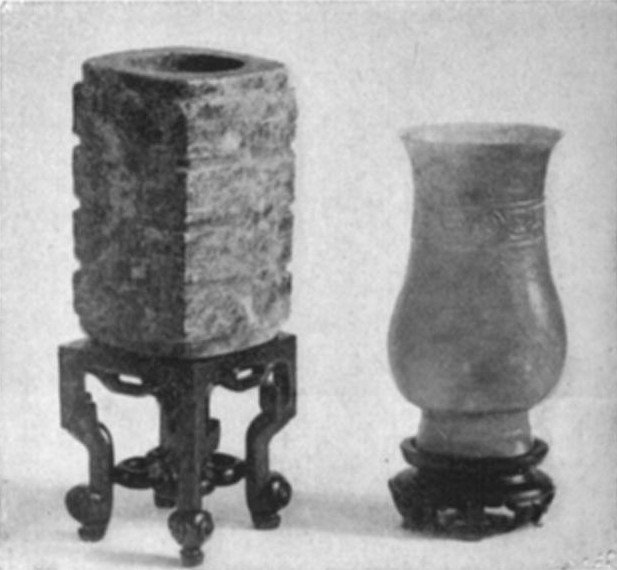
Ancient Chinese Jades
The earliest Chinese religion was essentially astronomical and cosmic. Heaven, earth, and the four quarters were the six cosmic powers worshiped as deities. The symbol of earth was a yellow jade “tube” or hollow cylinder, round inside and square outside, with a short, projecting neck at either end. The earth was thought of as round in its interior and square outside. The jade earth “tube” or “huang t'sung” in our collection is a very ancient piece, possibly dating from the Chou period (1122-255 B.C.). To the Sung period (960-1280 A. D.) may be assigned the beautiful jade reproduced in the illustration, although the type is reminiscent of Han productions. [pg 19]
Painting attributed to Pien Chin-Stan
Attributed to Pien Chin-Stan, an artist of the Yuan period (1280-1368), is the painting of birds and flowers reproduced on this page. The mellow harmony of the colors is particularly delightful. Exquisite sensitiveness to beauties of line and form, combined with loving observation of nature, distinguishes the drawing. Although paintings of the Yuan period, generally speaking, are inferior to the Sung, lacking the spiritual qualities that characterize the earlier period, in such work as this the great traditions of Chinese painting are worthily continued. To appreciate Chinese painting one must rid oneself of the mistaken idea, so common to Occidentals, that a work of art depends for success upon its “likeness” to nature. Petty imitation of the appearance of things plays no part in Chinese painting. It is the expression in terms of beauty of the inner and informing spirit, rather than the outward semblance, that constitutes the aim of the Chinese artist. 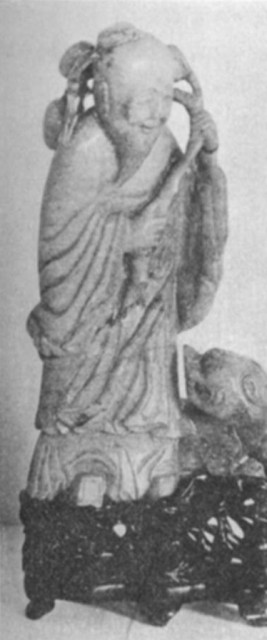
Tung Fang So. Jade
From remote antiquity, jade has been highly prized by the Chinese as the most precious of precious stones. In the ornamental carving of this beautiful mineral, the Chinese may justly claim pre-eminence. The little statuette here reproduced represents one of the Chinese immortals, Tung Fang So, who carries the peaches of longevity. The jade is light greyish-green in color. The carving probably dates from the late Ming period. [pg 20]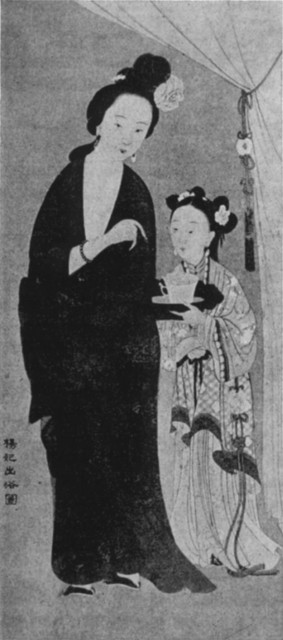
Princess Yang. Ming Period
This painting represents Princess Yang Kwei-Fei, the celebrated favorite of the Emperor T'ang Huan Tsung, returning from her bath. It is an excellent example of the Ming period (1368-1644 A. D.), lovely in color, distinguished by courtly elegance and refinement of drawing. It has been attributed to Yiu Kiu, also named Tze-Kiu. The daughter of a petty functionary, the Princess Yang became in 735 A. D. one of the concubines of the Emperor's eighteenth son. Her surpassing beauty and accomplishments won the affections of the Emperor himself. So great was her ascendancy over this weak voluptuary that the Imperial favorite was treated by the court with demonstrations of respect that justly appertained to none save the Empress Consort; members of her family were raised to high office; and no outlay was spared in gratifying the caprice and covetousness of the Princess or her relatives. It is not surprising that a rebellion resulted. During the flight of the court in 756 A. D. the Imperial guard revolted, and the Emperor was constrained to order the Princess Yang to be strangled. 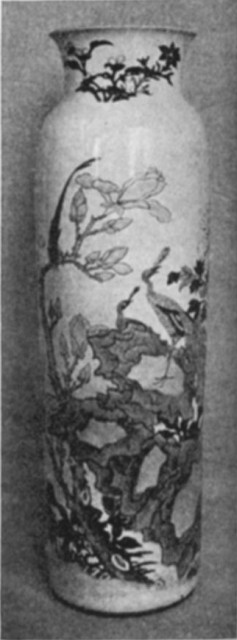
Vase. Ming Period
The porcelain vase is decorated in five colors on a white ground with a design showing a peacock, a phoenix and smaller birds among rocks, foliage and blossoms. It is a characteristic and fine production of the late Ming Period (1368-1644). Altogether admirable is the way in which the design, drawn with great freedom and boldness, is adapted to the shape of the vase. The colors are skillfully harmonized; the beautiful blue should be particularly noted. [pg 21]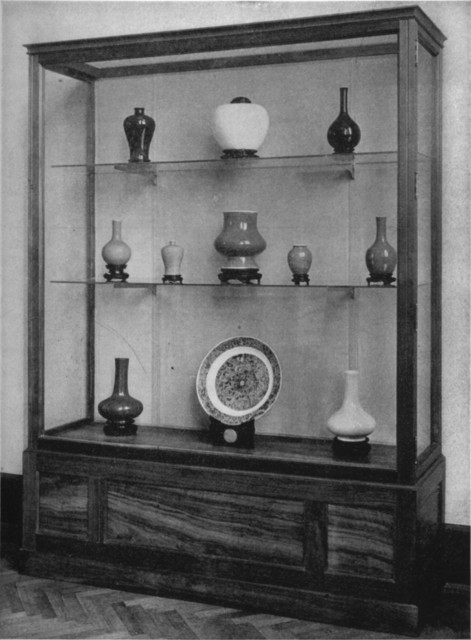
Chinese Porcelain of the XVII and XVIII Centuries
Apple-green, ashes-of-rose, mirror-black, camellia-green, lemon-yellow, and celadon are some of the beautiful glazes exemplified in this group of remarkable “solid-color” porcelains dating from the reigns of K'ang Hsi, Yung Cheng and Ch'ien Lung (second half of XVII century and the XVIII century). The large plate is a fine piece of K'ang Hsi decorated porcelain. Most of the pieces in this case were formerly in the celebrated Morgan Collection. Gift of Mrs. E. C. Gale. EGYPTIAN ART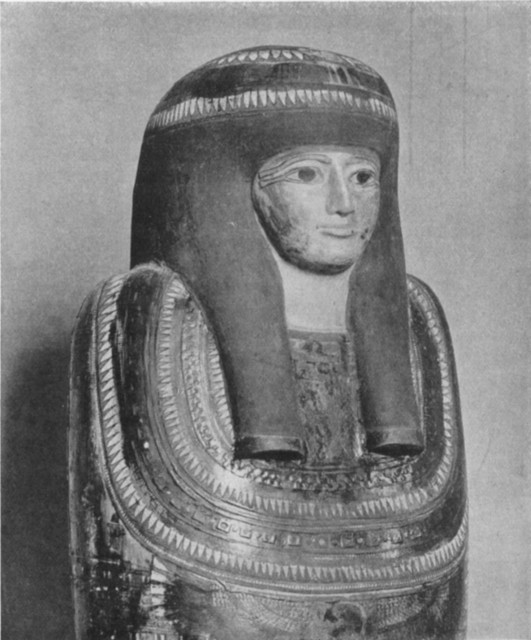
Detail of the Cartonnage Enclosing the Mummy of the “Lady of the House, Tesha”. Dynasty XXII-XXV
The Egyptian collection, purchased from the Drexel Institute, includes over seven hundred objects, ranging from sculpture and painting to furniture and utensils of daily life. It affords an adequate illustration of the conditions under which art flourished in the ancient land of the Nile, and of the characteristic forms of art expression which were evolved to meet these conditions. After monumental architecture, the system of decoration evolved by the Egyptians is perhaps their greatest contribution to the world's art. A few characteristics of Egyptian painting and sculpture may be noted. Color is used in flat areas without gradation and effects of light and shade. [pg 23] In drawing, outline is the principal mode of representation. Various conventions originating in the primitive stages of art, such as the representation of the human body with head and legs in profile and the shoulder to the front, became traditional and were continued with little change throughout later periods. These conventions, however, did not prevent the artist in the more vigorous periods of Egyptian art from noting with great keenness of observation many truths of nature. This curious conflict between realistic observation and conventional means of representation is characteristic of Egyptian art. In free-standing sculpture, the variety of postures was limited to a few unvarying poses. On the whole, in the figurative arts, types and subjects remain unchanged throughout Egyptian history, although from time to time the informing spirit was different. This immutable character of Egyptian art is thoroughly consonant with the idea of duration which was so strongly a controlling factor in Egyptian life. We cannot consider here the manifold ramifications of Egyptian religious belief, but one central tenet—that existence continued after death—must receive some attention, since this belief in the after-world explains many features that might otherwise be puzzling. The tomb, for example, was thought of as the real dwelling house, “the eternal house of the dead”; the houses of the living were merely “wayside inns.” As a result, domestic architecture was inconsequential; all efforts were concentrated on the construction and decoration of tombs and temples. 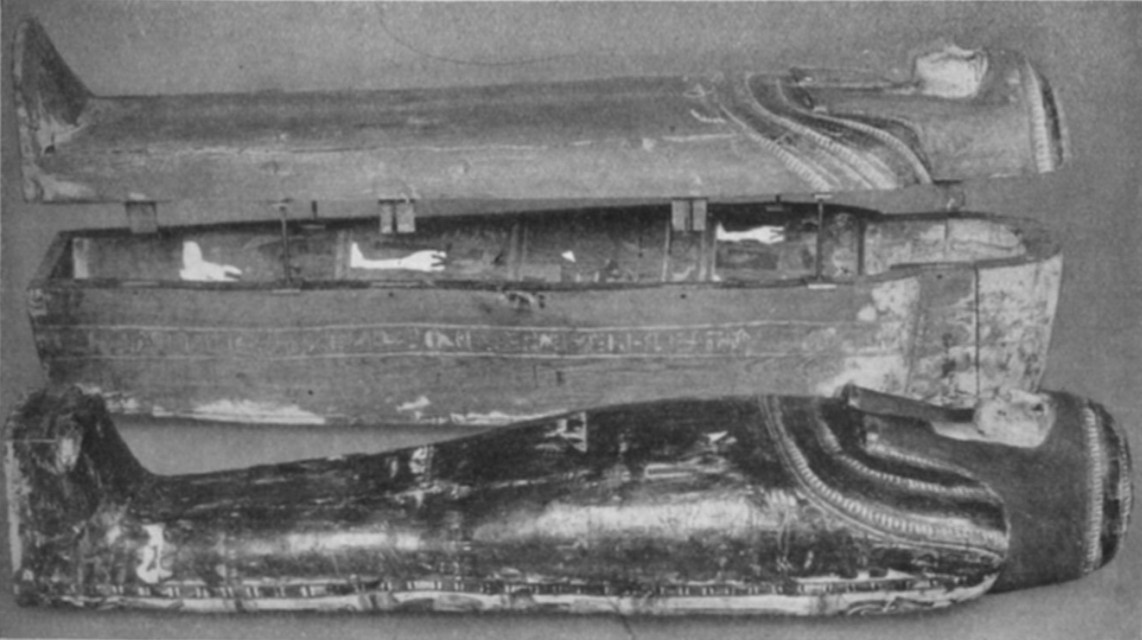
Coffin and Mummy of the “Lady of the House, Tesha” From Thebes, Dynasty XXII-XXV.
The mummy is enclosed in a cartonnage, made of many layers of linen held together by plaster, elaborately decorated by inscriptions and figures of the gods. The anthropoid coffin is made of wood, and is also richly decorated. Tesha was the daughter of the Doorkeeper of the Golden House (or Treasury) of Amon at Thebes. [pg 24]It was believed that man was composed of different entities each having its separate life and function. First, there was the body itself; then, the Ka or double—the ethereal projection of the individual, corresponding in a way to our ghost. Two other elements were the Ba or soul and the Khu or luminous spark from the divine fire. Each of these elements was in itself perishable. Left to themselves, they would hasten to dissolution, and the man, as an entity, would be annihilated. This catastrophe, however, could be averted through the piety of the survivors. The decomposition of the body could be prevented, or at least suspended, by the process of embalming; prayers and offerings saved the other elements from the second death and secured for them all that was necessary for the prolongation of their existence. The influence upon the arts of these religious beliefs is interesting to note. Scenes of harvesting, hunting, and similar episodes connected with the offering of food were painted or carved upon the tomb walls, generally for an utilitarian purpose. Through the recitation of prayers and magic formulae, the pictured semblances of food became reality and saved the hungry Ka from annihilation in case actual offerings should fail him. In the same way, portrait statues were placed in tombs to provide a semblance of the deceased to which the Ka could return were the actual body destroyed. These instances are perhaps sufficient to show us how closely art was related to religion in ancient Egypt. CHRONOLOGICAL TABLE
[pg 25]

Lower Part of Coffin. Dynasty XXI
The exterior of this wooden coffin is decorated with figures of gods and minor divinities in shrines, alternating with invocations to various divinities. The most interesting scene is that next the foot on the right side, showing the goddess Hathor in the form of a cow. Beside her is a suggestion of the Theban cliffs and the open door of her shrine, which was hewn in the mountain side. This very shrine was discovered on February 7, 1906, and in it intact was a life-size cult statue of Hathor as a cow. Hathor was supposed to receive the setting sun and to welcome the dead on the brink of the next world. The decoration of the interior of the coffin is bolder and more highly colored than the exterior. On the floor may be noted the large standing figure of Osiris of Busiris. Various divinities are represented surrounding him. On the sides of the coffin are three registers containing each three mummiform figures with human or animal heads; at the top is the soul of the deceased, represented as a human-headed bird. This coffin doubtless comes from Thebes. The absence of the cover makes it impossible to determine the ownership. The coffin was perhaps originally decorated in advance for a woman's burial, and held in stock for any burial. In one place, however, a man's titles are given, although the name is not recorded, so that possibly, before the decoration of the coffin was completed, it was adapted to the use of a man. 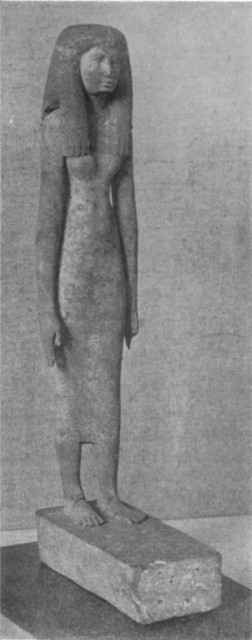
Statuette, Wood. Dynasty XII
Standing figure of a woman, carved in wood, with traces of painting; found at Deir; a fine example of carving in Dynasty XII. An inscription on the base may be read: “Funerary offerings, beef, fowl (?), things (?), good and pure for the honorable Kai.” Doubtless a portrait statue. The pose, with one foot advanced and the arms held stiffly at the sides, is a familiar one in Egyptian art. Note costume details: the thick wig and the tight dress supported by two shoulder straps. 
Goddess Neith, Bronze Dynasty XXVI
This bronze statuette represents the Goddess Neith wearing the crown of Lower Egypt; probably of the Saite period. An excellent example of votive bronzes, of which there is a considerable number in the collection. These statuettes probably served as votive or propitiatory offerings; that is to say, they were offered at shrines in gratitude for favors experienced or in the hope of winning favors to come. [pg 27]
Funerary Papyrus
Fragment of the funerary papyrus of the Priest of Amon, Jekhonsefonkh; part of a scroll buried with the deceased for his instruction in the afterworld; Dynasty XXI. 
Ushabti, Wood
Ushabti, Dynasty XIX (?), part of the burial equipment of “The Lady of the House, the Chantress of Amon, Aay.” Ushabtiu were placed in the tomb to answer for the deceased when called upon to labor in the afterworld. The inscription reads: “To illuminate the Osiris, the Lady of the House, Aay, beatified in peace. He says: O this ushabti, if one be drafted to do all the labors which are performed in the underworld—the Osiris, the Lady of the House, Aay, beatified, in peace—to cultivate the fields, to irrigate the banks, to carry the sand of the east to the west, behold, there will be smitten down ...” Here the text, which is part of Chapter VI of the Book of the Dead, breaks off because the available space was filled. It omits final instructions to the ushabti to reply, should the deceased be drafted, “Behold, here am I!” and thereupon relieve the deceased Lady of the House of the onerous task of laboring in the fields. 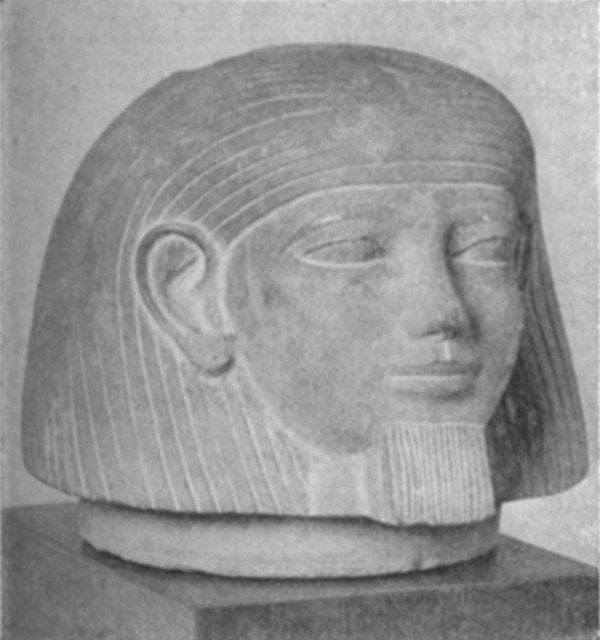
Cover of a Canopic Jar, Terracotta
Cover of a canopic jar used in the burial to contain the human viscera; if not earlier than the Empire period, to which it is attributed, it represents the genius Amset. [pg 28]
Group of Egyptian Alabaster Vessels
From left to right: spherical vase, Early Dynastic; kohl jar used to contain antimony or other preparations for the eyes, Dynasty XII or XVIII; the three vessels following are of the Empire period, Dynasty XVIII-XIX. 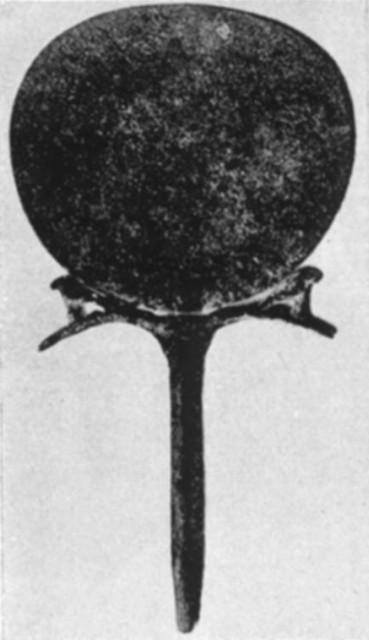
Bronze Mirror
Bronze mirror, originally highly polished, probably of the Ptolemaic period. Note the lotus column serving as handle and the two sacred falcons at the side of the handle. The sacred falcon below is a charm or amulet of the XII or XVIII Dynasty in polished gray stone. 
Amulet
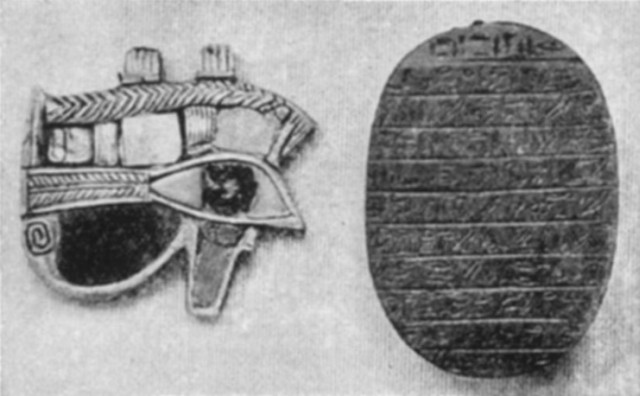
Sacred Eye and Scarab
Heart scarab, Dynasty XX or later. Inscription is a prayer from the Book of the Dead, adjuring the heart, over which the scarab was placed, not to bear false witness against the deceased at the time of judgment. The Horus eye is a beautiful piece of faience inlaid with stone and glass, probably of Dynasty XIX. ANCIENT ARTExcept for Egyptian material, the representation of ancient art in our collections is unfortunately limited to comparatively few original examples. These include, however, an interesting group of Cypriote pottery (duplicate material from the Cesnola Collection) which has considerable importance from the archaeological as well as from the artistic point of view. This collection of pottery from the island of Cyprus shows an almost unbroken succession of styles from the Early Bronze Age, about 3000 B. C., down to the Roman period, and thus gives us a complete picture of the art of pottery in an important center of ancient civilization for about three thousand years. Artistically, it is probably the most successful product of the Cypriote artist. His sense of form and decoration could here find full expression without disclosing the lack of high artistic inspiration, which is apparent in his sculptural creations. Moreover, a certain fanciful originality which shows itself now in a fantastic shape, now in the addition of handles and bosses in unexpected places, gives to his vases a refreshing variety. The interest of this collection will be greatly increased when we are able to exhibit examples of the Greek painted pottery of the V and IV centuries B. C., which represents the culmination of ancient ceramic art. A small collection of Cypriote glass, dating from the I century B. C. to the V century A. D., attracts attention by its beautiful color, or iridescence, due to burial in the earth. Although we have as yet no original sculptures of the classical period, except for a few fragments, the development of sculpture in Greece and Rome may be studied in our cast collection. 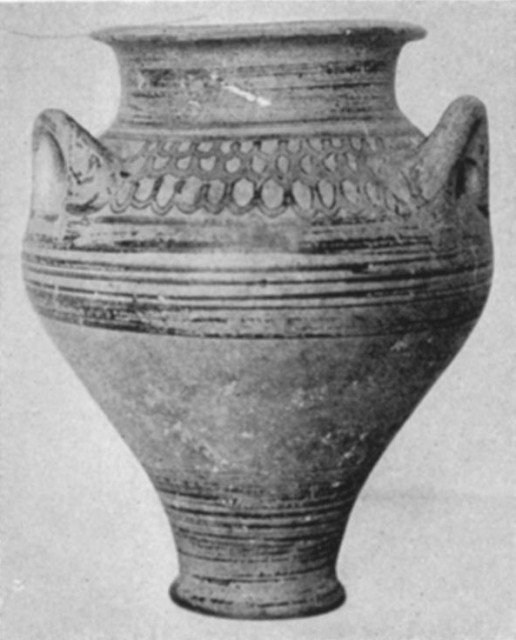
Piriform Vase. Cypriote, Mycenaean Style. ca. 1500-1200 B.C.
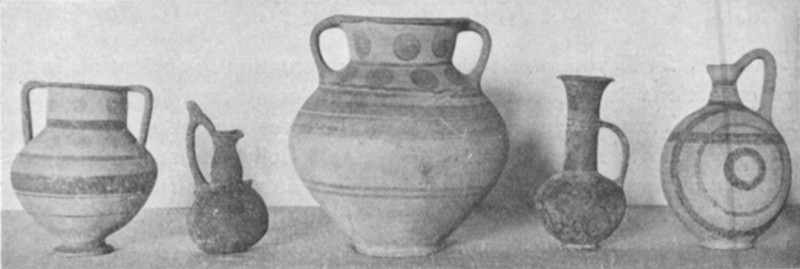
Cypriote Pottery
From left to right: Amphora, white ware painted in black and red, X-V centuries B. C.; jug, red slip ware, XX-XV centuries B. C.; amphora, white ware painted in black and red, X-V centuries B. C.; jug, base ring ware, XV-XII centuries B. C.; oinochoe, white ware painted in black and brown, X-V centuries B. C. The earliest of the fabrics illustrated, i.e., the red slip ware, though usually not polished, is made evidently in imitation of the still earlier red polished ware. Base-ring ware is so called from the distinct standing base found on most specimens. With the white painted ware of the Early Iron Age, we come to a wheel-made pottery, usually having painted geometrical decoration. 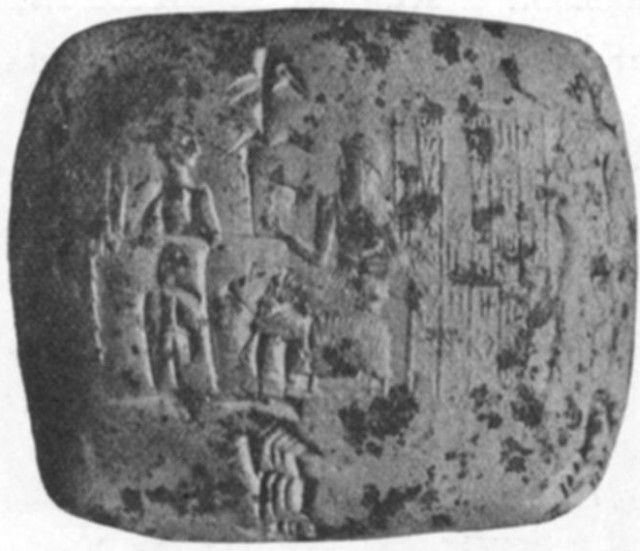
Babylonian Tablet From Jokha, ca. 2350 B. C.
This is one of a small collection of Babylonian tablets. It was made during the reign of Dungi, King of Ur. The inscription records an offering to the temple. The tablet is sealed to prevent the alteration of the record by the priests or attendants; the seal impression bears the figure of Sin, the Moon God, who was the deity of Ur of the Chaldees, and before the deity stand two priests in the act of worship. These inscribed clay tablets were used by the ancient Babylonians in place of papyrus or parchment. GOTHIC ARTSince the Goths, a rude and barbarous ancient people, were in no wise concerned with the splendid art of that period intervening between Romanesque and Renaissance, which misguided later generations called Gothic because, forsooth, it was not classical, it is unfortunate that this inappropriate designation should be perpetuated by custom. But the misnomer is now used so generally—needless to say, without any sense of disparagement—that we must perforce accept it. 
A Pope, Statuette in Oak. Flemish, about 1500
It is impossible to date any period of art with absolute accuracy; for art is always in the process of change, and the flourishing of any period of art is long anticipated by preliminary manifestations. In a general way, however, it may be said that the Gothic period extends from the second half of the XII century through the XV century. Italy presents an exception. The tentative Gothic art of the XIII century in Italy gave place to the new movement, founded upon enthusiasm for antiquity, as well as for nature, which we call the Renaissance. The classical element in Renaissance art is the feature which principally distinguishes it from Gothic. In the latter part of the XV century, the Renaissance spread from Italy into the northern countries, and, in the XVI century, accomplished a triumphant ascendancy over the late Gothic style. The crowning achievement of Gothic art was the cathedral, where architect, sculptor and painter combined to create monuments which rank with the greatest works of human genius. Never has sculpture more perfectly adorned architecture; never has architecture more beautifully expressed the hopes and aspirations of a people. In this age the plastic arts were truly “the language of faith.” From France, Gothic art spread to other lands, to Germany, Flanders, Spain, and England, and even to Italy. During the XIII and XIV centuries, the highest development of Gothic art took place in France, but, in the XV century, Burgundy and the merchant cities of Flanders gained pre-eminence. France required many years after the battle of Agincourt, in 1415, to recover from the exhaustion brought about by internal conflict and foreign wars. In the meantime, the rich cities of Flanders and the powerful Dukes of Burgundy offered the artist generous patronage. [pg 32]If the artist in this late period lost something of the spirituality and noble simplicity of earlier times, he was more skillful technically and more realistic. Not that the earlier artist had not observed nature! On the contrary, he was eminently successful in discerning significant truths, but he subordinated objective representation to the requirements of a monumental style. Save for a distinguished list of painters, headed by the great Flemish masters, the Van Eycks (?-1426, 1381-1440), Rogier van der Weyden (1400-1464), and Hans Memling (1425-1495), Gothic art is largely anonymous. In the minor arts, such as glass painting, the illumination of manuscripts, metal work and enameling, furniture, and textiles, woven and embroidered, the Gothic Age excelled, and the rare surviving examples of these beautiful crafts are treasured among the most precious relics of this great period of the world's art. 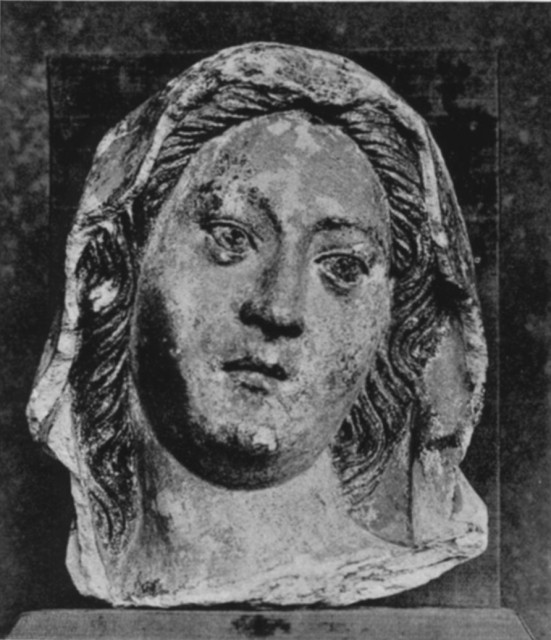
Head of the Virgin, Stone. French, late XIV Century

A View of the Gothic Room
The large well-head of Istrian stone in the foreground comes from the Palazzo Zorzi in Venice, and is a fine example of Venetian stone-carving in the XV century. The well-head, with its acanthus leaves at the four corners, reminds one of the Corinthian capital of classical times, and, as a matter of fact, ancient capitals were sometimes used in later periods for well-heads. On one side is an angel holding a shield supported by two lions passant. Doubtless, this shield was originally painted the owner's coat of arms. [pg 34]
Hunting Party with Falcons. Burgundian Tapestry, about 1450
The two XV century Gothic tapestries in the Charles Jairus Martin Memorial Collection are masterpieces of the weaver's art. They rank among the most beautiful and characteristic examples of the Golden Age of tapestries. The earlier of the two, The Falconers, was woven, presumably in the ateliers of Arras, about 1450. It is similar in style to the famous Hardwicke Hall hunting tapestries, owned by the Duke of Devonshire. These tapestries have been justly called “the finest of the XV century in England.” They formerly ornamented the walls of a great room in Hardwicke Hall, Devonshire, but were removed from there in the XVI century and cut to adapt them to walls pierced with windows in a new location. Taking into consideration the similarity in size, subject, costume, and style of representation, it is not at all impossible that The Falconers may have belonged originally to this celebrated set. Our tapestry, which comes from the Cathedral of Gerona in Spain, was [pg 35] evidently part of a still larger tapestry (tapestries at this time were often woven of great length), and may have been separated from the other pieces of the set at the time of their removal from Hardwicke Hall. 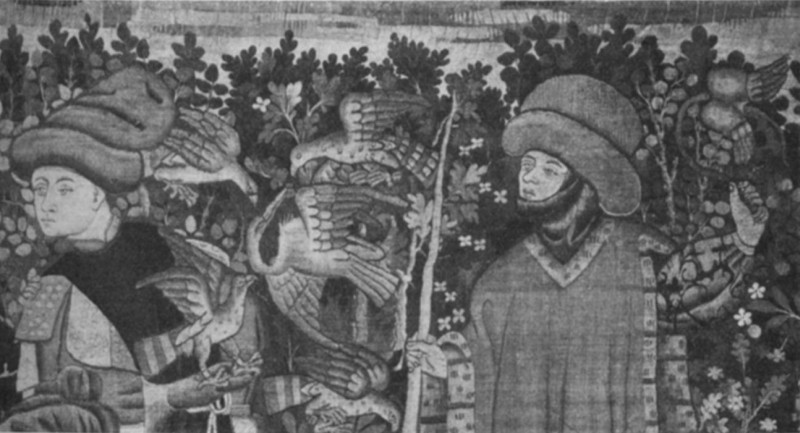
Detail: Falcons Attacking a Heron; Hunter with Lure
In the XV century, hunting and hawking—the latter also called falconry—played a significant part in the social life of the nobility. These sports and the ability to pursue them in a generous and polite fashion set the nobility apart from the commoners, and formed the chief topic of conversation, when war did not call from the slaughter of animals to the slaughter of men. One of the most necessary implements in falconry is the lure, used to recall the falcon. In the upper right-hand corner of the tapestry a man is shown waving a lure in his right hand. The lure is a pair of wings attached to a cord, to which the falcon is trained to return because accustomed to find food there. The mode of carrying the falcon on the gloved hand is illustrated by several of the personages in the tapestry. Several of the falcons are still on leash; one has just been released and thrown up into the air; another is having the hood removed from his head. The rich costumes illustrate the extravagant fashions which prevailed in the middle of the XV century, when there was great competition in dress between the wealthy commoners and the nobility. Great beauty of color distinguishes this tapestry. The greens and browns of the foliage form an agreeable contrast with the rich crimson and blue of the costumes, relieved by passages of green and violet. The Gothic artist was not afraid to use strong colors, but he knew how to keep them in harmonious relationship. The simplicity of the design, the purposeful abstention from realistic effects, which we note in this tapestry, are virtues in the art of mural decoration that can not be too highly commended. [pg 36]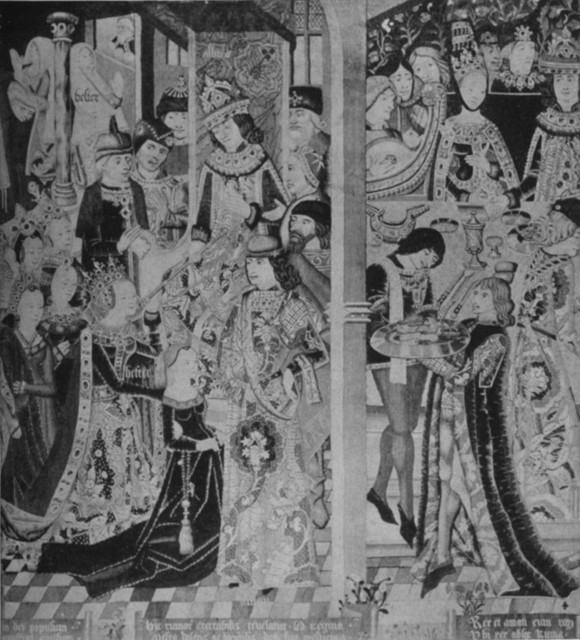
Two Scenes from the Story of Esther. Flemish Tapestry, late XV Century
About fifty years later than The Falconers, this beautiful tapestry with scenes from the Story of Esther, in the Charles Jairus Martin Memorial Collection, represents the tendency toward a more ornate and sumptuous art that characterized the late XV century. In the lower right-hand corner of the tapestry, just above the scroll, may be noted a small fleuron, which is probably the mark of an atelier, but tapestries before 1528 can rarely be assigned to any definite atelier or weaver. We must be content to designate our tapestry as Flemish, woven at the close of the XV century. The story of Esther was popular among the Flemish weavers at this time. Our tapestry, which formed part of a set, may be compared with three hangings of the same subject belonging to the Cathedral of Saragossa. The reproduction can give but an unsatisfactory idea at best of the original. Not only do we lose the mellow harmonies of color, but in reducing the design of so large a tapestry to a few square inches many of the most beautiful details are necessarily lost. In the left-hand compartment, Queen Esther, kneeling before the King, kisses the golden scepter which Ahasuerus extends to her. Having won favor in the King's eyes, Esther asks as a boon that the King and Haman, the King's favorite, whose plot for the persecution of the Jews Esther intends to circumvent, shall attend a feast which she has prepared for them. In the upper left-hand corner are two little scenes; Esther kneeling in prayer, and Esther receiving instructions from Mordecai. In the compartment at the right is pictured Esther's banquet, the second feast, related in Chap. VII of the Book of Esther, which brought about the fall of Haman. Particularly interesting in this scene is the representation of table furnishings, the damask cloth, the enameled ewer in the shape of a boat, the knives with their handles of ivory and ebony, the hanap, the cup of Venetian glass, and the various pieces of plate. We have in this composition a remarkable document illustrating the luxury that characterized the life of the great nobles at the close of the XV century. In the scrolls at the bottom of the tapestry are Latin mottoes referring to the scenes above. Our tapestry was formerly in the J. Pierpont Morgan Collection. In such tapestries as this and The Falconers, we may note the perfect relationship which exists between the nature of the design and the purpose to which the tapestry was put. Gothic tapestries of the XV century illustrate the true principle of mural decoration. Designers deliberately avoided realistic imitation of nature with spatial effects and tricks of illusion. They strove to achieve a decorative flatness of design which would emphasize rather than destroy the architectonic quality of the wall the tapestry was to cover. A tapestry is woven, not embroidered, and forms a single fabric. Only two elements are employed in the making of it, the warp and the woof (or weft). These are the upright and the horizontal threads. The [pg 37] weaving is done upon a loom or frame. The bobbin, or shuttle, filled with thread of the weft, is passed from right to left behind the odd warp threads, and in passing leaves a bit of the weft thread in front of the even warp threads. On the backward trip, from left to right, the shuttle reverses its course and leaves the weft in front of the odd warp threads. Thus, all the warp threads are covered with the weft. A comb is used to press down the threads, so that they form an almost even line. Wool is generally used for the weft, linen or hemp for the warp. The texture was sometimes enriched with passages of gold and silver thread or perhaps a bit of silk. [pg 38]
The Virgin and St. John. Flemish, about 1500
Part of a large tapestry representing the Crucifixion. Its vigorous design and harmonious color make one regret all the more the loss of the other part of this splendid tapestry. 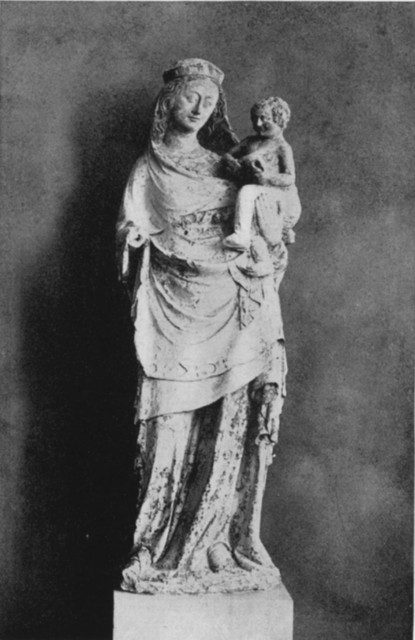
Virgin and Child, Stone. French, XIV Century
This life-size statue, which still retains traces of the painting and gilding with which Gothic sculptures were almost invariably enriched, is an important example of French Gothic sculpture. The monumental character of this great art is shown in the conventional rendering of the hair, and in the simplification of the modeling; its grace and naturalness in the pose of the Divine Mother. The beautiful, rhythmic lines of the drapery should be particularly noted. Representations of the Virgin in French XIV century art have neither the austerity of earlier periods nor the worldliness of later. They are characterized by charming sensibility and tenderness. [pg 40]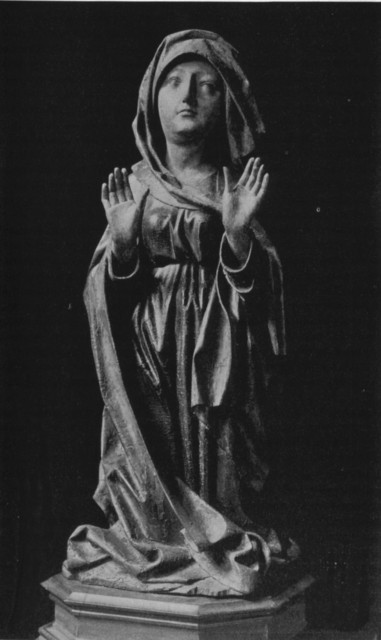
A Saint, Lindenwood. German, School of Ulm, about 1500
This statue of a holy woman, probably one of the half-sisters of the Virgin, Mary Cleophas, the wife of Alpheus, or Mary Salome, the wife of Zebedee formed part originally, it may be presumed, of a Pieta group. This remarkable example of German sculpture at the close of the XV century is carved in linden wood, and preserves largely intact the original gilding and polychromy which add so much to the decorative effect of the piece. A second figure from this group, a kneeling Magdalene, is in the Kaiser-Friedrich Museum in Berlin. There has been noted a similarity in style between these two sculptures and the work of the Meister des Blaubeurer Hochaltars (so called from the sculptured high altar in the choir of the cloister-church at Blaubeuren). We have represented, perhaps, a late phase of his art, stronger and more realistic than in his early period. It would be most interesting if the connection with this well-known master could be established, but, failing that, the figure may be confidently attributed to the school of Ulm, about 1500. We do not expect to find in German sculpture of the XV century that spirituality which characterizes the great achievements of the Italian school. German plastic art was one of realism, modified by a strong decorative tradition centuries old, based not only on precedent but on propriety. If the carved altarpiece were to tell in the subdued light of the Gothic church, the artist had to resort to exaggeration, to sharp contrasts in modeling, to the added emphasis of gold and color, to secure his effect. The skillful artist converted his exaggerations of form and movement into beautiful decoration; seized upon the necessity of contrasting planes as a pretext for crumpling his draperies into numerous rhythmic folds, and used the resources of gilding and polychromy to enrich as well as to emphasize form. But at his best, the German sculptor was more than a simple decorator. Our statue is a case in point. Here we have the work of one who surely has looked into the human heart. Beneath the pattern of line and area, beneath the gold and colors, is a living woman. Not our idea of a saint perhaps; rather, a pretty woman, dainty in her ways, coquetting with religeon—nevertheless very real. Our artist may never have seen a saint, but, no doubt, he saw many a maid like this in his parish. If we are not raised to spiritual heights by his conception of a sainted character, we are at least delighted by his charming humanity. [pg 41]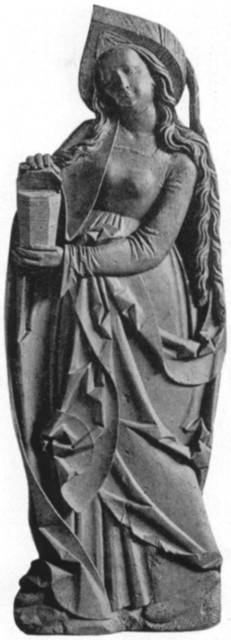
St. Mary Magdalene, Linden Wood. Attributed to Jorg Syrlin the Younger, 1425-after 1521
This relief, attributed to a well-known sculptor of the school of Ulm, one of the chief centers of South German art, may be dated about 1500. Such carvings as this were commonly used to ornament the doors of large shrines. The decorative treatment of the drapery, with its involved folds, is characteristic of the German school. 
Small Column, Marble. Southern French, XIV Century
The foliage carved on the capital of this small column, probably from some cloister, exemplifies the skill with which the Gothic sculptor utilized natural forms as decorative motives. [pg 43]
St. Francis Receiving the Stigmata. School of Giotto, about 1330
The supreme moment in the life of St. Francis, the seraphic Poverello of Assisi, is the subject of this small panel picture, painted in tempera colors with a gold background, by an artist of Giotto's school in the Romagna, who was probably a direct pupil of the great Italian master, and whose charm of color and grace of line were vivified by a feeling for reality of form inspired by Giotto's example. Toward the close of the Saint's life, two years before his death, he retired with some companions to the solitudes of Monte La Verna. On the morning of the Exaltation of the Holy Cross, as St. Francis knelt in prayer on a lonely part of the mountain, there appeared to him a seraph with six flaming wings bearing the effigy of Christ crucified. Two wings were raised above His head, two were spread in flight, and and two covered His body. As St. Francis gazed ecstatically upon this vision, the Savior's five wounds were miraculously imprinted on his hands and feet and side. The second figure in the composition is that of the Saint's companion, Brother Leo, who by his aloofness from the dramatic action of the picture serves effectively as a foil to the figure of St. Francis. [pg 44]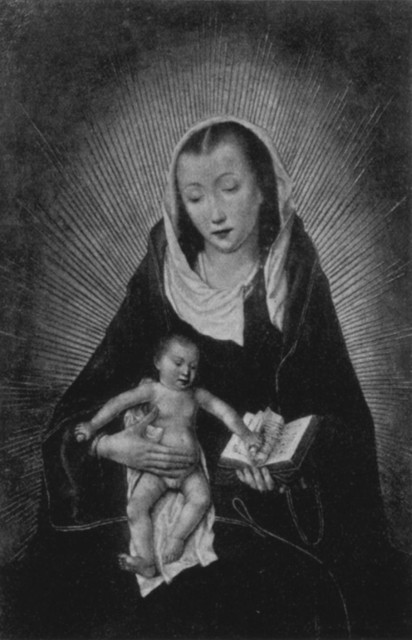
Madonna and Child. The Master of the St. Ursula Legend
The Master of the St. Ursula Legend, a Flemish painter of the second half of the XV century, derives his name from the famous altarpiece in the Convent of the Black Sisters in Bruges representing the history of St. Ursula, a work painted about 1470. The anonymous master of the Bruges altarpiece shows to some extent the influence of Memling; his style, however, is thoroughly personal in its naivete and admirable expression of a good-natured temperament. His character is well seen in such a painting as ours, where the Mother is full of modesty, her face expressing a tender, timid love for her child, who does not embrace her after all, not the most natural thing for a baby to do, but amuses himself with playing with the leaves of a book which the Madonna holds. The Virgin is a home-like, simple type, wholesome if not beautiful. [pg 45]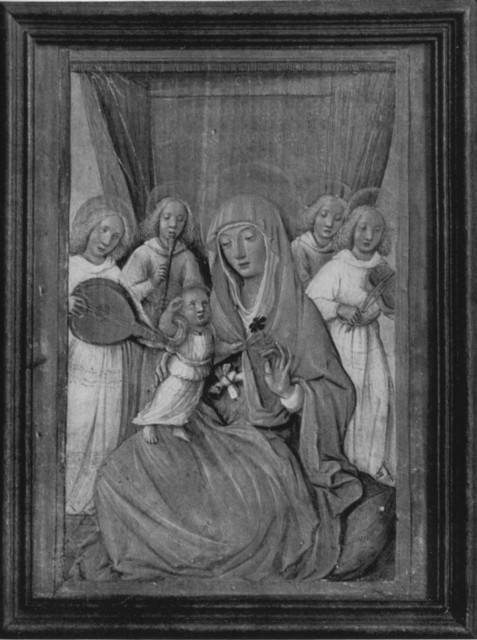
Madonna and Angels. Atelier of Jean Bourdichon, 1457-1521
This delightful French miniature, or illuminated page, on parchment is from some dismembered Book of Hours. If not painted by Bourdichon himself, it was certainly done in his studio under his direction. The invention of printing eventually brought to a close the beautiful art of illumination, but at the time of Bourdichon it flourished in highest perfection. [pg 46]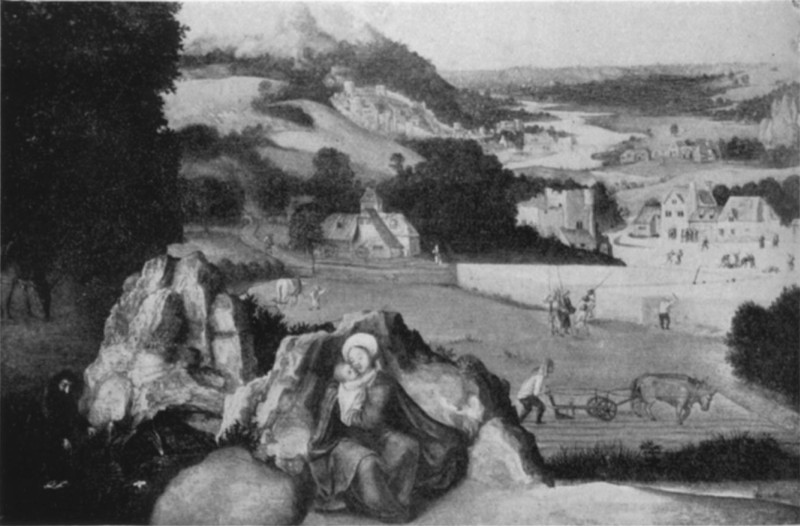
The Miraculous Field of Wheat. Joachim Patinir and Quentin Massys
Two leading artists of the Flemish school were Quentin Massys and Joachim Patinir. Massys (1466-1530) began a new epoch in Netherlandish art; he served as a “connecting link” between Jan van Eyck and Rubens. Patinir (died 1524) was one of the first artists to emphasize the landscape rather than the figures in a painting, but the time had not yet come when landscape could be painted for itself alone. It was necessary to relate it with the familiar religious painting of the day by introducing some biblical or legendary theme. A favorite subject was the flight of the Holy Family into Egypt. This is the subject of our panel-painting in which these two great masters collaborated; the landscape and the smaller figures by Patinir, the group of the Holy Family in the foreground by Quentin Massys. It is related that the Holy Family, closely pursued by Herod's soldiers, chanced to encounter by the roadside a man sowing wheat in a field. The Virgin spoke to him, saying that if anyone inquired if they had passed he should answer, “Such persons came by when I was sowing wheat”; then by a miracle Jesus caused the wheat to spring up and ripen in one night. The next day when the farmer was cutting the wheat, those pursuing the Holy Family came up and asked if he had seen them. He replied as he had been told, with the result that the soldiers turned back, convinced that they had mistaken the road and that the fugitives had gone elsewhere. RENAISSANCE ART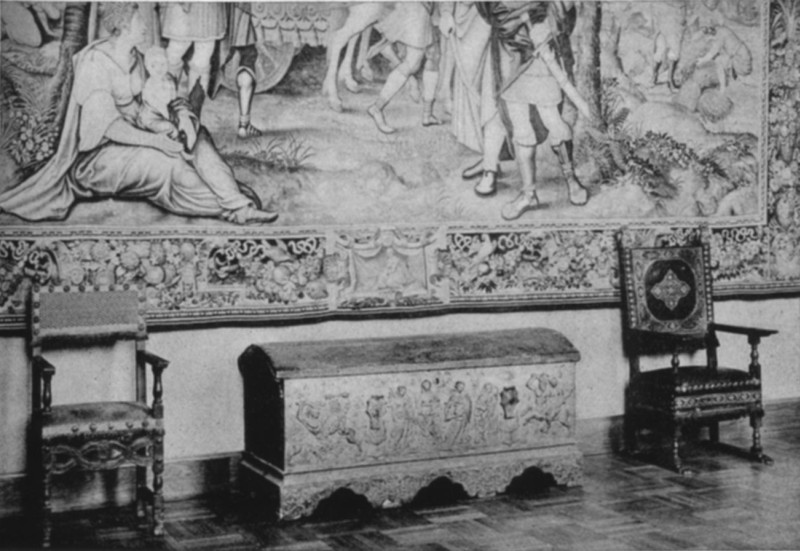
A Group in the First Renaissance Gallery
Renaissance means re-birth. When the barbarians wrote “finis” on the page of Rome's ancient story, long centuries of tenebrous reorganization were to elapse before Italy once more emerged into the light of civilization. In comparison with the shadowy gropings of this age of transition, the brilliant culture of the XV and XVI centuries seemed indeed a re-birth, or renaissance of long-departed glories; and, as an apposite description of the art of this period, the word Renaissance is, on the whole, well chosen. Renaissance art attained its most complete expression in Italy during the XV and XVI centuries; but the new style was not confined by any means to Italy alone. During the XV century, Renaissance art began to spread from Italy to other European countries. Late Gothic art could not withstand its bewitchment, and in the XVI century, European art yielded almost without reserve to the ascendancy of the Renaissance style. Enthusiasm for antiquity and enthusiasm for nature, it has been said, are the chief characteristics of Italian Renaissance art. While this is correct, it is principally the enthusiasm for antiquity that gives to renaissance art its peculiar distinction; for naturalism we find quite as potent a factor in the development of Gothic art as in that of the Renaissance. The Renaissance artist differed in the main from the Gothic not so much in his attitude toward nature as in the way he recorded his reactions—his style, in other words. [pg 48]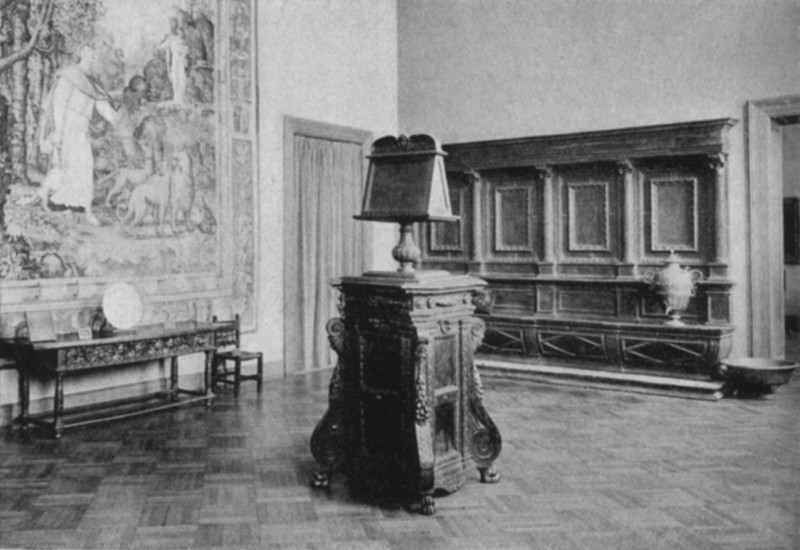
The Second Renaissance Gallery
In the development of the Renaissance style, as distinguished from the Gothic, the example of Graeco-Roman art played an important part. Humanism, the taste for the literature and history of the ancients, awakened the interest of Italian artists in the monuments of their forgotten past, and led them to seek, in the surviving remains of Roman architecture and in the scanty examples of ancient sculpture and painting that chance had brought to light, the secret of beauty. The attitude of the Early Renaissance toward the antique differed from that of the Late Renaissance. In the former period (XV century), enthusiasm for the art of an unfamiliar past, romantically dreamed of, rather than archeologically reconstructed, did not lead to that sterile imitation which came with wider knowledge and greater technical facility in the late days of Renaissance art. Artists of this period were disciples rather than imitators. Grandiose and formal, the Late Renaissance (XVI century) lost the child-like, romantic enthusiasm of the earlier period for classical art. Sculptors and painters not only sought forms which should recall the antique, but also turned eagerly to Greek and Roman mythology for their subjects. As the Renaissance drew to a close, artists began to borrow not only from the antique but also from the great masters of their own Golden Age, Leonardo (1452-1519), Raphael (1483-1520), Michelangelo (1475-1564), Correggio (1494-1534), and Titian (1477-1576). In this futile eclecticism the Renaissance came to an end. 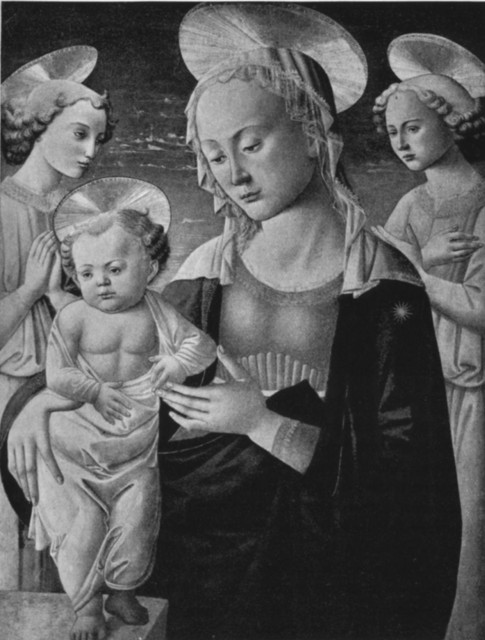
Madonna and Child. The Master of the San Miniato Altar-piece
The author of this charming panel-painting derives his name from his principal work, a large altarpiece still preserved in the little Tuscan town of San Miniato dei Tedeschi. We do not know the artist's real name nor anything of his life save that his work, of which some eight or nine examples are recorded, shows the influence of the great Florentine master, Fra Filippo Lippi, and of another anonymous painter, the so-called Companion of Pesellino. The painting in our collection dates about 1480. We note in this picture the plastic quality which distinguishes the work of the Florentine artists from that of other schools. This love of form is an expression of the same temperament which enabled Florence to produce the greatest sculptors of the Renaissance. [pg 50]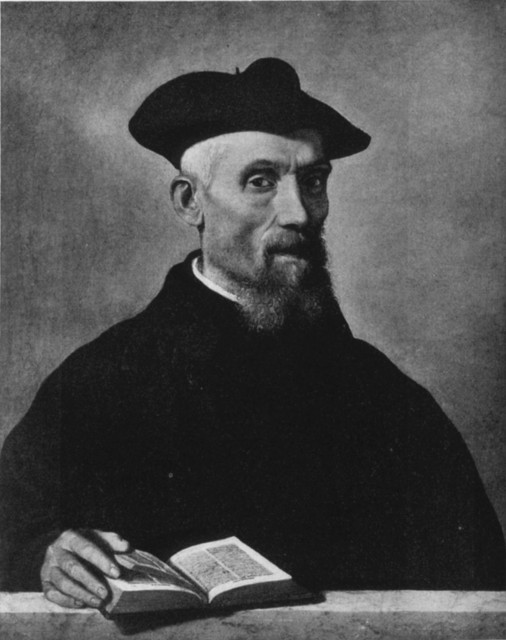
Portrait of an Ecclesiastic. Giovanni Battista Moroni, ca. 1520-1578.
A contmplative, dignified spirit is admirably expressed in this beautiful portrait, which goes to prove that Moroni at his best is entitled to a place among the great Italian painters of the Renaissance. Moroni spent most of his life in the little North Italian town of Bergamo, where he lacked the stimulating competition that occurred in larger centers. At times, his work, mostly in the field of portraiture, is commonplace, but in such paintings as the celebrated Tailor, in the National Gallery at London, or our own Ecclesiastic, we find an unusual power of perception combined with the “measure, distinction, and clearness” which were the Hellenistic ideals of his generation. [pg 51]
Madonna and Child. Giampietrino, fl. first half of XVI Century
Among Leonardo's Milanese disciples was Gian Pietro Rizzi, commonly known as Giampietrino, a definite artistic personality, but historically hardly more than a name. Although he was probably not a direct pupil of Leonardo, there is ample evidence in his work that he came under the influence of this great master, whose exquisitely perfect art had captivated all of Lombardy. Whatever the subject of his paintings, Giampietro's real theme is always the beauty of woman. Affection, but never any great emotional feeling, is expressed in his numerous paintings of the Madonna, since passion would distort the delicate, aristocratic beauty of the forms he modeled with such loving skill. Our painting is exhibited as and indefinite loan from Mr. E. J. Carpenter. [pg 52]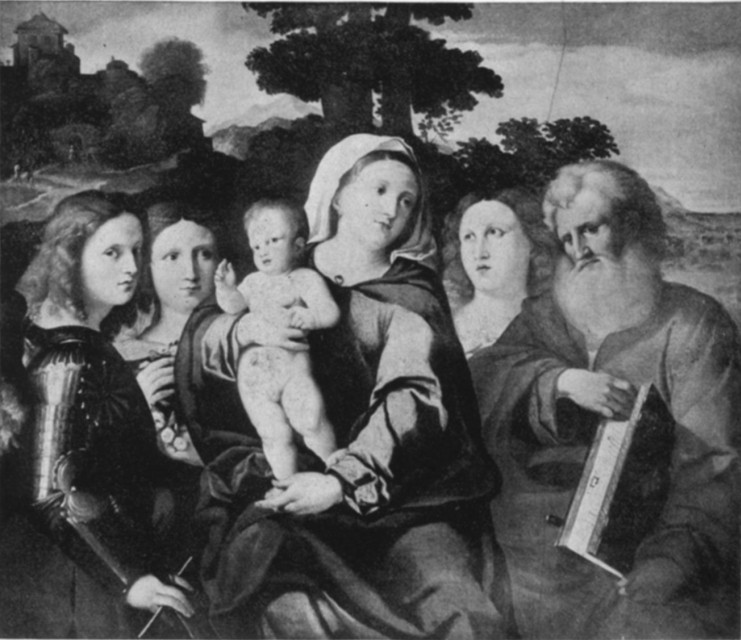
Madonna and Saints. Palma il Vecchio, about 1480-1528
In this important Venetian painting of the High Renaissance, the Madonna and Child are represented in a beautiful landscape surrounded by four saints; at the left St. Michael and St. Dorothea, at the right St. Joseph (probably) and St. Mary Magdalene. Such scenes are called in Italian “sante conversazioni,” or sacred conversations, and were especially popular in Palma's time. This artist, one of the great masters of the Venetian school, was called il Vecchio, or the elder, to distinguish him from his grand-nephew who was called Palma the younger. Three periods of development may be noted in Palma's work. The first is called Bellinesque, when Palma was still influenced by Giovanni Bellini. In his second period, Giorgione's influence was dominant. The so-called blond manner characterized his third period. The fascinating landscape of our painting calls to mind the influence of Giorgione, but the wholesome well-being that radiates from this goodly company of saints reminds one more of Titian than of Giorgione. Palma enjoyed the beautiful luxurious things of life, he delighted in rich amplitude of form, in splendid glowing color, in the health and sanity of happy men and women; and to his vision he gave the permanency of supreme craftsmanship. Our painting, given in memory of James S. Bell by his son, was formerly in the Rangoni Collection of Modena. [pg 53]
Stucco Relief. Workshop of Antonio Rossellino
During the Renaissance, a great number of charming reliefs in stucco and plaster by great sculptors, or in their style, were used for the decoration of the home or of wayside shrines. Our example, probably from the workshop of Antonio Rossellino (1427-1478), is a typical example of these popular reliefs. 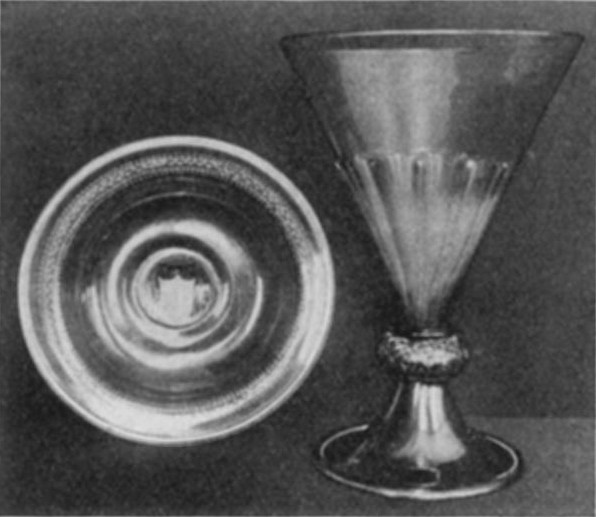
Glass. Venetian, XVI Century
The glass factories at Murano near Venice were celebrated during the Renaissance, as they are today, for their beautiful productions. The large beaker shown in our illustration is of bluish glass. The deep dish is of white glass decorated with colored enamels. 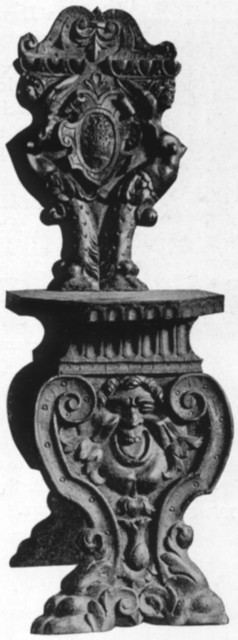
Chair. Florentine, XVI Century
The grotesque figures, the grinning mask and other decorative motives which may be noted in this elaborately carved chair are characteristic of furniture designed in the High Renaissance. [pg 54]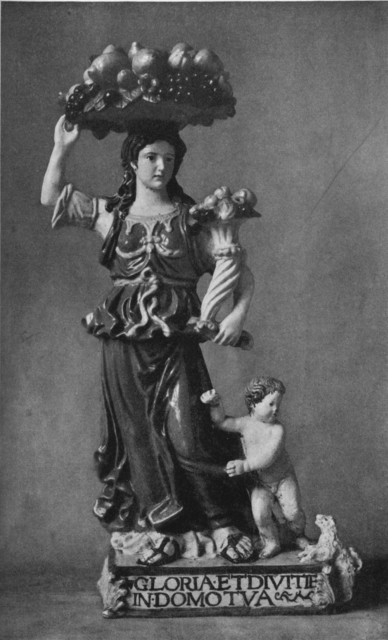
Pomona, Glazed Terracotta Statuette. Giovanni Delia Robbia, 1469-1529 (?)
This charming statuette of Pomona, or Dovizia, as it has been suggested, is the work of Giovanni della Robbia, a Florentine sculptor, the son of Andrea della Robbia who was the nephew of Luca della Robbia. The work of the della Robbia family in glazed terracotta is familiar to all lovers of Italian art. Giovanni was the pupil of his father. His early works, such as this Pomona, show him at his best; in his later productions he lacks refinement and indulges in polychromy with too liberality. When discreetly used, as in this statuette, color enriches the plastic quality of the work. The goddess wears a blue gown with decorations in golden yellow; the fruit is represented naturalistically in yellow green and violet; and the flesh parts are glazed in white. On her head the Goddess carries a basket filled with fruit, and in her left hand a brimming cornucopia. A little boy, with charming naturalness, turns to her for protection as if afraid of the dog barking at him. 
Candlestick, Wood, Carved and Gilded. Florentine, XVI Century
Vasari and a writer of the XVII century mention a statue by Donatello of La Dovizia, which stood in the Mercato Vecchio in Florence. This statue is described as representing a maiden bearing on her head a basket of fruit. The statue is lost, but two existing statuettes of the della Robbia school, in addition to our own (both inferior to ours), are probably reflections of the Donatello Dovizia. In one, in the Buonarotti Museum, we see a maiden supporting on her head, with her right hand, a basket filled with flowers and fruit. A similar statuette in the Berlin Museum carries a cornucopia as well as a basket. Both are called Pomona. The cornucopia, however, is the classic attribute of Ceres and of Abundantia, or, in this case, Dovizia, the Italian version of Abundantia. That our statuette is intended as a personification of riches or abundance rather than as Pomona becomes yet clearer when we examine the inscription on the base: GLORIA ET DIVITIE IN DOMO TUA, “May Honor and Riches Be Within Thy House.” The boy and dog give a touch of domesticity to the group. They express “within thy house,” revealing Dovizia as a household goddess. [pg 55] [pg 56]
Virgil Appearing to Dante, Tapestry. Florentine, Middle of XVI Century
These two tapestries in the Charles Jairus Martin Memorial Collection are remarkably fine examples of Renaissance tapestry weaving in Italy and Flanders during the XVI century. The Dante tapestry was woven about the middle of the century in Florence at the Medici atelier—the Arazzeria-Medici—founded by Cosimo I in 1537. It bears in the selvage the mark of the Florentine manufactory and of the master weaver, John Rost, who with another Fleming, Nicholas Karcher, conducted (from 1546) the work of the Arazzeria. His mark, in the lower left-hand corner of the tapestry, is a punning device, a roast of meat upon a spit. The tapestry was woven for some member of the Salviati family, whose arms appear in the upper border. The design has been attributed on evidence of style to Francesco Rossi de' Salviati (1510-1563), who, with Bronzino and other well-known artists of the High Renaissance, provided many cartoons for the Medici weavers. The scene represented is taken from the opening canto of Dante's Divine Comedy; Virgil, the type of Human Philosophy, sent to guide the poet through Hell and Purgatory, appears to Dante who has lost his way in “the wood of error,” where he is menaced by three symbolical animals, the panther, the lion and the she-wolf, who would prevent him from ascending the “Holy Hill.” The border designs in the grotesque style are particularly interesting and typical of Renaissance ornament. The tapestry is unusually large, measuring 16 ft. 7 in. in height by 15 ft. 4 in. in width. Italian tapestries of the High Renaissance are not common; the Dante tapestry, formerly in the J. P. Morgan Collection, is far and away the most important example of its kind in the country. 
Joseph Ruler Over Egypt, Tapestry. Brussels, Second Quarter of XVI Century
The extraordinary success which attended the weaving at Brussels in the early part of the XVI century of the tapestries from Raphael's [pg 57] famous cartoons brought the Italian Renaissance style into great favor among the tapestry weavers of Flanders. Evidence of this is clear in our tapestry from a set illustrating the history of Joseph. Behind the seated woman in the foreground stands a lady in the rich costume of the XVI century; it is not improbable that this is the portrait of some noblewoman at whose expense the tapestries were woven. In the lower left-hand corner of the border occurs the Brussels mark, a red shield with a capital letter “B” on either side. From 1528 on, the Brussels weavers were required by law to add the mark of the city, together with their own mark, to all tapestries of more than six ells. The weaver's monogram, at the right in the lower border of our tapestry, as not yet been identified. The tapestry dates from about the second quarter of the XVI century. It was formerly in the Rospigliosi and Ffoulke Collections. [pg 58]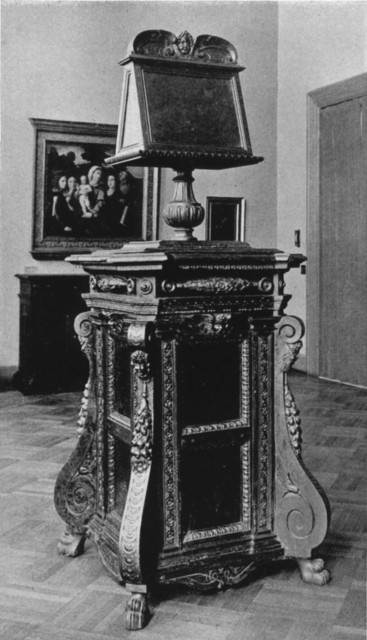
Lectern, Walnut. Italian, Umbrian, XVI Century
The architectural design of this large lectern is typical of Italian Renaissance furniture, as is also the use of such classical decorative motives as the egg-and-dart pattern, rosettes, swags, etc. The lectern, from some Umbrian church, served to support the large choir-books, oftentimes beautifully illuminated, that were in use during this period. [pg 59]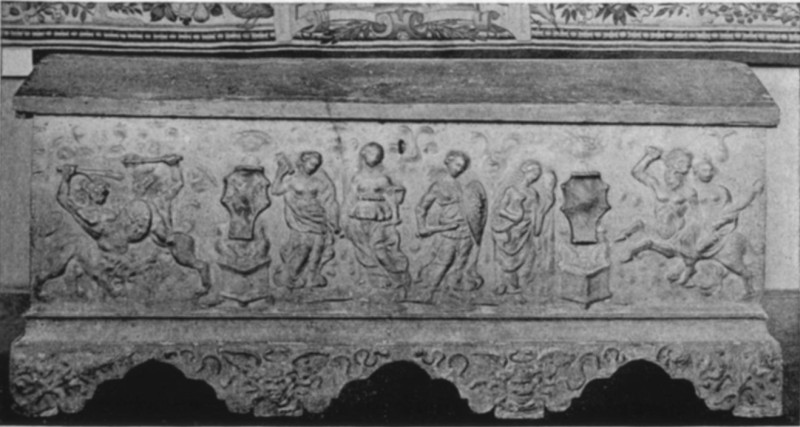
Cassone, with Gilded Decoration. Florentine, Third Quarter of XV Century
Richly ornamented cassoni to hold the bridal trousseau constitute an important class of Renaissance furniture. The two marriage chests, illustrated on this page, are magnificent examples of this type of furniture. The Florentine cassone is ornamented with gilded, low reliefs in “pastille.” In the center are the four cardinal virtues, Temperance, Justice, Fortitude and Prudence; on either side of this group, mythological scenes that may be taken in connection with the virtues as representing the opposition between the ordered Christian life and pagan license. The Medusa heads are introduced as guardians against misfortune. This combination of pagan and Christian elements is thoroughly characteristic of the Renaissance. The beautifully carved walnut cassone was made in 1514 for a marriage which united two Sienese families, the Piccolomini and the del Golia. In its refinement of proportions and skilful execution this cassone is a masterpiece of furniture designing. 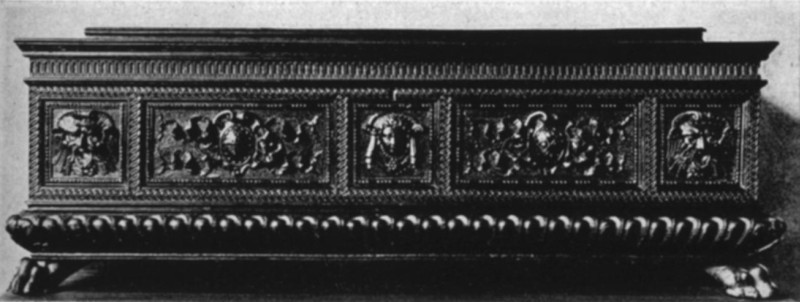
Cassone, Carved Walnut. Sienese, 1514
SEVENTEENTH CENTURY ART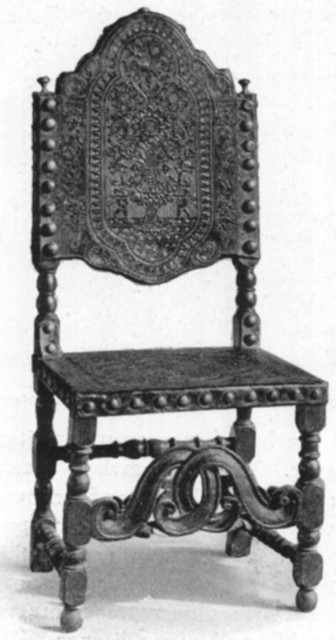
Chair, Portuguese. XVII Century
The XVII century is an age of opposites. Democracy is contrasted with absolutism; the newly won Dutch Republic with the monarchies of Spain and France. Christendom is divided between the antagonistic sects of Catholicism and Protestantism. The Counter-Reformation, at first mistrustful of the artist, now makes use of art to further the Catholic reaction. But religious art itself, exclusively Catholic, is animated by varying emotions which find expression, on the one hand, in the passionate, morbid fervor of Ribera (1588-1656); on the other, in the easy-going rhetoric and corpulent healthiness of Rubens (1577-1640). In secular art we find equally striking contrasts; the pendulum swings from the aristocratic refinement of Van Dyck (1599-1641) to the vulgarity of Brouwer (1606-1638). It seems incredible that two such great artists as Rembrandt (1607-1669) and Velasquez (1599-1660) should have been contemporaries: Velasquez, reserved, proud, the embodiment of Spanish courtliness; Rembrandt, emotional, democratic, understanding and sympathizing with all mankind. But the contrast is no greater than between the popular art that flourished in the Netherlands under a free people, and the monarchical art, with its academies, court painters, sculptors, architects, tapestry weavers and cabinet makers, that revolved around the awesome person of le grand monarque, Louis XIV. Architecture, sculpture and the minor arts display more uniformity of style than the paintings of the period. Dependent largely upon the Church or upon an opulent aristocracy for patronage, they reflect the taste for grandiloquence, ostentation and splendid show which characterized, in this century, ecclesiastic and noble alike. The classic orders tower and writhe on church facade and palace walls. Within, where all is resplendent with gold and rich colors, magnificence pays its lavish homage to deity or to royalty in equal measure. [pg 61]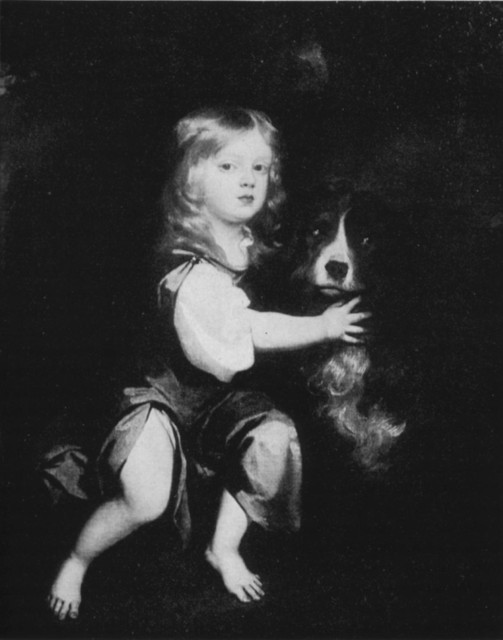
Henry Hyde, Lord Clarendon. Sir Peter Lely, 1618-1680
English painting before the XVIII century was largely dominated by foreign artists: Holbein in the XVI century; Van Dyck in the first half of the XVII century; and, in the second half, the Dutchman, Sir Peter Lely, who came to England in 1641 and speedily won great reputation as a portrait painter, imitating the style of Van Dyck who had just died. Lely's work is distinguished by many excellent qualities, although marred by the pompous artificiality of his time. He is at his best in such a portrait as this, painted shortly after his arrival in England, of the second Earl of Clarendon (1638-1709) as a boy. [pg 62]
The Concert. Michiel van Musscher, 1645-1705
This interesting genre scene is by a Dutch painter of the late XVII century, a period when art, that had been democratic with Rembrandt and Frans Hals, now assumed, under the patronage of wealthy parvenus a pretentious gentility in which the accessories of life were more important than life itself. Van Musscher enjoyed considerable popularity in his time; he painted with meticulous care flattering portraits and pretty genre subjects; he was mindful of each shining pearl and gilded tassel, satin fold and silken curtain—not a detail escaped his devoted eye; but, were it not for a certain distinction which he had as a colorist and composer his paintings would have little importance today, save as records of costume and household gear. [pg 63]
Portrait of a Lady. Michiel Mierevelt, 1567-1641
Mierevelt, a well-known portrait painter of the Dutch school, lived principally at Delft, although occasionally residing at The Hague. He was court painter to the House of Orange, and like others of his kind, evidently enjoyed depicting the elegant costumes and accessories of his aristocratic sitters. Mierevelt differs widely from his younger and greater contemporary, Frans Hals, both in technique and in sentiment. Mierevelt's style recalls the courtly elegance of the Renaissance—which one might expect, since he was born well in the XVI century; whereas Frans Hals, striking out along new lines, represents the new spirit of democracy which inspired the long struggle in the Low Countries to win political and religious independence. The portrait, illustrated above, is dated 1630. [pg 64]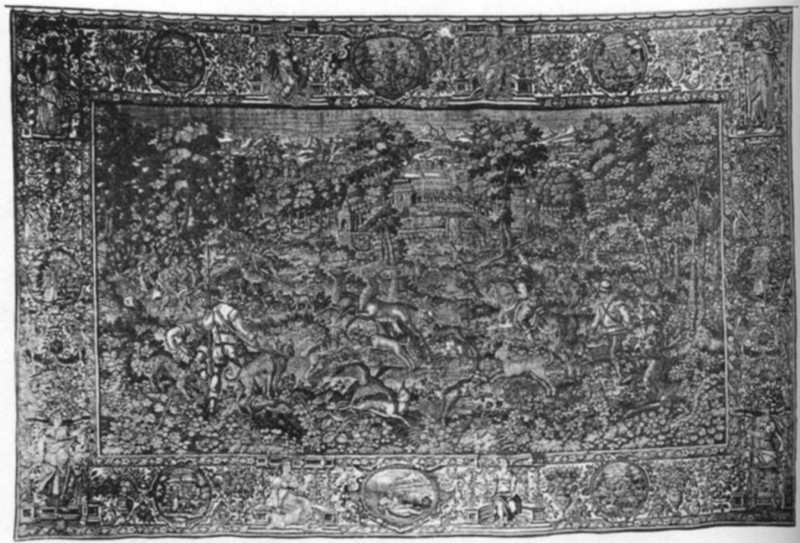
Tapestry, Hunting Scenes. Flemish, about 1600
In the background of this “hunting tapestry,” from the Lowry Memorial Gift, is illustrated the story of Diana and Acteon; the rash huntsman is turned into a stag by the outraged Goddess. In its design the tapestry is more Renaissance in feeling than Baroque, but the crowded ordinance of the composition betrays its late date. The carving on the chest below shows various typical motives of the Jacobean style. 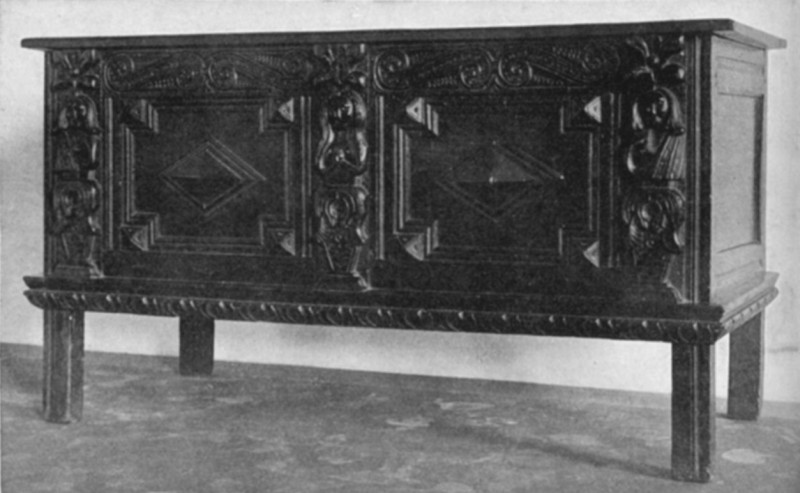
Chest, Oak. English, XVII Century
EIGHTEENTH CENTURY ARTArt of the XVIII century differs radically from that of the preceding century. It is graceful, elegant and coquettish rather than ponderous, majestic and passionate. Forgotten is the fervent piety of the Counter-Reformation and the oppressive grandeur of le Roi Soleil. Life is joyful, to be lived in luxurious boudoirs, exquisite in refinement of decoration, or in pretty gardens where Nature, properly disguised, welcomes aristocratic shepherds and shepherdesses to her pastoral delights. The changed political and social conditions of the XVIII century had their immediate effect in the world of art. Except in England—relatively democratic as compared with France and other continental countries—art was almost exclusively aristocratic, and mirrored the self-indulgent interests of fashionable patrons. Even in England, where Hogarth moralized for the bourgeoisie, and the sturdy lineaments of the commoner were portrayed by a Reynolds or Gainsborough no less frequently, and truthfully, than the high-bred mien of a great nobleman, artistic concessions to the Third Estate were distinctly limited. It was in courtly France, soon to be racked by social revolution, that the epicurean art of the XVIII century was most at home. When we name Watteau, Boucher, Fragonard, Clodion, Houdon, we sum up, perhaps, all that is most characteristic of painting and sculpture in XVIII century art. The portrait painters of England contribute to the century the meed of their greatness; Italy gains lustre through Tiepolo; Spain through Goya; but it is to France that we turn to experience in its completeness the spirit of the Rococo. In the “century of little things” the minor arts attained an exceptional importance. Artisans ranked as artists, and justly. Among the distinguished artists of the XVIII century must be included such great craftsmen as Chippendale, Sheraton, Hepplewhite, Oeben, Riesener, Gouthiere, and Caffieri—to make but a brief selection from among the numerous English and French cabinet-makers, metal chasers, and other craftsmen of the period. The productions of these celebrated artisans were rightly looked upon as works of creative art of a high order, and the makers were accorded the patronage and protection of royalty and nobility. In technical perfection the XVIII century crafts have never been surpassed. But too great proficiency led sometimes to artistic disaster, as we may note in tapestries imitating the difficulties of inappropriate pictorial models, or in the florid carving sometimes indulged in by the cabinet-makers—even the celebrated Chippendale, if the truth be told. These occasional deviations from the path of artistic rectitude must not mislead us, however, from a just appreciation of the extraordinary merits of XVIII century decorative art. [pg 66]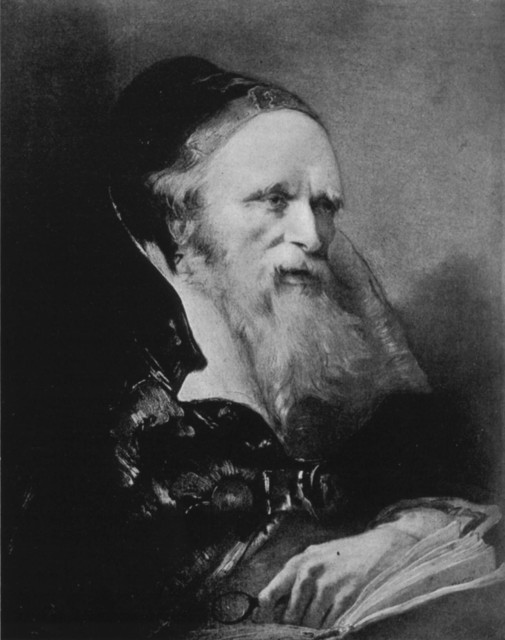
Head of an Old Man. Giovanni Domenico Tiepolo, 1727-1804
The work of Domenico Tiepolo, the son of Gian Battista Teipolo, the head of the Venetian school of the XVIII century and the last of the great Italian painters. In the period of exhaustion which followed the Renaissance, the Venetian school alone was blessed with genius. The list of painters is indeed impressive when compared with the nonentities of the other Italian schools of the XVIII century. Although Domenico did not display the same great genius as his father, at his best he approached Giambattista so closely that his works have often been confused. Domenico is known as an etcher as well as a painter. In his set of character heads, called the “Raccolta di teste”, there is an etching reproducing the above portrait. [pg 67]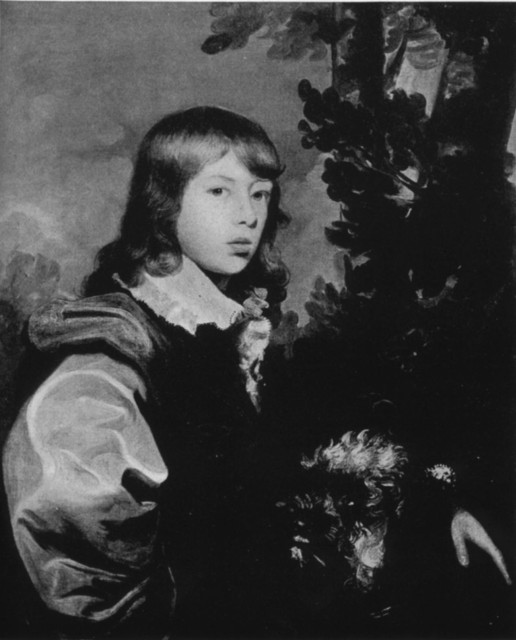
Portrait of James Ward. Gilbert Stuart, 1755-1828
Gilbert Stuart was typical of his time and country in that his art was not national but derived from England, where he received most of his training. His masterful expression of personality, his brilliant brush-work and treatment of light, permit him to be classed among the most gifted artists of his age as the first truly great American artist. The Portrait of Master Ward, painted in 1789, and one of the very few signed works of the artist, was exhibited at the Royal Academy in the year in which it was painted. It is considered by eminent critics the most beautiful of Stuart's paintings in American collections. This graceful lad, portrayed fondling his dog, afterwards became famous as an engraver of animal subjects. [pg 68]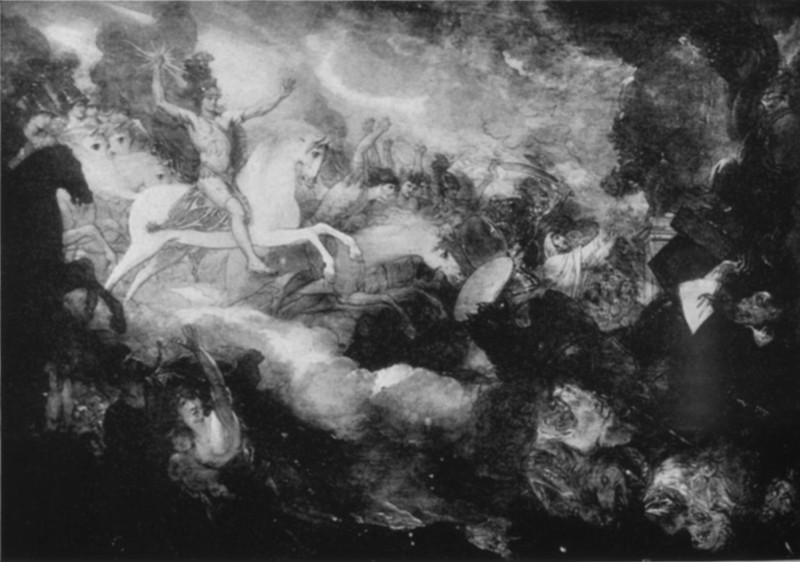
Death on the Pale Horse. Benjamin West, 1738-1820
In its early days, American painting was derived from Europe and especially from the mother country, England. The early XVIII century portraits of prominent Colonials and their families, though valuable as historical documents and not without a naive charm, are halting and provincial as works of art. The first American painter to win a widely recognized position in the world of art was Benjamin West. In his twenty-second year he went to study in Rome, where he worked for several years in the “grand manner.” Moving to England in 1768, he won favor at once, was appointed historical painter to the King in 1772, and twenty years later, on the death of Reynolds, was elected president of the Royal Academy. The Institute's painting, Death on the Pale Horse, is a study for his grandiose canvas in the Pennsylvania Academy. When it was first exhibited, the artist was acclaimed a second Michelangelo. It is painted mostly in subdued bronze and dull red tones, and shows Death as a splendid youth seated upon a white horse, charging out of the sky at the head of a troop of heroic horsemen. Below him crowds of terrified human beings are fleeing before the vision, idols fall, and wild beasts snarl and cower. The subject is taken from Revelation VI, 8: “And I looked and beheld a pale horse and his name that sat on him was Death, and Hell followed with him. And power was given unto them over the fourth part of the earth, to kill with sword, and with hunger, and with death, and with the beasts of the earth.” [pg 69]
Large Embroidered Hanging. French, Early XVIII Century
Subject, Spring: from a set representing the Four Seasons, in memory of Mrs. Thomas Lowry by Mrs. Gustav Schwyzer, Mrs. Percy Hagerman and Horace Lowry 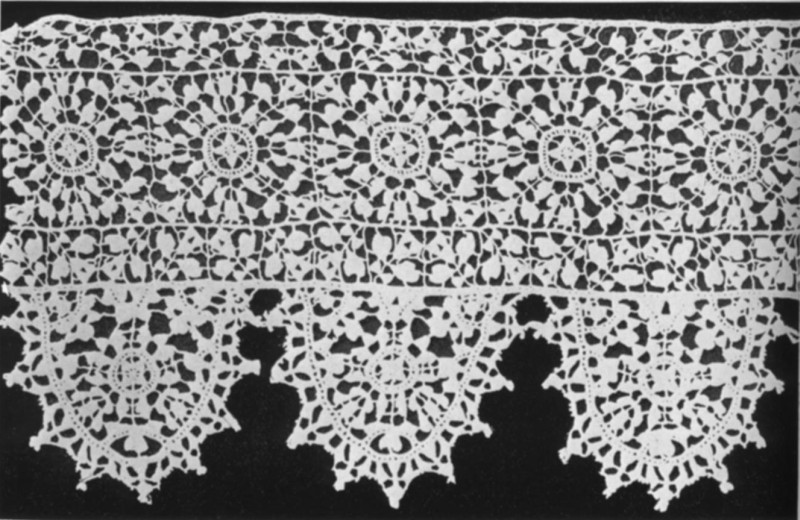
Needlepoint, Reticello. Italian, Early XVII Century
The piece of reticello lace, illustrated above, is an unusually fine example of early Italian needlepoint. Reticello was the first needlepoint, and from it all the later ones were derived. Long points, such as we see here, were much used on collars and cuffs in the XVII century. Of other Italian laces in the collection may be noted a large panel of Milanese bobbin lace of the late XVII or early XVIII century, a fine piece of beautiful Venetian rosepoint of the XVIII century, and examples of Burano and grounded Venetian lace of the same period. French laces of the XVIII century are represented by characteristic examples of Point d'Alencon and Point d'Argentan needlepoint and of old Valenciennes bobbin lace. Flemish laces may be studied in typical examples of Mechlin, Point d'Angleterre, Application, etc. These exquisite fabrics of France and Flanders have never been surpassed in beauty of design and skilful workmanship. The delicate meshes seem at times almost miraculous—as if they owed their origin to Jack Frost rather than to human hands. To show the fineness of the thread used in making the characteristic hexagonal mesh of Point d'Argentan, it may be stated that on an average one side of the hexagon measures only 1-16 of an inch. On each of these sides there are usually 10 stitches. This makes 160 stitches to the inch—which means more, perhaps, when we realize that in the finest machine sewing there are usually 32 stitches to the inch. The collection also includes XIX century and modern examples of Belgian, English and American lace. [pg 71]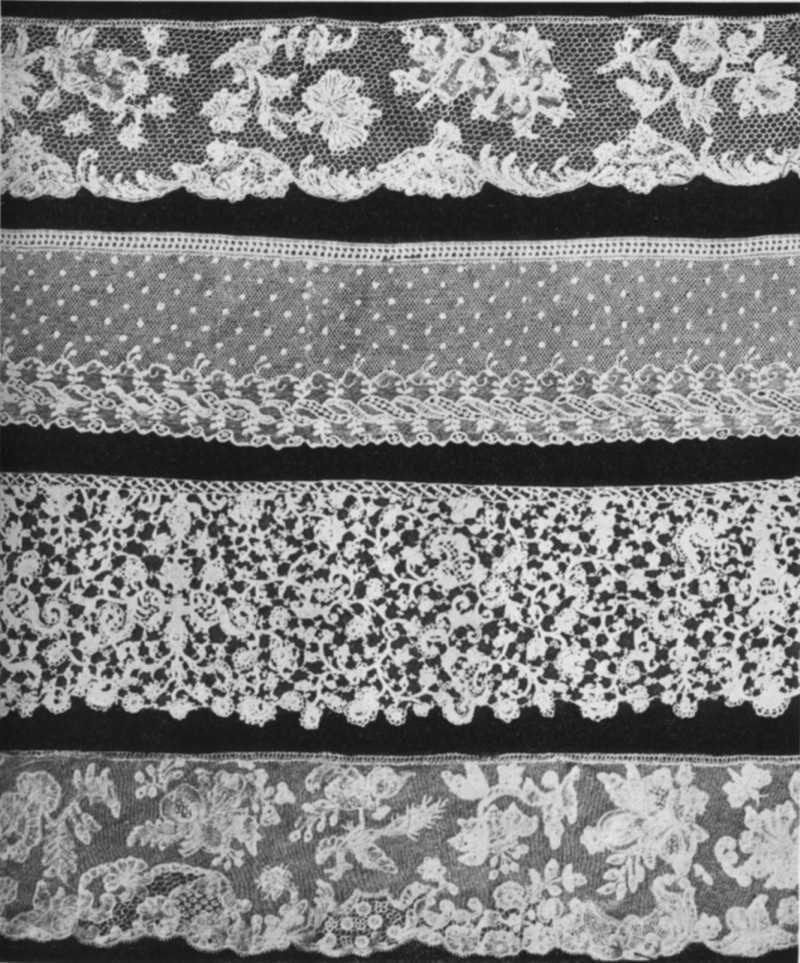
Lace, Needlepoint, Point d'Argentan, French, XVIII Century
Lace, Needlepoint, Point d'Alencon, French, XVIII Century Lace, Needlepoint, Rosepoint, Venetian, Early XVIII Century Bobbin Lace, Point d'Angleterre, Flemish, XVIII Century 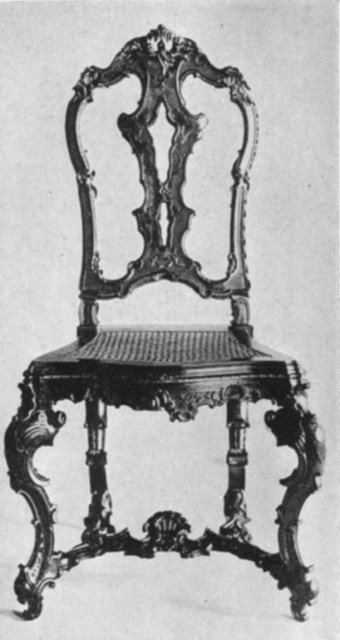
Chair, Pearwood Venetian. Early XVIII Century
The hectic magnificence of life in XVIII century Venice finds its reflection, naturally enough, in the decorative arts of the time. Furniture less ornate than the lavishly carved chair illustrated on this page would have seemed out of place in the great gilded salons where human peacocks strutted in the bravery of brocade and rustling silk. As a general rule, Italian furniture of the Rococo Age is easily recognized by its prodigal indulgence in the spices, so to speak, of furniture designing. Rarely is a piece of Italian furniture of the elaborate character of this pearwood chair so successful in combining an almost excessive richness of carving with a fine feeling for proportions and harmonious ensemble. Indeed, it is not impossible that the chair is the work of a cabinet maker who may have come from France to Venice in the suite of some great nobleman. Of the master craftsmen of England in the XVIII century none has achieved greater renown than Thomas Chippendale (1709-1779). Through the publication of his book of furniture designs in 1754 (later editions in 1759 and 1762) as well as by the example of his own cabinet work, he exerted a widespread influence. His various styles were imitated not only in England, but also in the American colonies. Consequently, not every “Chippendale” piece is from the master's hands; on the contrary, well authenticated furniture by Chippendale himself, or by his own workmen, are great rarities. It is customary, however, to designate as “Chippendale” the work of his contemporaries and imitators who copied the styles which the master had popularized. 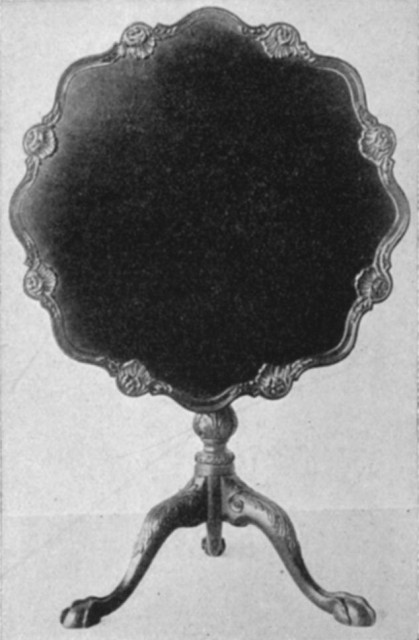
Tripod Table with Top Tilted Back
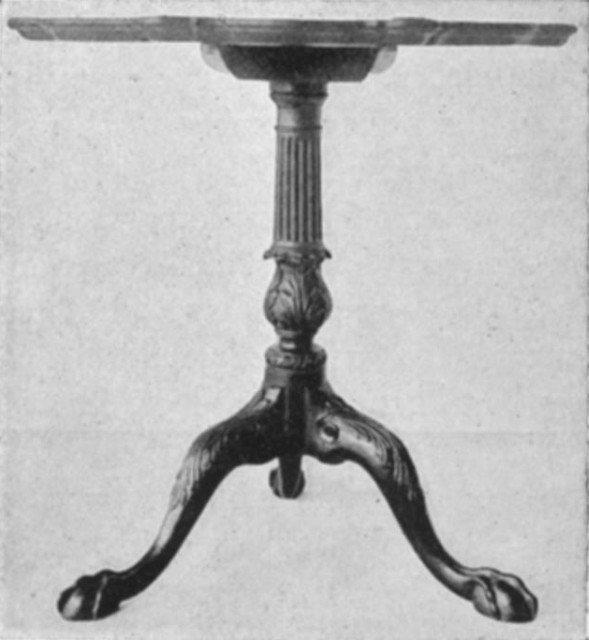
Tripod Table, Mahogany, English, about 1760-1765
The tripod table was perhaps the most important achievement of Thomas Chippendale as innovator, for it was his exclusive creation. The tripod table in our collection was made approximately between 1760 and 1765. The quality of the carving is so excellent, the sense of style so marked, that, if not by Chippendale himself, the table is surely the work of a cabinet maker who closely rivaled the famous master. Tripod tables are commonly referred to in documents of the period as “snap [pg 73] tables.” The top is hinged so that it can be tilted back to save space. When in use it is held in place by a sliding catch, which snaps sharply into position when the top is let down. 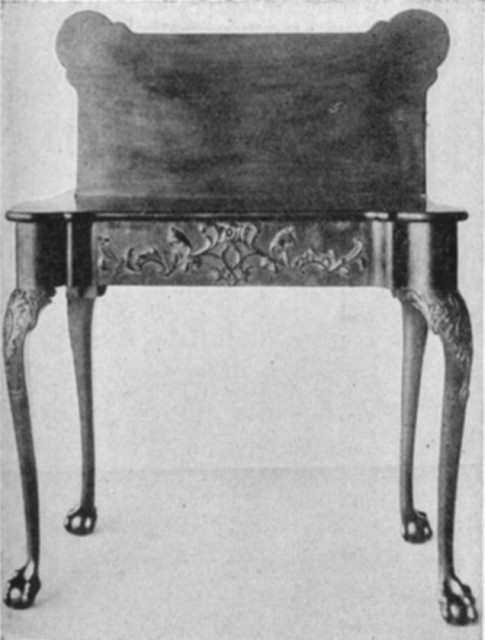
Card Table, Mahogany English or American, about 1750-1775
Card playing, often for high stakes, was so much the rage in the XVIII century that there were generally several card tables in a fashionable house of the period. The folding card table, here reproduced, dates about 1750-1775 and was possibly made in America rather than in England. Characteristic of the Chippendale manner are the cabriole legs and the style of the relief carving. One of the legs swings outward to support the hinged half of the top when open; the rounded corners of the top served as candle stands. Note the fine carving of the moulded rim with its foliated scallop shells. The fluted shaft and the cabriole legs with ball-and-claw feet are well proportioned. [pg 74]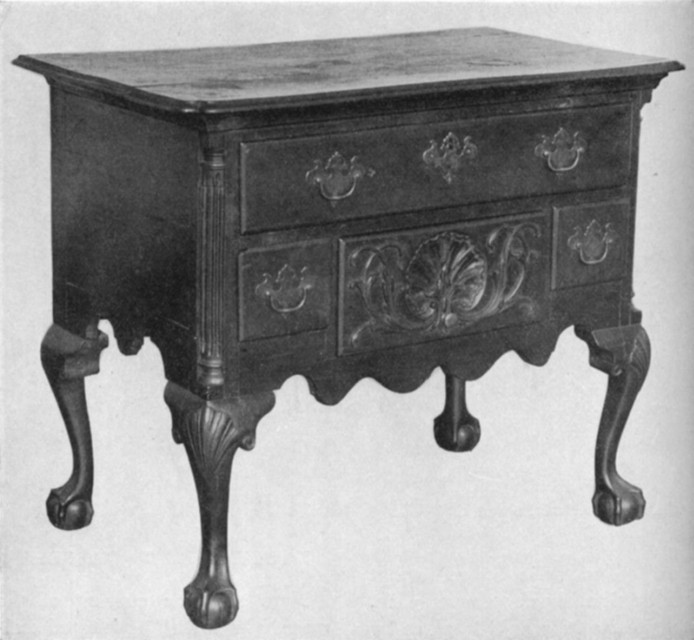
Dressing-table, Mahogany. American, about 1760-1775
The dressing-table, or low-boy, illustrated above, is a fine example of the more elaborate cabinet work done in this country during the XVIII century. It dates from about 1760 to 1775, and was probably made in Philadelphia. In a dressing-table very similar to ours there has been found the advertisement of the maker, “William Savery, at the Sign of the Chair near the Market on Second Street, Philadelphia.” The small group of existing furniture to which our piece belongs includes some of the finest examples of American furniture. Low-boys and high-boys; that is, dressing-tables and high chests of drawers on legs, would appear generally to have been made in pairs. The companion piece to our lowboy has been lost sight of, but the type is well known. The lower part would have been about the same in design as the dressing-table; the chest of drawers, which it supported, completed by a scroll top. The high chest of drawers enjoyed a long continued popularity in America. The type just described, despite its Chippendale motifs, was distinctly American. The expressions, high-boy and low-boy, are not found in the old records; they probably originated later in derision, when the chest of drawers and its accompanying table seemed grotesquely out of fashion. [pg 75]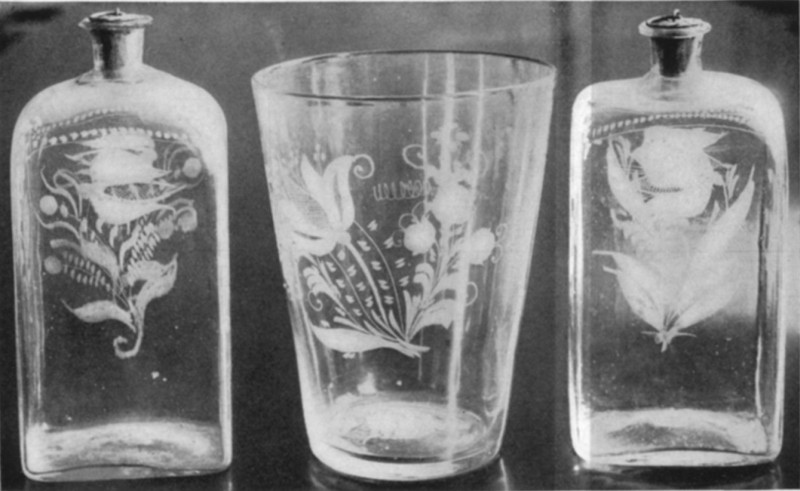
Large Flip Glass and Two Liquor Bottles. Stiegel Glass, American, XVIII Century.
We take glass so much for granted today that it is difficult for us to realize how rare and precious a commodity it was to the first settlers of this country. It is significant that the first attempt to establish a manufacturing industry in the American colonies was the building and equipping of a glass house. About the middle of the XVIII century, glass began to be manufactured upon an extensive scale. The Stiegel Glass Works, the second successful glass factory, and the best known of the early American works, commenced operations at Manheim, Pa., in 1765. “Baron” Stiegel—his title was a courtesy one—was born in Germany, at Cologne, in 1729; came to Philadelphia in 1750; married the daughter of a rich iron master; and in the course of time, launched his ambitious project for the establishment of a glass manufactory that would compete successfully with the European glass centers for the American market. The Colonies were then going through a period of economic stress that was soon to lead to the Revolution. Unable or unwilling to read the signs of the time aright, Stiegel speedily met with financial embarrassment, failed in 1774, and was even imprisoned for debt. The victim of his own vanity, or rather self-confidence, this early American captain of industry died in destitution, January 10, 1785. His factory, maintained for a while after is failure, was not operated after 1780. The three pieces of glass illustrated above are typical of the white flint glass with engraved designs made at the Stiegel works. The manufactory was also renowned for its colored flint glass, and for glass with enameled decoration. THE SECOND FLOOR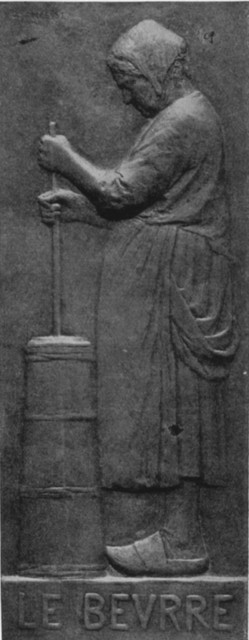
Le Beurre, by Ovide Yenesse.
MODERN AMERICAN PAINTINGS[pg 77]The American painters of the Colonial period and of the first fifty years following the Revolution were followed by a group of landscape painters, known as the Hudson River school, who were more indigenous and original than their predecessors. These men enthusiastically transcribed the scenery of their native America, especially the Catskill Mountains and the valley of the Hudson. With George Inness began what might be called the middle school of American landscape, which came to be one of the most important contributions that America has made to painting. Inness discarded the humble literalism of Kensett and the grandiloquence of Bierstadt. Like his contemporaries at Barbizon, he preferred more intimate subjects, and of their detail he aimed to give only enough to reproduce the single, synthetic emotion into which his poetic fire could fuse the scene. Among his able contemporaries and successors were Wyant, Homer Martin, Tryon, Eaton, Ranger, Blakelock and Horatio Walker. To this tradition in landscape was added a virile foundation of marine painting in the works of Winslow Homer. Artists of power and individuality, whose influence on the development of American painting would be difficult to trace, include the great, perhaps rather un-American, Whistler, revealer of subtle tone relations; Vedder, master of rhythmic line; La Farge, rich colorist and decorator; Albert P. Ryder, with his glowing color and romantic imagination; George Fuller, whose tender poetry and mellow, golden-brown tone were his native gift; William Morris Hunt, whose enthusiasm as teacher, more than whose example as artist, revealed to younger men the new breadth and insight of their contemporaries in France. The seventies and eighties of the century were marked in general by a dependence upon the art of Europe. A group of men, including Duveneck, Chase and Shirlaw, went to Munich whence they brought home a solid, painter-like technique and a sober tonality. These qualities became a factor in the early development of such artists in America as John W. Alexander and Joseph De Camp. Edwin A. Abbey, painting in England, developed the romantic anecdote. The strongest influence, however, came out of Paris, mother of modern art movements. The teachings of such masters as Gerome, Bonnat and Carolus-Duran were assimilated without sacrifice of individuality. Fresher, breezier color and a more brilliant technique came into American figure painting. To this group belong Thayer, Volk, Dewing and Brush, refined painters of figures; Low and Cox, followers of a more classic tradition; Gari Melchers, whose greater directness comes partly out of Holland, Mary Cassatt, influenced by Manet and Degas; and Sargent, whose gusto, spontaneity, and brilliant technique have made him one of America's four or five greatest painters. [pg 78]Weir, Twachtman and Hassam imported the new enthusiasm for Impressionism, for the use of pure colors in reproducing high-keyed effects of ephemeral sunlight. Tarbell, Reid, Little, C. H. Davis, Symons, Redfield and Frieseke show to varying extent the same influences. The present tendency in American painting seems to be toward greater diversity and a more unfettered assertion of personality, as exemplified by such men as Davies, Henri, Hawthorne and Bellows. 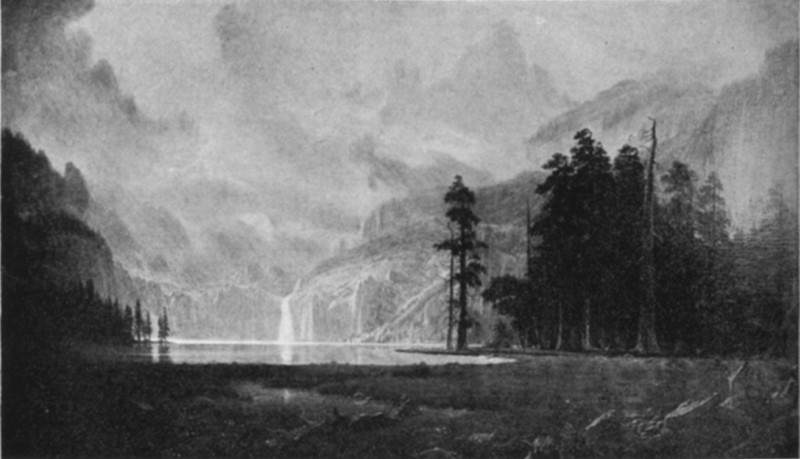
Mount Whitney. Albert Bierstadt, 1830-1902
No member of the Hudson River school, probably, imbibed so much of the qualities of the Dusseldorf masters as did Bierstadt. He chose for his big canvases panoramas from impressive scenes in Yellowstone Park and in the Rockies. He attempted to give the illusion of reality to these by a minutely detailed rendition of foreground, while the subject itself, with his favorite lowering clouds and romantic haze, was to produce the desired grandeur. The result made his paintings popular in America of his own time; but today his grandeur seems a little theatrical. [pg 79]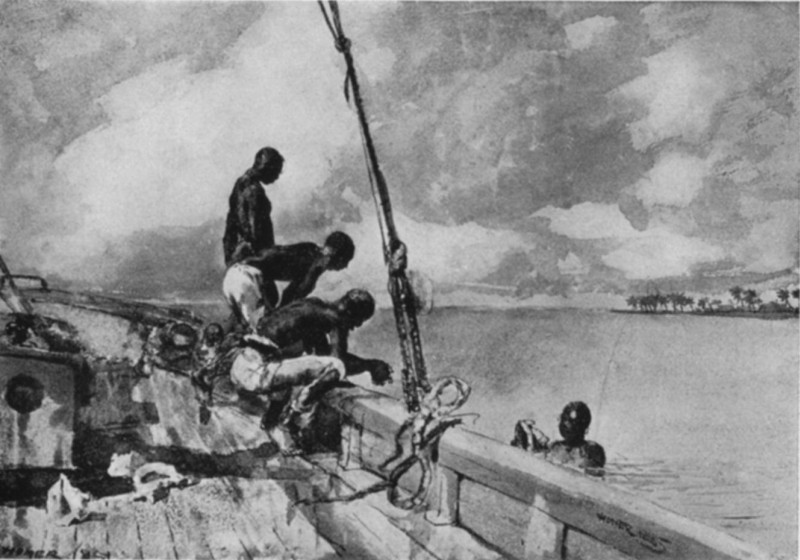
The Conch Divers. Winslow Homer, 1836-1910
It is rare that an artist uses with equal success both water color and oil. With Winslow Homer one hardly knows which to admire more, his oil paintings or his water colors. His oils are, perhaps, more bare, more elemental than the water colors, but the tones are harsher and often less true. In the winter of 1885-1886, Homer visited the Bahama Islands, where a new world of color was opened to his eyes. The water colors which he made during this and subsequent voyages are among the finest things he ever did. Among these is The Conch Divers: negroes on the deck of a sloop are watching the reappearance of a diver who has just come up alongside with some shells in his hand. The Island of New Providence with its palms is seen in the distance at the right. The composition is admirable; the figures are drawn with great power. “It is Winslow Homer's distinction that he was the first American painter to use an American idiom,” writes William Howe Downes. “Not only his subjects, but his manner of treating them; not only his motives, but his point of view; not only his material, but the style and sentiment in which he clothes it, have the stamp of Americanism indelibly impressed upon them.” This spirited statement might be qualified by the observation that it is George Inness and Fuller who express more truly the spirit of American rural life; while it is Homer who expresses the spirit of the frontiersman, the deep-sea fisherman, and all those whose lives bring them face to face with the bare facts of the unmitigated elements. [pg 80]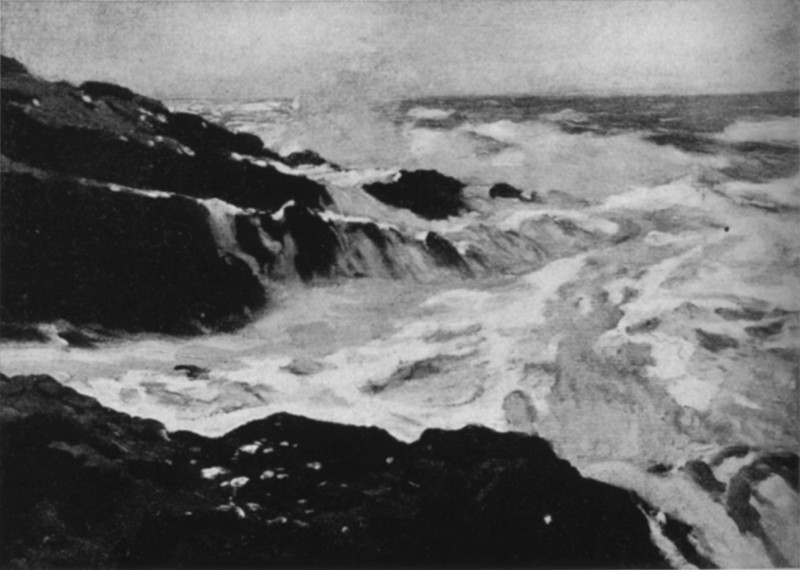
Moonlit Surf, Paul Dougherty, 1877-
A contemporary American painter of rocks and sea who may be considered to be in a sense a successor to Winslow Homer, is Paul Dougherty. He is thoroughly American in spirit, and mainly self-taught. After a brief career in the law, he turned to painting. With a knowledge of drawing and perspective as a foundation upon which to proceed, he went to Europe where he spent several years studying without masters in Paris, London, Florence, Venice and Munich. He returned to his native country more American than ever. Our artists, he said, walked too near the sterile soil of eclecticism, deferred too much to established codes. Like Winslow Homer, he scorned the nicer subtleties of personal moods. He rejoiced in nature's more vigorous aspects and he looked at her impersonally, objectively. This passion for puttmg things down as they are rather than using them as a means of expressing his individual moods, is, curiously enough, the key to the individual note which stamps his canvases. At the same time this literal tendency seems to some critics to be his greatest weakness. He has devoted himself almost exclusively to chronicling the moods of the sea, to transcribing the profound surging billows, the swirling of eddies, the resistless pounding of waves against cliffs, the dash of spray upward into the light. A good example of these fresh sea-pieces is Moonlit Surf. It is a comparatively recent work, and shows the sea striking against rocks and sweeping into their crevices, while a warm moonlight, glancing over the crests of waves, gives color. [pg 81]
Luxembourg Gardens at Twilight. John S. Sargent, 1856-
In this canvas, Sargent has shown the hushed pensiveness of mood, the perfection of sensitively modulated color of which his many-sided genius is capable, but which it has, in fact, rarely attained to such a degree as here. The subject of the painting is the Luxembourg Gardens in Paris at twilight, with the moon rising above the trees. In the distance may be seen the dome of the Pantheon. Various groups of figures lend the scene a measured animation. The picture is hardly more than a sketch, but its justness of values conveys an impression of reality which is characteristic of the artist. Particularly attractive is the mellow tone of the painting. The soft tawny grays of the foreground, the sombre green of the thickly-massed trees; the note of rose in the woman's costume, form an exquisite harmony, accentuated by occasional touches of black. It was presented by Sargent to his friend Charles Pollen McKim, the celebrated architect, who died in 1909. It is signed, “To my friend McKim, John S. Sargent.” A replica of this painting, in the John G. Johnson Collection, is dated 1879.—The Martin B. Koon Memorial Collection. [pg 82]
The White Bridge. John H. Twachtman, 1853-1902
At the time of Twachtman's death, fear was expressed by a fellow artist that the canvases he had left behind might prove too fine a food for the general palate. In the intervening years, however, general taste has become better accustomed to the impressionist mode of expression; and today anyone must be in harassed and impatient mood who does not respond to the sensitive appeal of Twachtman's vague landscapes. These carry to the last degree of refinement the idea that spiritual rather than physical facts are properly the subject matter of art. In the White Bridge we sense the very essence of soft spring-time. The yellow-green of young grass and tender foliage gives the general tone of the painting. In the foreground, on the bank of a stream, a crooked tree reaches out its sappy young branches, which form, together with the latticed railing of an intimate white bridge, a delicate pattern against some evergreens behind. In the foreground on the quiet surface of the stream the reflection of the bridge forms a tracery in pale lilac.—The Martin B. Koon Memorial Collection. [pg 83]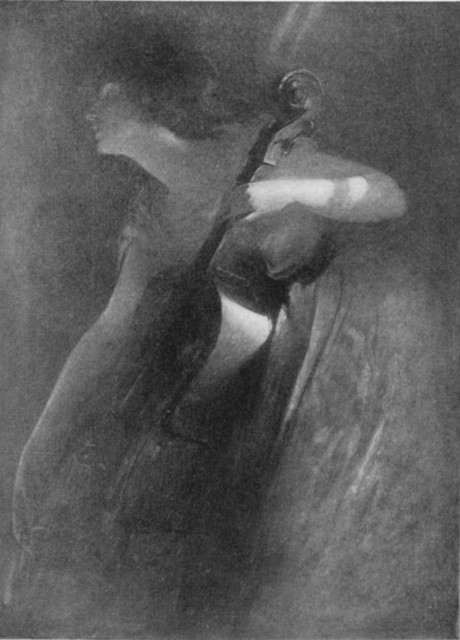
A Ray of Sunlight. John W. Alexander, 1857-1915.
A fine and characteristic example of the work of John W. Alexander, is A Ray of Sunlight. The appeal of the work is felt immediately. It represents a young woman playing a violincello. One can imaging emotional strains of Chopin. There is extraordinary breadth in the treatment of the musician's gown, yet the coarse absorbent canvas gives a soft and interesting surface to the broad planes. The most lasting attraction of the picture is due to the artist's treatment of light. A soft, glowing, effulgence flows in from the right, and envelops the graceful figure, a direct ray falling across the forearm and reflecting in the polished surface of the instrument. [pg 84]
River in Winter. Gardner Symons, 1861-
Gardner Symons, an important member of the modern group of American landscape painters, is fond of representing winter scenes with snow covering the ground and softening its contours. In River in Winter he has produced a cheerful scene, treated with much beauty of color. Late afternoon sunlight slants across the snow, casting rosy lights and violet shadows. Between sparsely wooded banks, a river flows toward the spectator. In the distance are low opalescent hills beneath a transparent greenish sky.—The Martin B. Koon Memorial Collection. It may be interesting to compare River in Winter by Symons with the painting in the same collection and bearing the same title by Edward W. Redfield. Redfield is a well known American painter noted for his winter landscapes. Our example of Redfield's work is highly characteristic. Compared with Symons' painting, we find it less warm in color, characterized by a more brittle and restless handling of surfaces, and a less sedate and simple feeling for composition, but quite as convincing as a portrayal of nature. [pg 85]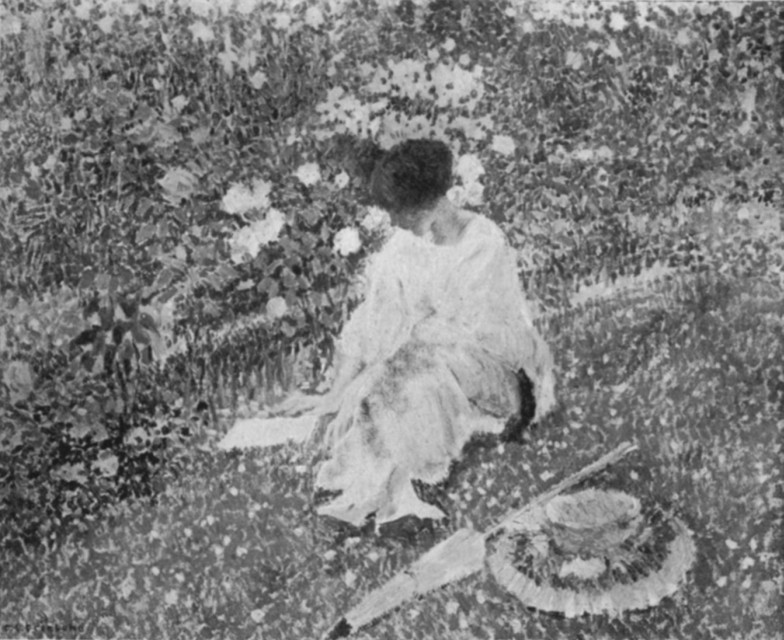
Garden in June. Frederick C. Frieseke, 1874-
Frederick Carl Frieseke is one of the most delightful among the younger American painters who revel in the sunlight of Impressionism. He studied at the Chicago Art Institute, at the Art Students' League, and, in Paris, under Constant, Laurens and Whistler; but Claude Monet has been the important influence. Frieseke's interest is in the color effect of the things in his chosen field of vision, in the effect things make at a single glance upon an eye trained to see the transient color of shadows and of objects in sunlight. For the detailed study of form, he cares little; yet his drawing is adequate, and his spots of bright color are always worked together into a pleasing and balanced pattern, as we see it in the Garden in June. Lately, a more diffused light and less dazzling color has appealed to Frieseke, and he has given us a series of lovely impressions of ladies at their various domestic pursuits. The painting entitled The Toilet in the Institute's collection is an example of the later studies.—The Martin B. Koon Memorial Collection. [pg 86]
The Open Sea. Emil Carlsen, 1853
The consummate workmanship of Emil Carlsen in covering a canvas with pigments gives the illusion of appealing to more senses than the sense of vision. The delicious handling of color and the creamy texture of his paint seem to tickle the palate and to please the finger tips. The Open Sea is the sea at its most alluring. A fair breeze gives the water vivacity without making it threaten. It seems friendly, with its subtle endless shifting of blues and pale greens; one's face welcomes the dash of spray from the crest of such a wave. Emil Carlsen was born in Copenhagen, Denmark, in 1853, and came to America in 1872. He studied architecture in his native city, but subsequently devoted himself to painting, in which he soon achieved unusual success. He has received many awards and is represented in the Metropolitan Museum, the National Gallery in Washington, and other important collections. A Woodland Interior in the Institute's collection is another work by Carlsen, revealing similar charms to those found in The Open Sea.—The Martin B. Koon Memorial Collection. [pg 87]
The Yellow Flower. Albert Reid, 1863-
The favorite subject of Robert Reid's study is the gracefully clad figure of woman, enveloped in the soft atmosphere of the studio or out of doors. His treatment is purely decorative, and his color contrasts slight. He poses his model quietly, engaged in unpurposeful occupations such as gazing at a bowl of goldfish, dreaming before a bit of bright porcelain, or seated placidly in a meadow, as in The Yellow Flower. In this pleasing painting, the filmy blouse, the yellow skirt, the golden skin and hair almost melt into the yellowish green of the grass in which the figure is Placed.—The Martin B. Koon Memorial Collection. [pg 88]A psychologist has pointed out somewhere that if it were not for the artists among us pointing out the beauties of landscape, very few of us would ever appreciate them. One finds no landscapes painted on Greek vases. The early European painters used landscapes only as backgrounds for portraits or religious subjects. Certainly there exist in nature charms of color in shadow, rich varieties of pure tone in sunlight which none of us suspected until the Impressionist painters insisted upon them. 
Midsummer. R. Sloan Bredin, 1881-
In Midsummer by R. Sloan Bredin one finds not only an unusually pleasing piece of diagonal composition, not only a lyrical mood undisturbed by disharmony, but also a way of seeing things which, if we could make it a part of ourselves, would much enhance our own visual enjoyment of nature. The beautiful play of color through the foliage of the big tree at the left of the canal, the subtle effects produced by the faint haze of a July noonday, the fresh tones of the nearer foliage drooping across the larger tree beyond, should prove a lesson as well as a joy. [pg 89]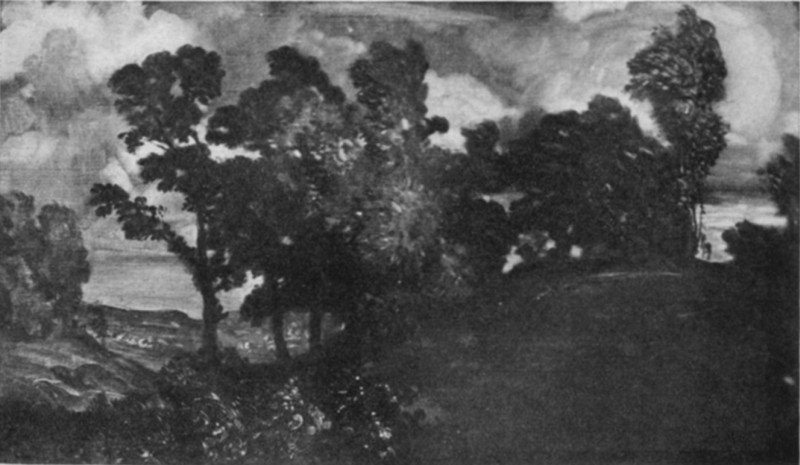
Night's Overture. Arthur B. Davies, 1862-
One of the most personal and interesting painters in America today is Arthur B. Davies. His painting ignores the commonplaces and unessentials of life. “Never once does he wander from his dream, his vision,” writes Samuel Isham. “His enchanted garden is not visited at rare intervals; it is not one of many resorts, it is his home, his retreat from which he never departs. It is a wonderful land of which he gives us glimpses—of flowery meadows and bosky groves peopled by youth and childhood.” His visions are naive, tender, whimsical, often vaguely allegorical, sometimes a little unintelligible, but never trite nor sentimental. In his recent work he seems to tend more and more toward the unintelligible, as his love of the allegorical and the purely spiritual grows. To Night's Overture much of these remarks may seem not to apply. Here is nothing of the naive, the whimsical, the allegorical. And yet this landscape is characteristic of Davies' art. It is a highly spiritualized and individual treatment of landscape, wonderfully decorative in color and arrangement, and highly endowed with feeling.—The Martin B. Koon Memorial Collection. MODERN EUROPEAN PAINTINGSTo trace the history of painting in the XIX century in France, is to trace the main stem of its recent developments throughout the western world. Germany has grafted something of her own national spirit upon the parent art forms of the French; England has contributed some original impulses; Holland and Spain have looked back to their own past as well as across to the contemporary painting of the French. Yet it is France, with her bewildering crowding in of new ideas and crowding out of old, which during the past century, has led the way in painting, and in the opening of the XX century continues to lead. In the beginning of the XIX century, the longing of intellectual France for a return to the poise and civic virtues of republican Rome had found its visual expression in the classical paintings of David (1748-1825) and Ingres (1780-1867). The beginnings of Romanticism are seen in the paintings of Gros, who dared to paint his characters in clothes more modern than the toga. Gericault and Delacroix (1799-1863) completed the development in their impassioned color and movement and their searching out of romantic and exotic subject matter. A group of mid-century artists who combined many of the qualities of the Classic and Romantic schools included Cabanel, Lefebvre, Bouguereau and Gerome. The military painters, Meissonier, Detaille, and de Neuville, might conveniently be grouped with them, they alike treating romantic subjects in a precise and academic manner. Reflections of this group in Germany are seen in Piloty, Menzel and Max; in Great Britain in Alma-Tadema, Leighton and Orchardson. Such painters as these expressed the Academic attitude with which, from 1850 to 1885, the ideas of the Barbizon painters, the Realists, the rising Impressionists, and, in England, the Pre-Raphaelite Brotherhood (unrelated to any Continental movement) had to compete. The Barbizon School, including Rousseau, Corot, Millet, Daubigny, Troyon, and others, owed much to the Dutch landscape painters of the XVII century and to the influence of the Englishman Constable (1776-1837), who had gone directly to nature and represented what he saw with a fidelity rare since the time of Ruisdael and Hobbema. The spirit of this group inspired Mauve and Jacob Maris in Holland, while Israels was influenced rather by the old Dutch masters of figure painting. Modern Impressionism is a mixture of two streams of influence. One arose in the direct vision of Courbet, and the realistic painting of enveloping atmosphere as invented by Velasquez and rediscovered by Manet. The other stream springs from the poetic impressionistic methods of Corot and the fiery Turner. Influenced by these two currents, Monet and Renoir produced the high-keyed externality of Luminism, which has strongly affected contemporary American painters; while in Europe, [pg 91] Degas, Pissarro, Sisley, Sorolla, Zuloaga, Zorn and Liebermann have drawn in varying degrees from the same two streams. Defying all classification, stands the one great decorator of the century, Puvis de Chavannes; while initiating the most modern art movement are Cezanne, Gauguin and Matisse, who revolt against objectivism, and strive in visual forms to express the abiding verities. 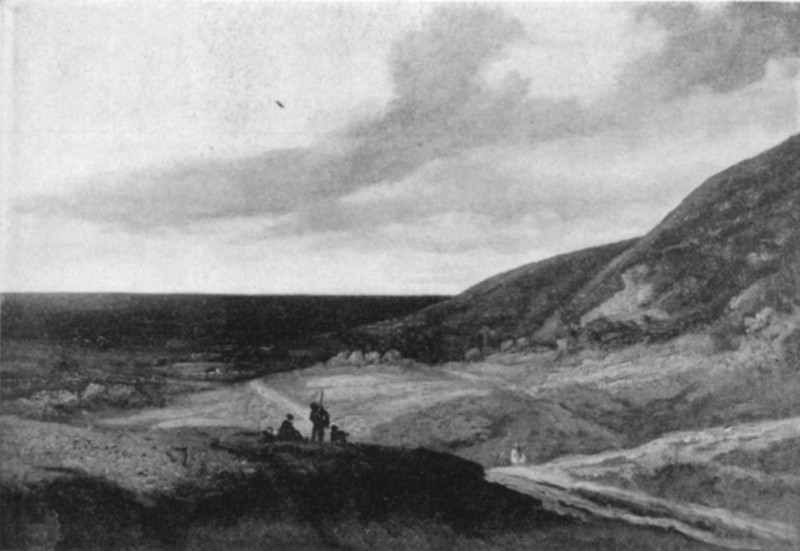
Landscape. Georges Michel, 1763-1843
To those who asked him why he did not go to Italy for his subjects, Georges Michel would answer: “The man who can not find enough to paint during his whole life in a circuit of four miles is in reality no artist.” This artistic creed was nothing less than revolutionary at that time, in the early days of the XIX century, when the landscape painter regarded nature as unworthy of his brush unless it was bedecked with ancient temples and peopled with gods and goddesses, or at least suggested Italy or some distant land. Georges Michel lived on the heights of Montmartre in Paris. He walked out into the country and painted what he saw. His landscapes are actual studies of nature painted in the open air. As one of the first painters of paysage intime, Michel was a forerunner of Rousseau and the men of 1830. His narrow, subdued scheme of color establishes his relationship with the great Dutch masters of the XVII century. In France, however, his was pioneer work; he did not cater to the popular demand, and it was not until the World Exhibition in 1889 that his genius was generally recognized.—Gift of James J. Hill. [pg 92]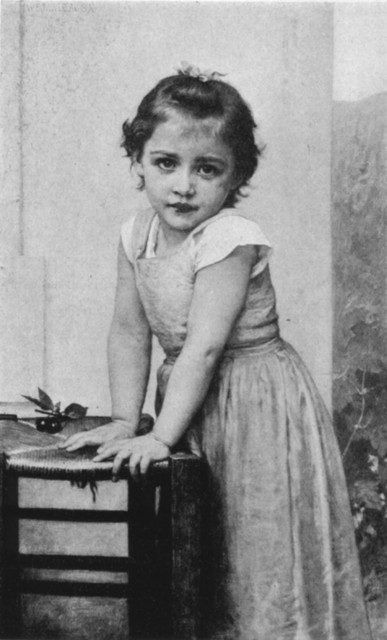
Child with Cherries. Gillaume Adolphe Bouguereau, 1825-1905
The most popular figure paintings of the mid-nineteenth century in France were those of the group of compromisers or semi-classicists. Their compositions were the natural successors to the classicism of the academicians David and Ingres, modified by a new vogue in France for romantic types and for modern history. One of the important men of this group was Bouguereau. He had much skill in drawing and in composition. He makes his appeal, however, chiefly through his choice of themes, employing usually either sentimental religious subjects or pretty children.—From the Bequest of Mrs. W. H. Dunwoody. [pg 93]
The Bath. Jean Leon Gerome, 1824-1903
The bright Turkish interior, which Gerome has chosen for his scene, gives it a colorful setting. The walls are covered with rich blue-green tiles. The brilliant garment thrown over the seat at the right, and the towel hanging above it give the complementary colors. Against this vivid ground are played the cool flesh tones of the seated woman and the sleek, dusky skin of the negro attendant. Further color and exotic interest are given by the gaudy bangles and kerchief of the slave. Gerome is usually classed with Bouguereau among the semi-classicists of the XIX century in France. In his work, we find the strong interest in contours, in reposeful composition, and in smooth finish for which the academy stood, while his subjects take us to the romantic Orient and spread before us the pageantry of history.—Gift of Mrs. Frederick B. Wells in memory of her father, Frank H. Peavey. [pg 94]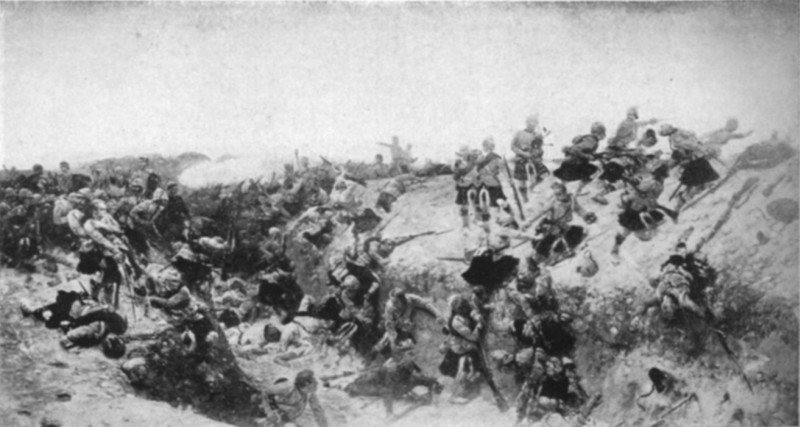
The Storming of Tel-el-Kebir. Alphonse de Neuville, 1836-1883
This battle scene by the French military painter de Neuville depicts the crucial moment in a hard campaign undertaken to crush a rebellion among the Egyptians. In the gray dawn of September 13, 1882, a British force with bayonets fixed stormed the entrenched natives; and in a few minutes hard fighting decided the supremacy of Great Britain in Egypt. 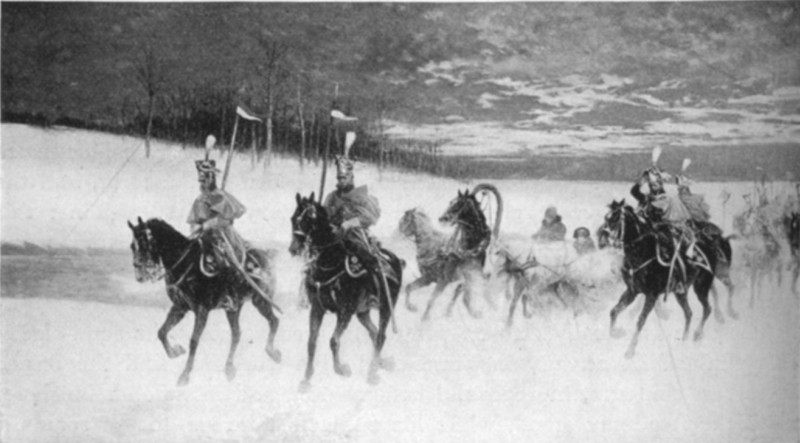
Napoleon's Retreat from Russia. Jan V. Chelminski, 1851-
The Polish painter Chelminski was contemporary with the military painters working in France, and his work is similar, although his training was that of Munich, not Paris. In Napoleon's Retreat from Russia, he suggests in the tragic sunset lighting of the sky, the frightful demoralization and suffering of Napoleon's army, defeated by boundless steppes and relentless winter.—Gift of James J. Hill. [pg 95]
The Roe Covert. Gustave Courbet, 1819-1877
Few great artists have been so little influenced by their great forerunners as Courbet was. A man of strong peasant instincts, of incomparable forcefulness and initiative, he looked at the works of the great romanticists of his time and laughed with a titantic contempt. He looked at the works of Raphael and Michelangelo and laughed again. Their power and beauty were nothing to Courbet because they were afraid of the unvarnished truth. The Spaniards he admired. He was instinctively the “painter of raw material.” Moreover, he was a truculent propagandist, an “individualist with strong elbows.” In his own time, he was a subject of ridicule; but we now know that he was a great painter as well as a blunt pioneer. His great artistry is inescabable when we see in such a painting as The Roe Covert, the bold naturalism of vision, and directness of brushing combined with such a fine power of harmonizing tones, and through all, such a tender feeling for the subject. He is as a young savage might be in his element; he can love Nature without first making romantic literature of her.—Gift of James J. Hill. [pg 96]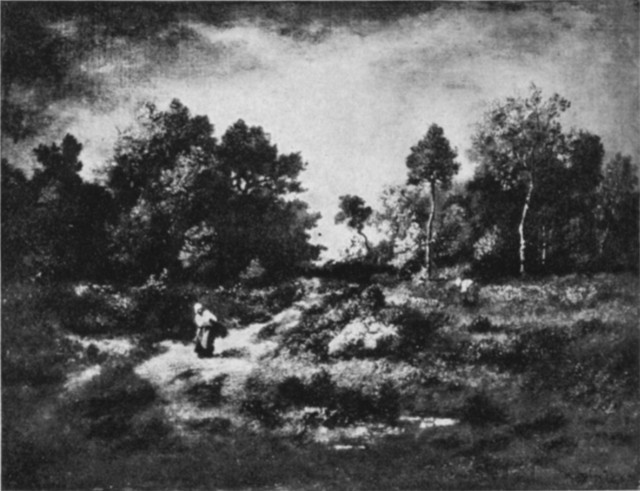
Woodland Scene. N. V. Diaz de la Pena, 1809-1879
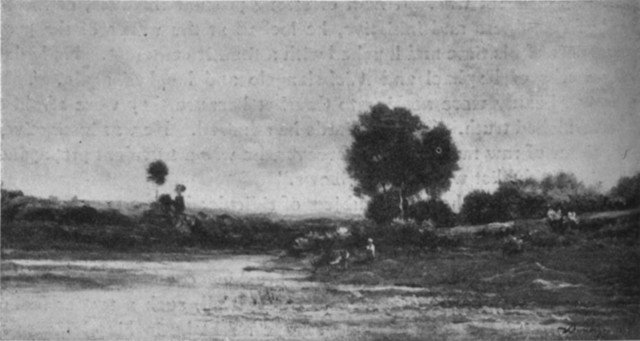
River Scene. Charles Francois Daubigny, 1817-1878
Rousseau, the founder of the Barbizon school, had the landscapes of such XVII century Hollanders as Ruisdael and of the English Constable as precedents. Diaz, one of Rousseau's followers, was fond of painting landscapes dark with sullen skies or forest shade, enlivened with bright spots where human figures are introduced or where the sun penetrates the trees. Daubigny, younger and less romantic, introduces with his freer handling, a yet more modern spirit. These two paintings are part of the memorial gift of Mrs. Frederick B. Wells. [pg 97]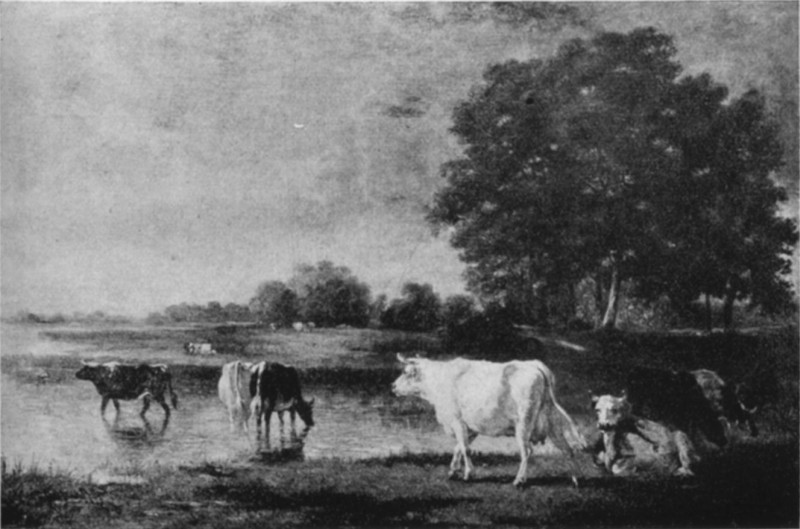
Landscape with Cattle. Constant Troyon, 1810-1865

Fording the River. Constant Troyon, 1810-1865
Troyon, a member of the Barbizon group, was fascinated by the pastoral aspect of cattle in landscapes. While Ruisdael was the principal example for Rousseau and Diaz, it was to Cuyp, the Dutch cattle painter, that Troyon went for inspiration. These two paintings are part of the bequest of Mrs. W. H. Dunwoody. [pg 98]
The Beach at Trouville. Eugene Boudin, 1824-1898
Historically, Boudin is important as a link between the Men of 1830 and the Impressionists—more specifically, between Corot and Monet. If the public and the conservatives of the Academy ignored him, his art was understood and admired by his greatest confreres. “King of the skies,” Corot called him. Courbet, after watching him paint a canvas, exclaimed, “Truly you are one of the seraphim, for you alone understand the heavens!” Monet, in a letter to him in 1889, wrote “in recognition of the advice which has made me what I am.” The modest Boudin in turn gives much credit to Corot, Courbet and Jongkind for his own insight into the subtle truths of atmosphere. Born at Honfleur, the son of a steamboat pilot, Boudin was a cabin-boy until the age of fourteen. In spare moments, he began to make sketches which revealed talent. Later he was able to devote more time to painting, although even beyond the age of fifty there were periods when he was obliged to turn day-laborer to keep himself alive. The greater part of his paintings represent scenes in Norman and Breton harbors showing quais and jetties with the bare masts of square-riggers fretted against gray skies. Some time after 1868 Isabey persuaded him to paint the fashionable watering places, and it was several years later that our Beach at Trouville must have been produced. Yet in reality his subject was always sky and atmosphere. The charm of his water, the depth and reach of his skies, with that marvelous subtlety of silvery grays, and violet grays, and leaden grays, his habit of painting always “en plein-air,” his way of using the brush, these things must indeed have influenced the younger Monet, and Monet's canvases dated around 1870 show a clear parallelism. [pg 99]
Geranium. Albert Andre, 1869-
Albert Andre is known especially for his charming flower pieces. These show the artist as a master of technique, gifted with a peculiar sensitiveness to value relations and an unusual color sense. He is particularly happy in securing an agreeable texture. He is a realist in intention, but combines truth of representation with beauty of design. In the Geranium, the emphasis is rather more upon decoration of the rectangular surface of the canvas than upon the representation of tri-dimensional form. The clear note of the salmon pink blossoms against the accompaniment of the carefully distinguished grays and the Venetian red in leaves, wall, and draperies is finely felt. Andre holds a distinguished position among painters of the contemporary French school. [pg 100]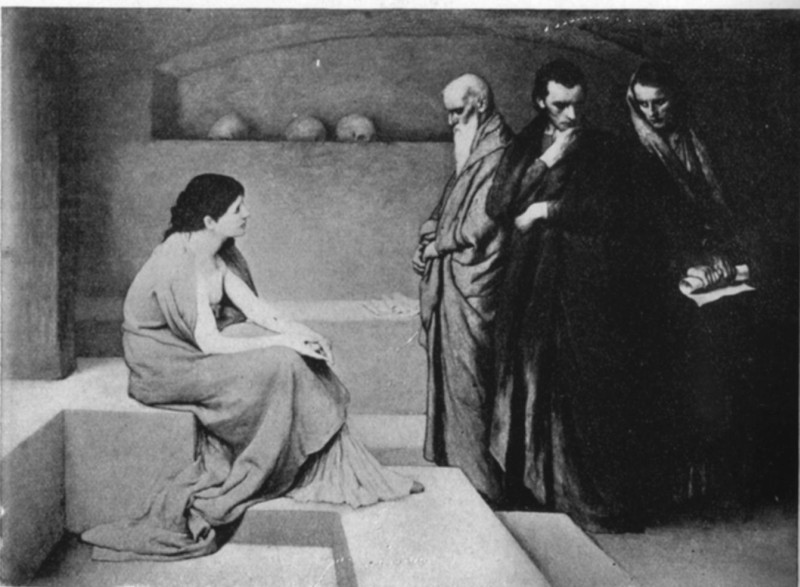
The Conversion. Gabriel Max, 1840-
The Conversion is an excellent example of the work of Gabriel Max, one of the well-known painters of Germany in the XIX century. It represents a scene apparently laid in the catacombs of Rome early in the Christian era. A woman seated on some stone steps is trying to persuade three men standing opposite her to embrace the new religion to which she has already become a convert. It is a good piece of psychological illustration. The woman's figure is painted much in the style of Bouguereau, but there is a deeper sincerity in her face, her mouth betraying the neurotic sensitiveness not uncommon among religious mystics. The group of three men is well painted and fine in color. The two nearer men seem to have been completely won over by the gentle teachings, while the young man at the right, though much moved, still resists conversion. The strong interest in the literary or illustrative aspect of the subject is characteristic of this period of painting in Germany.—Given in memory of Mrs. Thomas Lowry by Mrs. Gustav Schwyzer, Mrs. Percy Hagerman and Horace Lowry. [pg 101]
The Scouts. Adolph Schreyer, 1828-1899
The exotic quality of this painting of Arab horsemen appeals quickly to one's love of travel and romance—the great extent of the untamed surroundings, the quivering refinement of the horses, the bizarre barbarity of the costumes and accoutrements, the fascination of these fierce handsome Arab faces, the rich color of the whole! Schreyer was the German reflection of the French Orientalist-romanticists, Delacroix and Decamps, although his less fiery spirit is perhaps closer to his refined contemporary Fromentin.—Given in memory of Mrs. Thomas Lowry. [pg 102]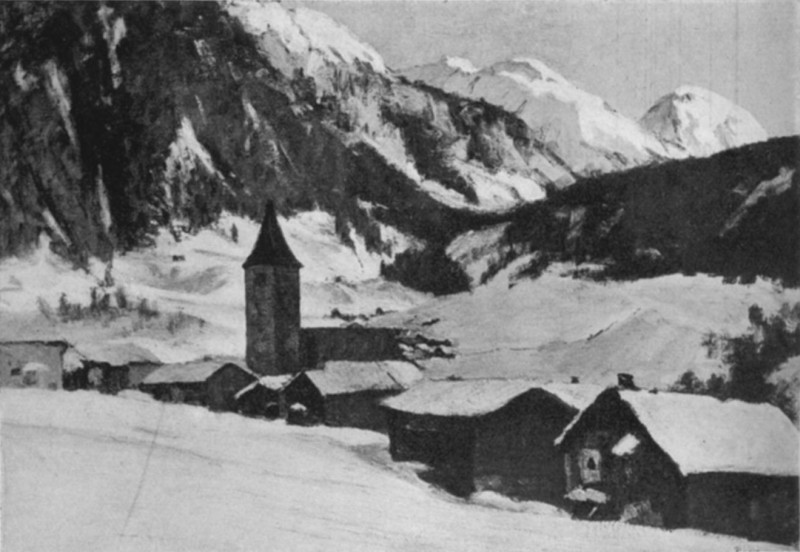
Mountain Village. Paul Crodel, 1862-
This little village is painted with a love of sunlight and color, breathes a mountain quality in the sharp, clear atmosphere. 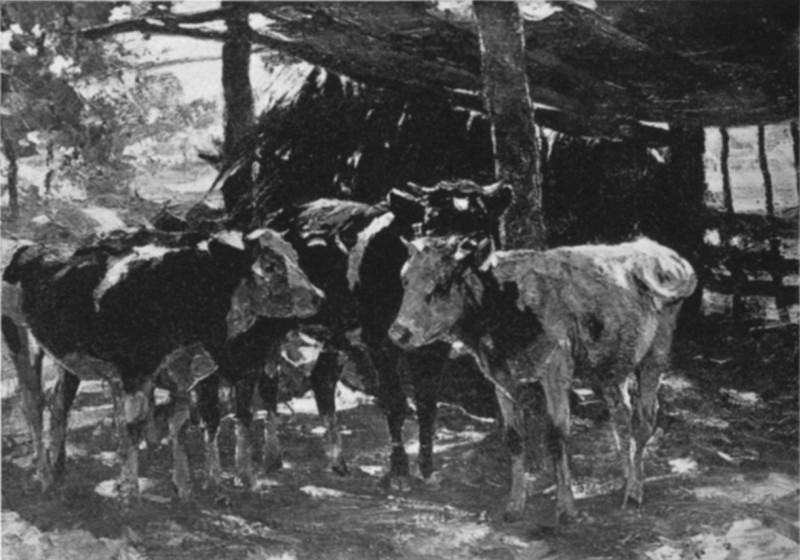
Cattle in Sunshine. Heinrich von Zugel, 1850-
Zugel shows a brilliance in his work which suggests paintings by the American Sargent. One might hunt long for a truer animal study, or for a more beautiful rendering of sunlight and beguiling purple shadow. [pg 103]
Summer Evening at the River. Gustav Adolf Fjaestad, 1870-
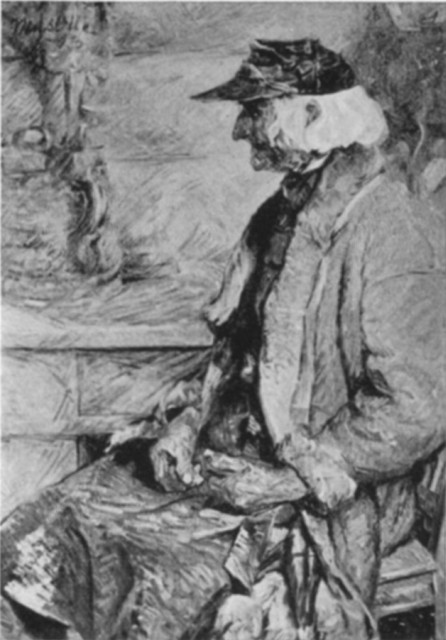
Dalecarlian Peasant. Helmer Mas-Olle, 1884-
These two paintings are the foundation of a collection belonging to the Scandinavian Art Society, and deposited in the Institute. The figure of the old peasant is instinct with character. The complex planes of the weather-beaten face and gnarled hands are established with the minimum of means. The painting by Fjaestad owes its fascination mainly to the almost Chinese sense of style and pattern. The movement of the water's swirling lines is interesting, well schemed, and perfectly balanced. [pg 104]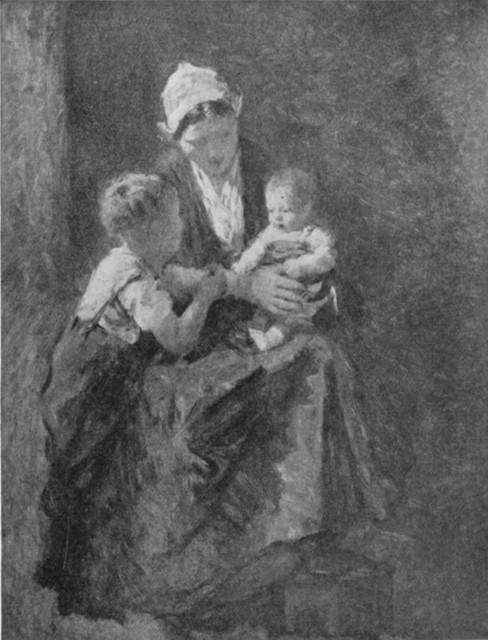
Mother and Children. Josef Israels, 1824-1911
The art of Israels, with its straightforward and sympathetic portrayal of the emotions of the common folk, makes a direct and wholesome appeal to all. Its democratic, ethical purport would have satisfied the demands of Tolstoy. Without theatricality, or morbid invention of horrible and ironic situations, he interprets the lives of poor people. The types he chooses are strong and simple. Sometimes he tenderly portrays young men and girls in the fields, or happy peasant mothers with their children, as in our painting; and when poverty or tragedy are the theme, as they in much of his later work, he sees no demoralization nor degradation—only fortitude and sadness. The spirit of man triumphs.—Gift of Mrs. Frederick B. Wells. 
On the Beach. Joaquin Sorolla y Bastida, 1863-
Sorolla, born at Valencia in the warm sunshine of southern Spain, is one of the most joyous and spontaneous artists who ever slapped paint onto canvas. The first exhibition of his work in this country was held at the Hispanic Museum in New York in 1909; and there has probably never been in America an exhibition of paintings crowded with such enthusiastic thousands of people. As one came into the exhibition gallery, one was fairly dazzled by the high key and the headlong virtuosity of the paintings which lined the walls; one felt a sense of heightened vitality. We are told that Sorolla studied in the Academies of Valencia and Rome, and finally that he was influenced by Bastien Lepage, Menzel, and by the old Spanish and Italian masters whom he copied. It is hard to think of him in connection with any such schools or painters. His bold brushwork, his unaffected and individual handling of bright sunlight, his high animal spirits, are like no other painter we know, unless it be the Scandinavian Zorn. The subjects chosen by Sorolla are varied. He paints fashionable portraits, and occasionally landscape. Mostly he paints scenes on the sunny Mediterranean shores of Spain. Into these he introduces figures, sometimes subordinated to the sea, more often as the principal interest of the picture. Sometimes he shows fishermen working at their boats, as in the stunning canvas in the Metropolitan Museum. When he does, they are no bent-backed toilers, but joyous, active, triumphant creatures. More often Sorolla loves to paint people playing on the beach, their light clothes spotted cleverly against the bright sand or waves; or best of all, children! Healthy and full of vivid glee, they race along the beach, lie on the sand in the wash of reaching breakers, or swim frog-like in the green transparency of sheltered water. [pg 106]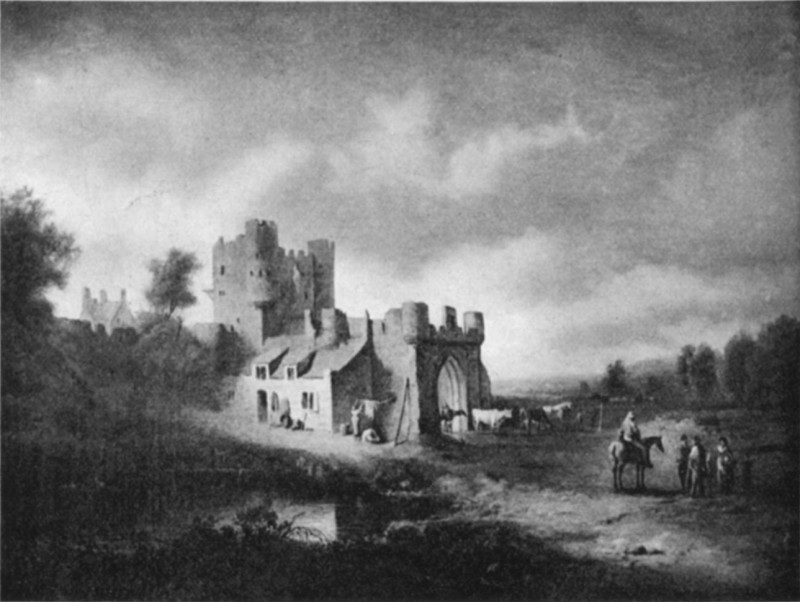
Landscape. Alexander Nasmyth, 1758-1840
This landscape by the Scotch painter, Alexander Nasmyth, is so unobtrusive as to be easily overlooked by the visitor. For those who feel the spirit of the little picture, however, it has an abiding charm. The artist was a man of extraordinary versatility and enterprise, an able scene painter and architect, and an inventor and engineer of eminence. In our painting one sees little of the boldness expected from a mind given credit for originating principles of steamboat propulsion and bridge construction. The touch is formal, almost shy, in its reserve; the drawing is precise, and the lighting and color conventional. Much of the charm of the work is probably due to this reticence. The scene presents a restful tranquility, and a quaint homeliness. The interest plays back and forth between the romantic old ruin and the contrasting rural and domestic life which has put past splendors to such strange modern uses. The theme is reminiscent of Piranesi's etchings of classical ruins. Out of death springs life; from the decayed tree come strange fungus growths. After hundreds of years, the castle wall of a feudal lord gives support to a peasant cottage; his hall serves to shelter cattle. Alexander Nasmyth was a pupil of the portraitist, Allan Ramsay (1713-1784). Ramsay discovered him in Edinburgh painting armorial bearings on carriage doors, and took him to London. Upon his return to Edinburgh, he painted portraits, including a famous portrait of Robert Burns; but turned his attention, after 1793, exclusively to landscapes. [pg 107]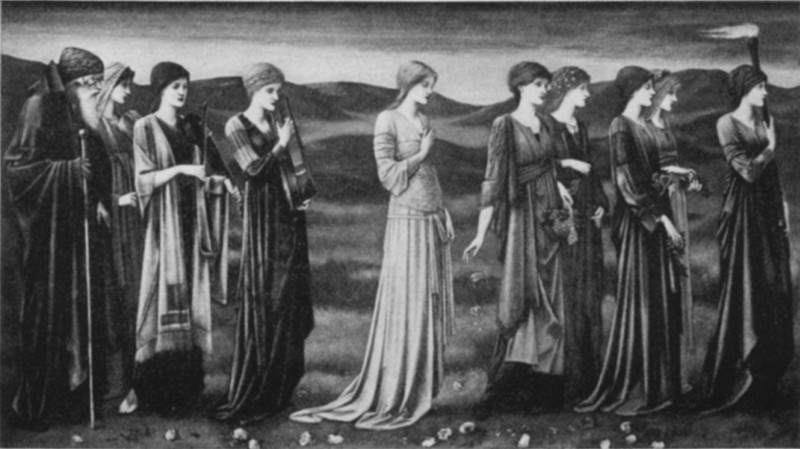
Psyche's Wedding. Sir Edward Burne-Jones, 1833-1898
The story of Psyche's Wedding is a myth of Greek origin, and runs as follows: A certain king in the west country had three beautiful daughters. The youngest was by far the most beautiful; so beautiful, indeed, that she received homage from men which was due to Venus alone. The anger of the goddess was aroused against her, and the maiden herself became unhappy because, due to her awesome beauty, no one sought her in marriage. The King, her father, inquired of the Oracle of Apollo what should be done. The story is told in Walter Pater's Marius the Epicurean, from which the following extract is taken: “And Apollo answered him thus: ‘Let the damsel be placed on the top of a certain mountain, adorned as for the bed of marriage and of death. Look not for a son-in-law of mortal birth but for that evil serpent-thing by reason of whom even the gods tremble and the shades of Styx are afraid.’ So the king returned home and made known the oracle to his wife. For many days she lamented, but at last the fulfillment of the divine precept is urgent upon her, and the company make ready to conduct the maiden to her deadly bridal. And now the nuptial torch gathers dark smoke and ashes, the pleasant sound of the pipe is changed into a cry, the marriage hymn concludes in a sorrowful wailing, below her yellow wedding veil, the bride shook away her tears; insomuch that the whole city was afflicted together at the ill-luck of the stricken household.... she was silent, and with firm step went on her way, and they proceeded to the appointed place on a steep mountain and left there the maiden alone and took their way homeward dejectedly.” It was Cupid, however, not a monster, who welcomed the sorrowful maiden, and after many adventures, Psyche found happiness. [pg 108]
Silver and Green. Hilda Fearon, English, ?-1917
In this cheerful painting, representing two little girls seated at a breakfast table flooded with the bright, clear light of a summer morning, the real theme which has engaged the artist is nothing more nor less than light itself. The tablecloth and window curtains half in sunlight, half in luminous shadow, and the shining glassware and silver urn are ably painted. The green of the garden and the yellow-green of sundrenched lawn are seen through the window echoed in the interior by daffodills, lemons and lime juice bottle, while happy touches of blue appear in the china and one of the frocks. Silver and Green was painted 1913, and was awarded Honorable Mention at the International Exhibition in Pittsburg in 1914. MODERN DRAWINGS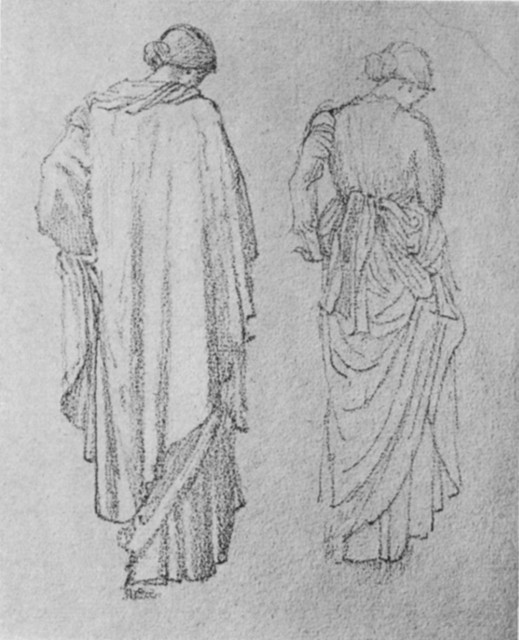
Studies of Draped Figures, Pencil Drawing. Sir Edward Burne-Jones, English, 1833-1898
Our Burne-Jones sketch book belonged formerly to the artist's son, Sir Philip Burne-Jones. In a letter Sir Philip writes: “This book of studies and designs by my father is an important example of his work and methods. Before starting upon the actual painting of a large composition, it was my father's custom to make innumerable careful studies of limbs, draperies, etc., in chalk and pencil, and from these he worked upon the picture. The book which is now in your possession exemplifies this system.” The sketch book contains 113 original drawings. Some of these are on both sides of a leaf, and frequently two or more drawings on a page. For the greater part, they are executed in lead pencil, although several of the most interesting are in colored chalk. Sir Edward Burne-Jones was a member of the Pre-Raphaelite Brotherhood, which sought to displace the conventionality of English art of the period by detailed naturalism and the mystical sincerity of the Italian primitives. [pg 110]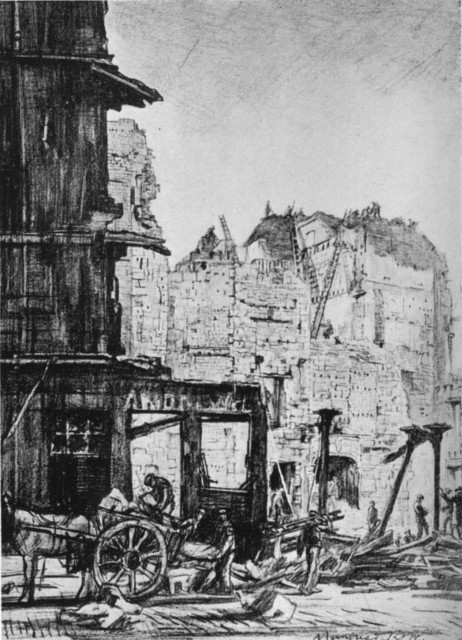
Fire in Ingram Street, Pencil Drawing. Muirhead Bone, Scotch, 1876-
What can be done with lead pencil by a man who has sureness of hand and the power of rapid decision is shown in this fine characterization, in light and shade, of the ruins of a row of buildings that remain in desolation after fire has spent its fury. [pg 111]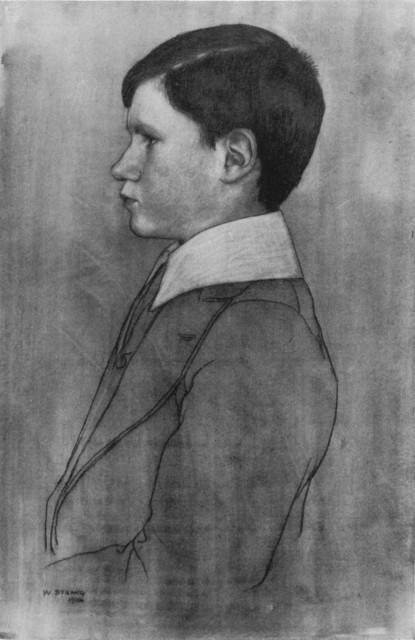
Portrait, Drawing in Chalk and Wash. William Strang, Scotch, 1859-
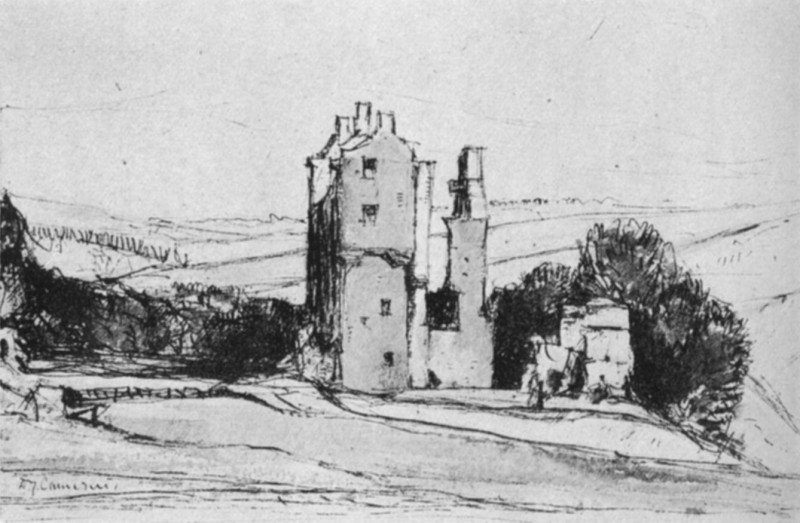
Mucherach Castle, Drawing in Pen and Wash. David Young Cameron, Scotch, 1865-
Cameron's fine emotional quality would be inexpressible without his sure draughtsmanship and power to compose. Wedmore writes of Cameron: “He is certainly, of living British etchers, the one whose work excites among the generally cultivated public the keenest curiosity and evokes the highest admiration.” 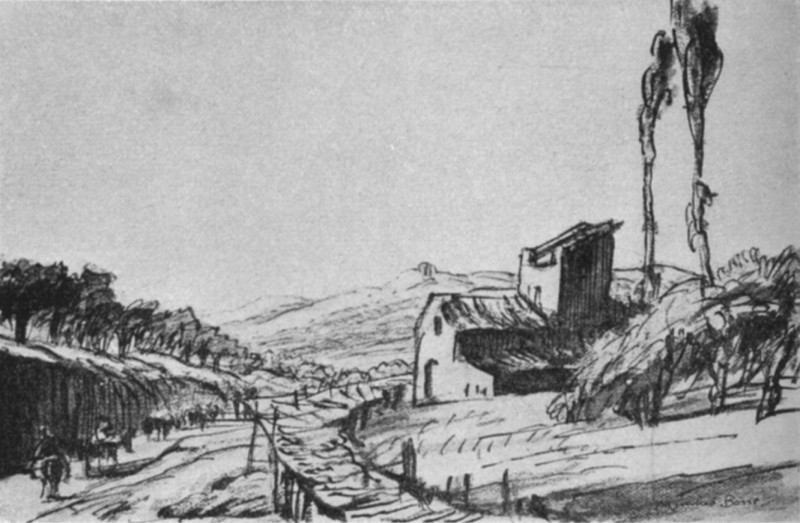
Tuscan Landscape, Drawing in Pen and Wash. Muirhead Bone, Scotch, 1876-

Study for an Illustration, Drawing in Lithographic Crayon. Theophile Alexandre Steinlen, French, 1859-
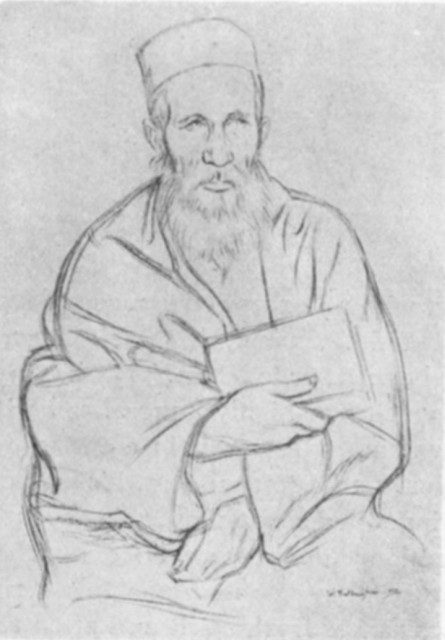
An Old Rabbi, Pencil Drawing. William Rothenstein, English, 1872-
MODERN SCULPTURE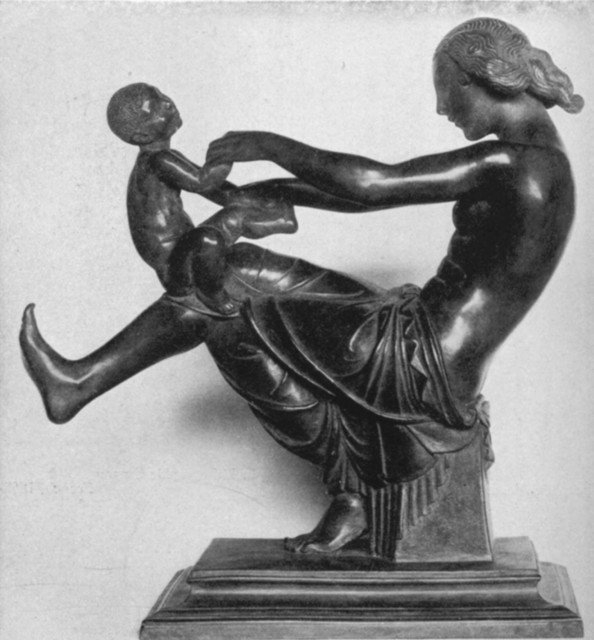
Playfulness. Paul Manship, 1885-
Gifted, as he is, with an exceptional sense of style, the young American sculptor, Paul Manship, has well deserved the prizes and praises which have been awarded him. He has a genius for the construction of forms which are highly generalized without thereby losing compactness and vivacity. His power in creating designs that are alive is hardly more original and personal than his use of antique and exotic formulae in rendering details such as hair, eyes and draperies. For, though these conventions are borrowed from archaic Greek, Assyrian, and Japanese sculpture, they are in Manship's art perfectly assimilated and put to novel uses full of fresh spirit and often touched with an elfish humor. [pg 115 ]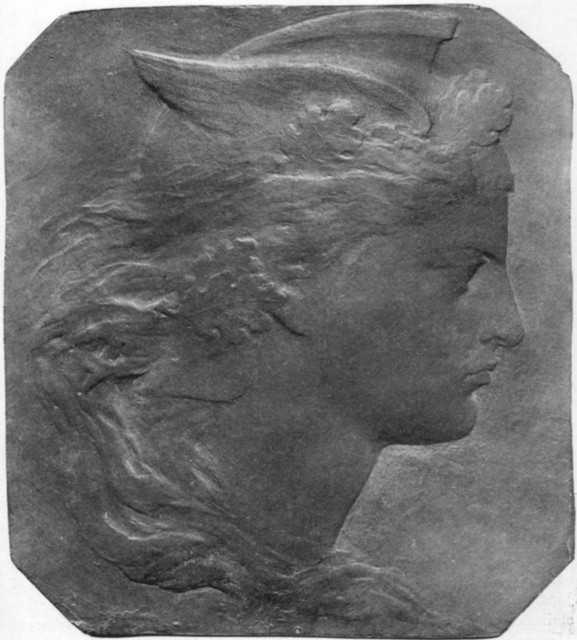
Plaque, La Guerre. Hubert Ponscarme, 1827-1903
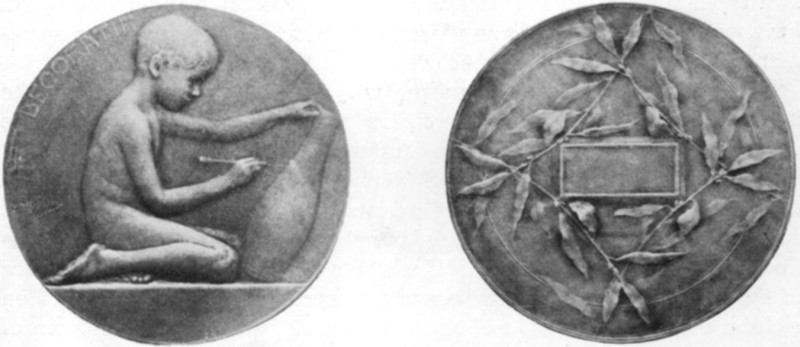
Medal, L'Art Decorative, by Ovide Yencesse, 1869-
THE BRADSTREET ROOM
A Corner of the Room
In accordance with wishes expressed by the late John Scott Bradstreet, who was deeply interested in the work of the Society of Fine Arts, his sisters, Mrs. Elizabeth B. Carleton and Mrs. Margaret Kimball, at the opening of the new building, presented to the Society a collection of Japanese objects collected by Mr. Bradstreet, and arranged for the installation of them in the gallery now known as the John Scott Bradstreet Memorial Room. The room is much appreciated by visitors to the Institute. Restful and marked by delightful harmony of color and form, it is a room such as all the friends of Mr. Bradstreet feel sure he would have approved, if he had been spared to witness the success of the movement for which he cared so much. The visitor, entering the gallery, will probably notice first of all the large bronze bowl with a dragon coiling about the base, exhibited in the center of the room. On the right-hand wall, the central space is occupied by a large cupboard of sugi wood (Japanese cedar). The sliding doors are decorated with a continuous design of blossoming plum branches. Above the cabinet, on four panels, is painted a splendid design of lotus flowers and leaves in green, black, white, and gold on the natural surface of the wood. A stone garden ornament representing a cock perched on a drum stands to the right of the cupboard. To the left is a screen of [pg 117] carved wood, topped by the upward curving horizontal, symbol of Shintoism, and decorated by delightfully fantastic carvings showing kylins among cloud scrolls. Against the wall opposite the door stands an elaborate temple table covered with gold lacquer and decorations in color, including a band, beneath the top, of pleasing little panels in pierced carving based on bird and flower motives. On the left-hand side of the room are two cabinets made of richly grained sugi, the sliding doors decorated with painted lotus and crysanthemum designs. On the cabinets stand a musical instrument, a carved wood Buddha of benignly spiritual expression, and other objects. On the wall are two carved wood panels and a few woodblock prints of the early XIX century. A case contains some rich examples of brocade, including two priest's robes. Near the door hangs a bronze portrait relief of Mr. Bradstreet, which was executed by Paul Fjelde, the son of Jacob Fjelde, known to the people of Minneapolis through his statues of Ole Bull and Hiawatha. It is the gift of about one hundred of Mr. Bradstreet's friends. The portrait is modeled in low relief, and the decorative element of the Japanese tree introduced on one side suggests Mr. Bradstreet's fondness for Oriental Art. The relief has received high commendation both as a likeness and as a work of art. 
Color Print. Yeizan, flourished 1800-1830

Carved Panel. XVIII Century
Artist Index ==--==--== |
==++==++== |